- Summarize PowerPoints with AI
- Summarize Word documents with AI
- Summarize PDF with AI
- Generate PowerPoints with AI from text
- Create Presentation with AI
- GPT for Presentations
- Create Presentations from Website with AI
- Chat with Document Groups
- Import files from Cloud
- Request Demo
- May 13, 2024
- Comments Off on How to create PowerPoint from Excel
- Artificial Intelligence
- How to create PowerPoint from Excel
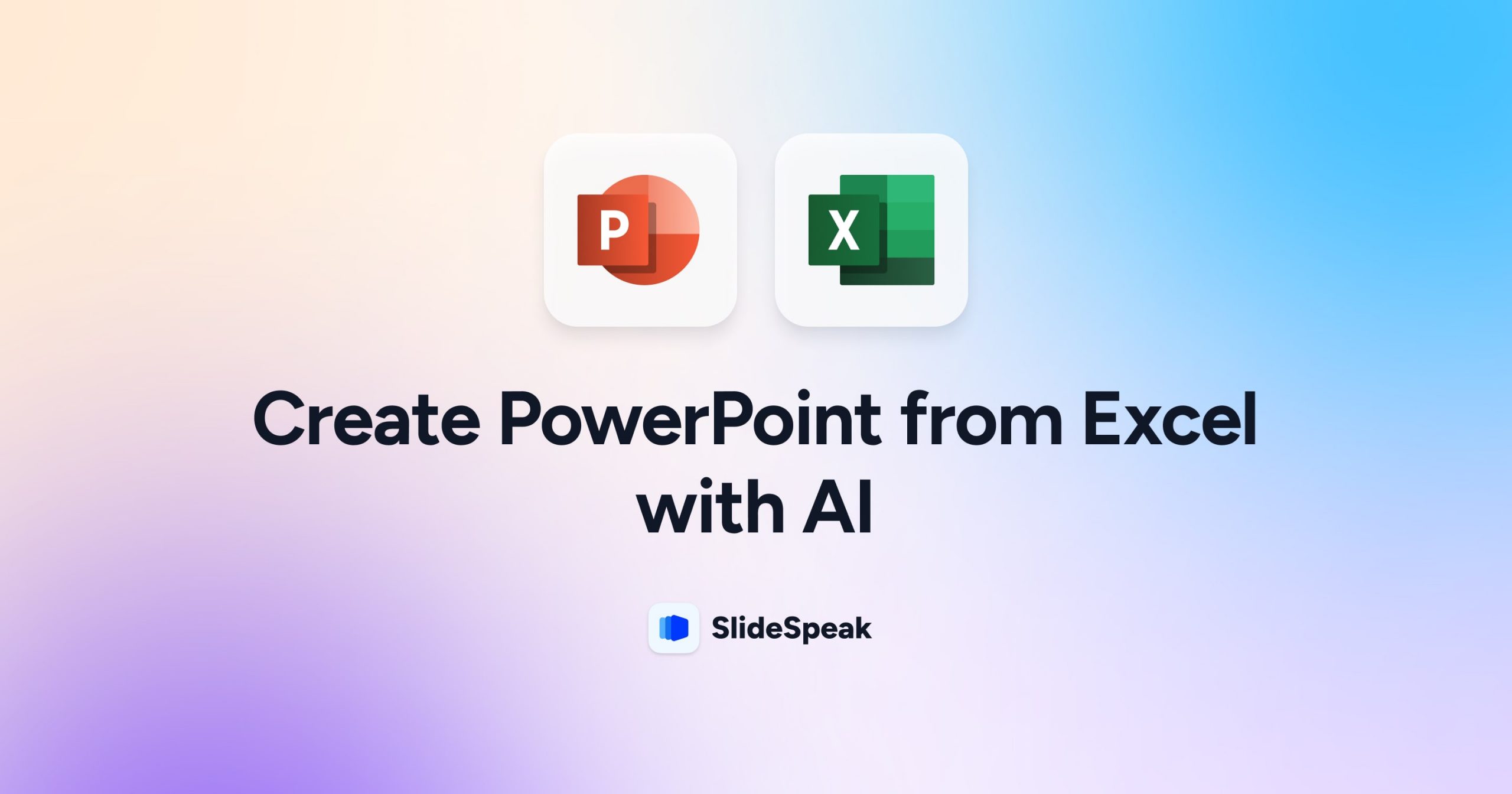
Creating PowerPoint presentations is essential for sharing ideas and results in business. Creating these presentations can be challenging and time-consuming (especially if integrating Excel data is needed). It involves researching, organizing information, and deciding how to present key points clearly. Designing presentation slides that are visually appealing and adding graphs, charts and tables can further complicate the process. Wouldn’t it be nice to create PowerPoints from Excel with just a few clicks? 👀
It’s very common for consultants, marketing managers or other people to create PowerPoints from Excel data. This can include data like statistics, research findings, or forecasts in your presentations, which might be stored in Excel files. Manually transferring this XLS data to create graphs and charts is a lot of work. Thankfully, Artificial Intelligence (AI) can help simplify this task. AI tools can automatically turn Excel (XLS) data into PowerPoint slides. This is especially useful for consultants and professionals in various fields who need to present complex data efficiently.
There are two types of tools that allow you to create PowerPoint presentations from Excel automatically:
- Tools that directly generate completed PowerPoint presentations.
- Tools that create presentation content that you then need to copy manually.
In this blog post, we’ll cover how to create PowerPoint from Excel using both types of tools (both powered by AI). As a test example, we will use an Excel file containing data on changes in the US population by state from 1910 to 2020.
Note: The file was downloaded from the US Department of Commerce: https://www2.census.gov/programs-surveys/decennial/2020/data/apportionment/population-change-data-table.xlsx
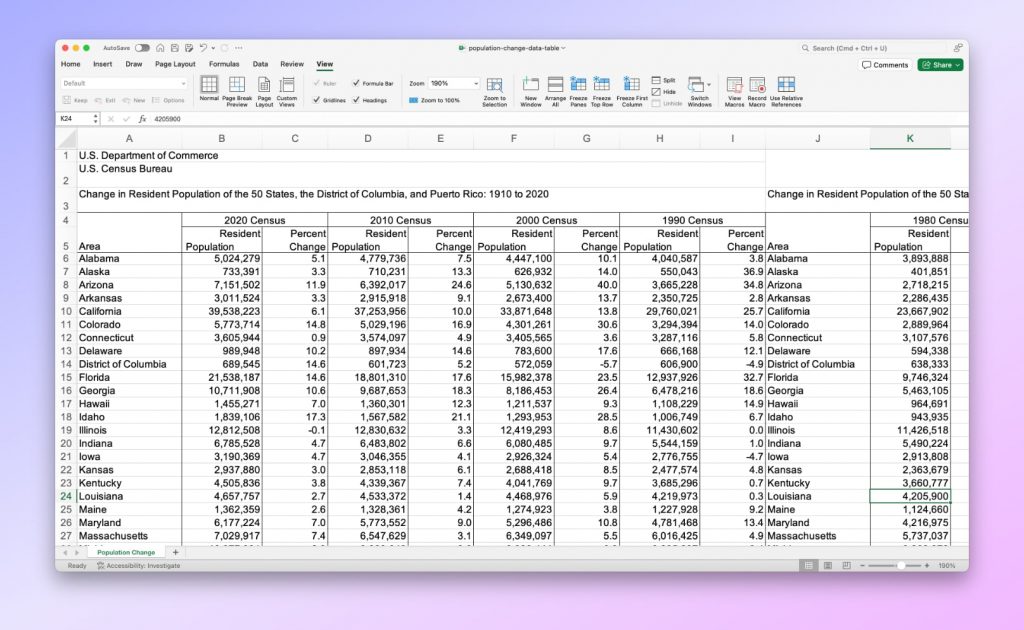
We’ll explore tools like SlideSpeak, Microsoft Copilot, Beautiful.ai, and ChatGPT and provide a comprehensive guide on leveraging their functionalities to create impactful presentations. Additionally, we’ll list the pros and cons of each tool so that you can make informed decisions based on your specific needs and preferences.

Method 1: Generating PPT from XLSX using SlideSpeak
Website: https://slidespeak.co
SlideSpeak is a powerful AI tool that allows you to automatically convert PDF, Word, and XLSX files into ready-made beautiful presentations in minutes.
To generate a presentation from an Excel (XLS) file using SlideSpeak, you need to perform the following steps:
- Select the Excel file: select the file based on which you want to create a presentation.
- Upload the file: upload the file to SlideSpeak.
- Preview data: preview the uploaded data in SlideSpeak. You can also ask it questions about the uploaded data.
- Create a presentation: select the necessary parameters and start the process of creating the presentation.
- Review the table of contents: review the presentation’s table of contents that SlideSpeak suggests.
- Select a template: choose a presentation template.
- Review the presentation: review and download the finished presentation.
Step 1: Select the Excel file
Open SlideSpeak . Drag the Excel file from which you want to create a presentation into the box in the center of the screen, or upload this file using the Click to upload button.
Step 2: Upload a file
To upload a file, click the Upload button under the file name and wait a little.
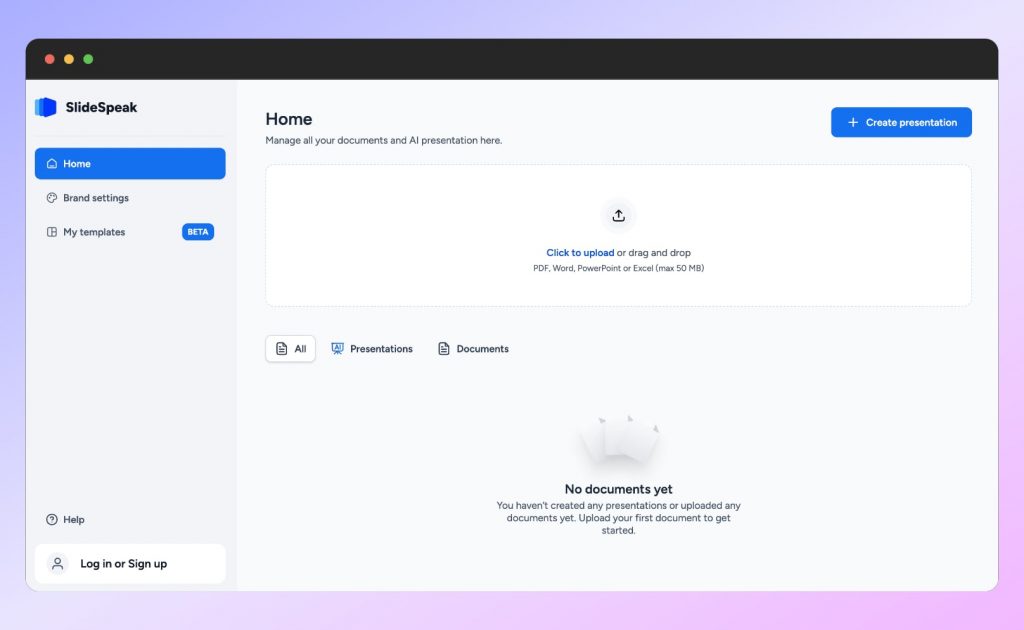
Step 3: Preview data
After loading the data, it will be displayed on the screen. You can now also ask SlideSpeak questions about the uploaded data.
To start the process of creating a presentation, click the Create Presentation button in the upper right corner.
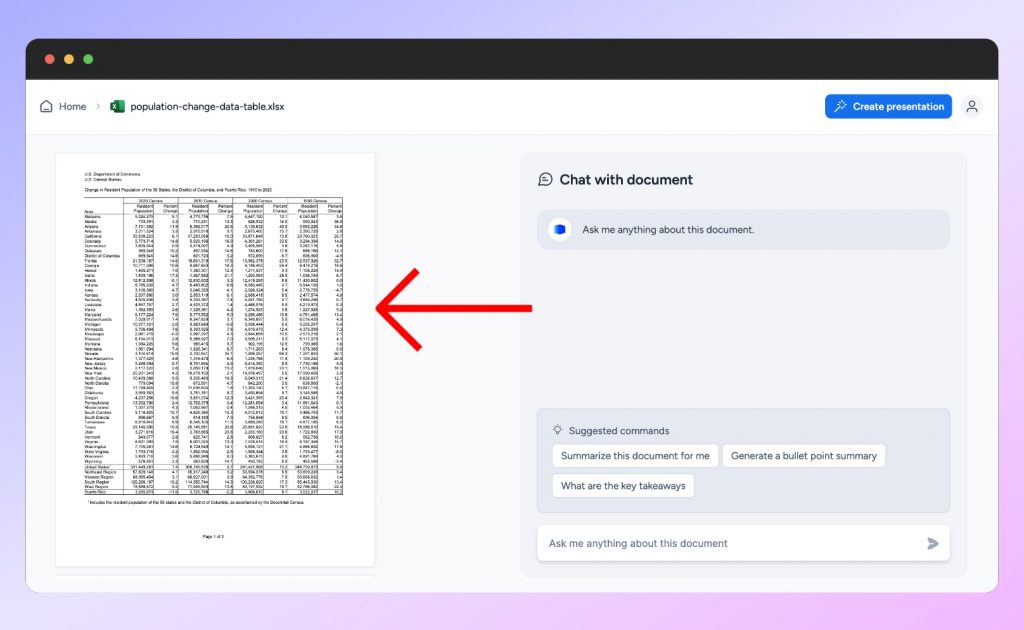
Step 4: Create a presentation
After starting the presentation generation process for your Excel file, SlideSpeak asks you to configure some presentation parameters. You can choose the desired number of slides, presentation language, and tone. In addition, you can add stock images to the presentation.
If you use the premium version of SlideSpeak, you can also use the brand logo, color, and fonts.
After setting all the presentation’s parameters, click the Next button at the bottom of the page and wait a few minutes for the presentation to be generated.
Step 5: Review the table of contents
Based on the data from the Excel file, SlideSpeak creates content for the presentation. Review it, and if you are satisfied with it, click the Next button to proceed to the next step of generating the presentation.
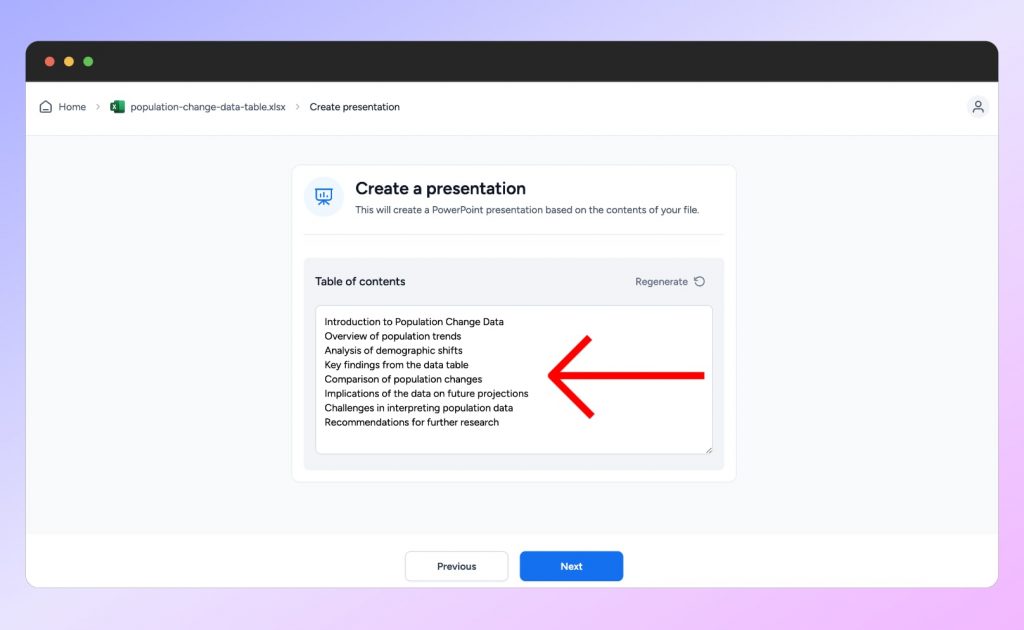
Step 6: Select a template
At this step, you will be prompted to choose a presentation template. Select one of the default templates or upload your own and click the Generate button. The presentation will be ready in a few minutes.
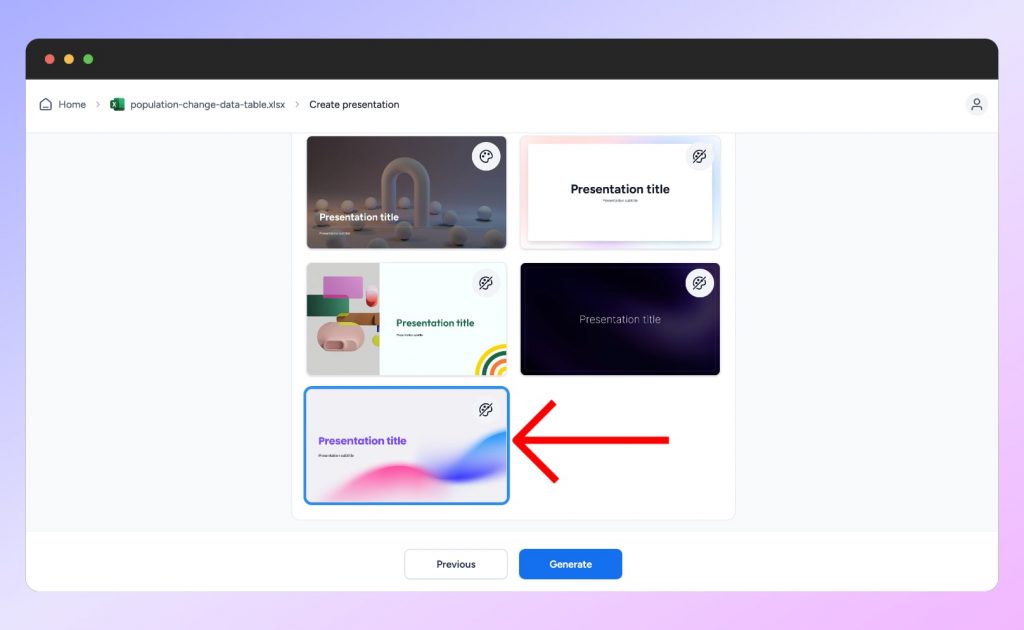
Step 7: Review the presentation
You can now review the finished presentation. Users with a paid subscription can also regenerate the presentation and download it as a PDF or PowerPoint file.
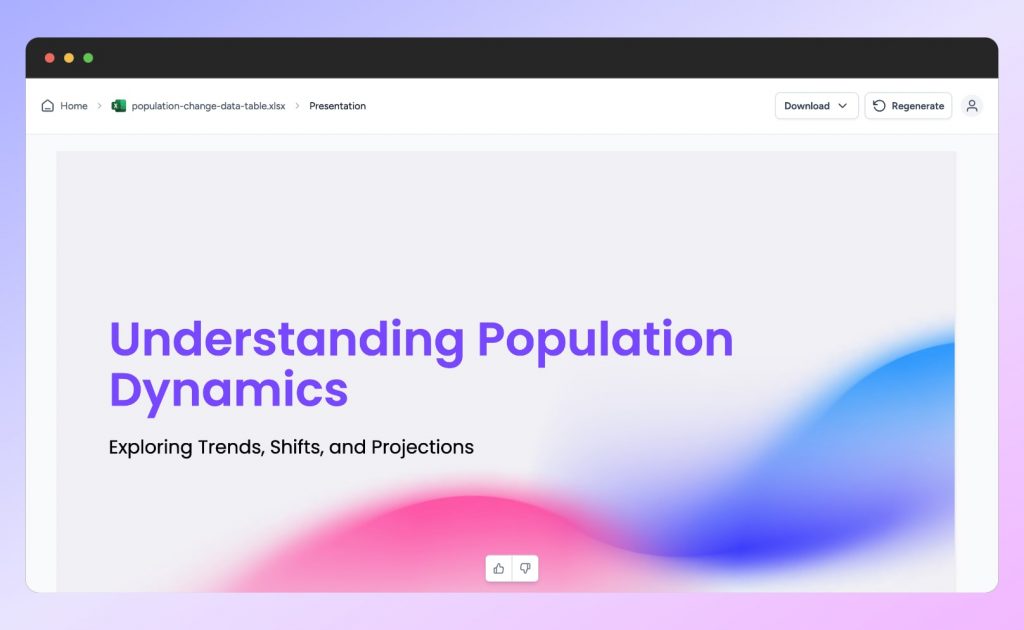
Pros and cons
- The ability to upload an Excel file to SlideSpeak without the need for manual copying and pasting;
- User-friendly interface;
- Automated and quick presentation generation process;
- Ability to customize the presentation according to the user’s needs and preferences;
- Ability to choose the presentation language;
- Additional features are available for users with a paid subscription.
- Limited customization options;
- There is no possibility to edit the finished presentation;
- Unlimited use requires a paid subscription.
SlideSpeak is a convenient and fast tool that allows you to automatically create PowerPoint from Excel. However, if you prefer to set up the presentation manually, you may miss some functionality. Therefore, before choosing a tool for creating presentations, it is important to define your needs and analyze the tool’s capabilities.
Method 2: Create PowerPoint from Excel using MS Copilot
Website: https://copilot.microsoft.com/
Microsoft Copilot is an AI-powered tool that integrates with Microsoft PowerPoint. Using advanced natural language processing techniques, it can summarize documents, generate content, and answer questions about content.
Copilot uses advanced AI to let you quickly create presentations based on the provided Excel data. Given that AI is not 100% accurate, you may need to manually edit the presentation after it is automatically generated. However, Copilot can do most of the hard work and significantly speed up the process to create a presentation. It is important to note that you need a paid subscription to use Copilot in PowerPoint.
Here is a brief overview of how to create PowerPoint from Excel using MS Copilot.
- Open Microsoft Copilot in PowerPoint: create a presentation and open the Copilot toolbar.
- Insert data into Copilot in PowerPoint: copy the data from your Excel file and insert it into Copilot.
- Review the presentation: generate and, if necessary, edit the presentation.
Step 1: Open Microsoft Copilot in PowerPoint
Create a new presentation in PowerPoint and click the Copilot button on the right side of the toolbar. A Copilot panel will then appear on the right. The Copilot button is only available to users with a paid Copilot subscription.
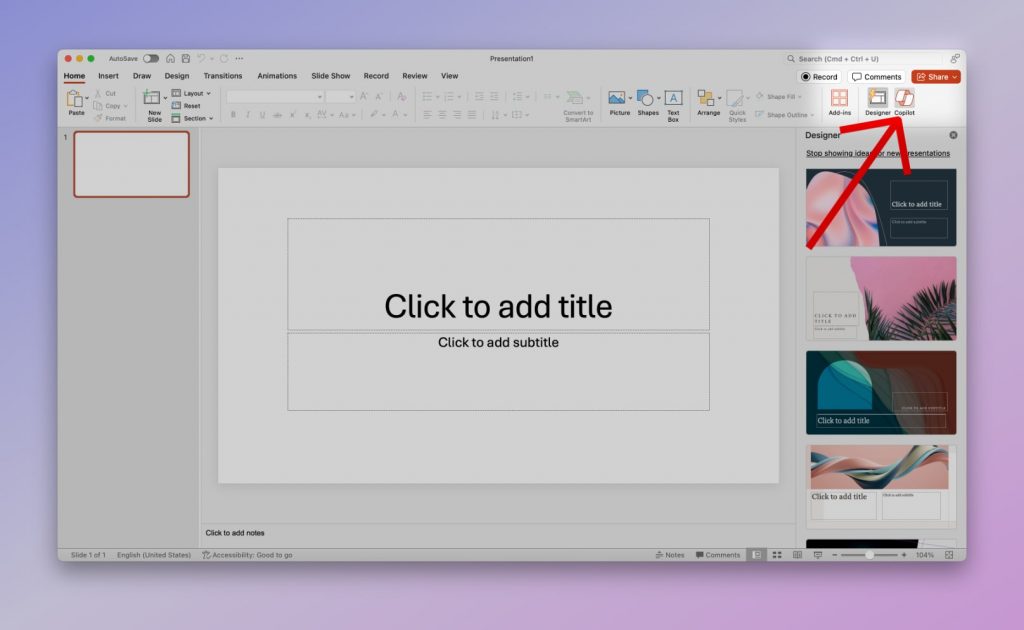
Step 2: Insert data into Copilot in PowerPoint
Unfortunately, Copilot does not allow you to upload an Excel file. Therefore, you need to copy the data from your Excel file and paste it into the Copilot chat to generate a presentation. Write the following command in Copilot: “Create a presentation using the following data” and paste the data copied from Excel. However, in Copilot at the moment, the maximum length of a request is 2000 characters. Therefore, when you try to insert data from a large Excel sheet, excess data is cut off and not considered during presentation generation.
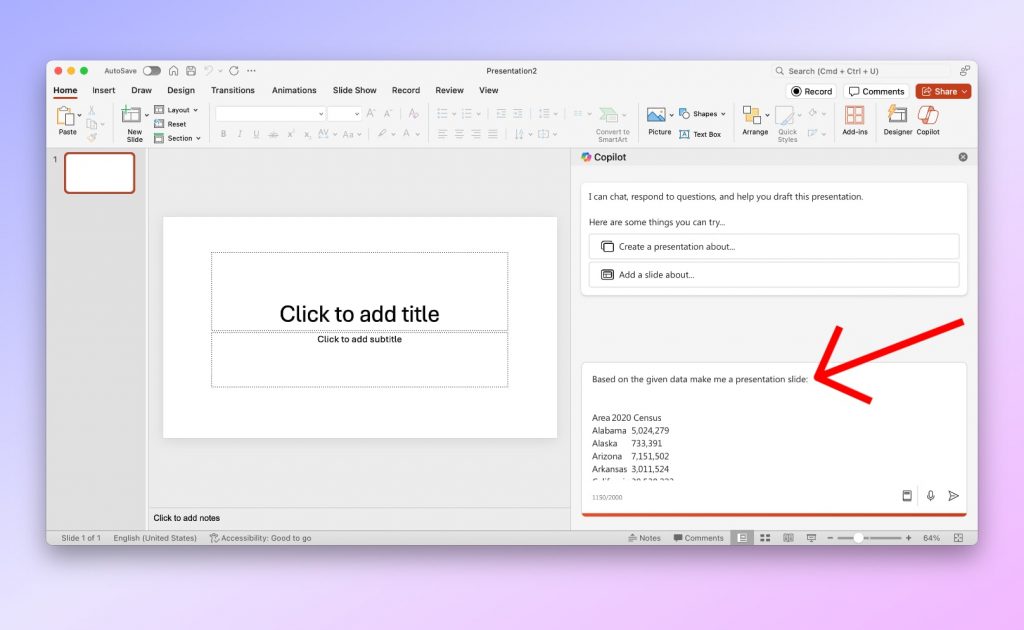
Step 3: Review the presentation
Wait a few minutes, and the presentation will be generated and displayed on the screen. You can edit the finished presentation, change the design and text, add slides, and more.
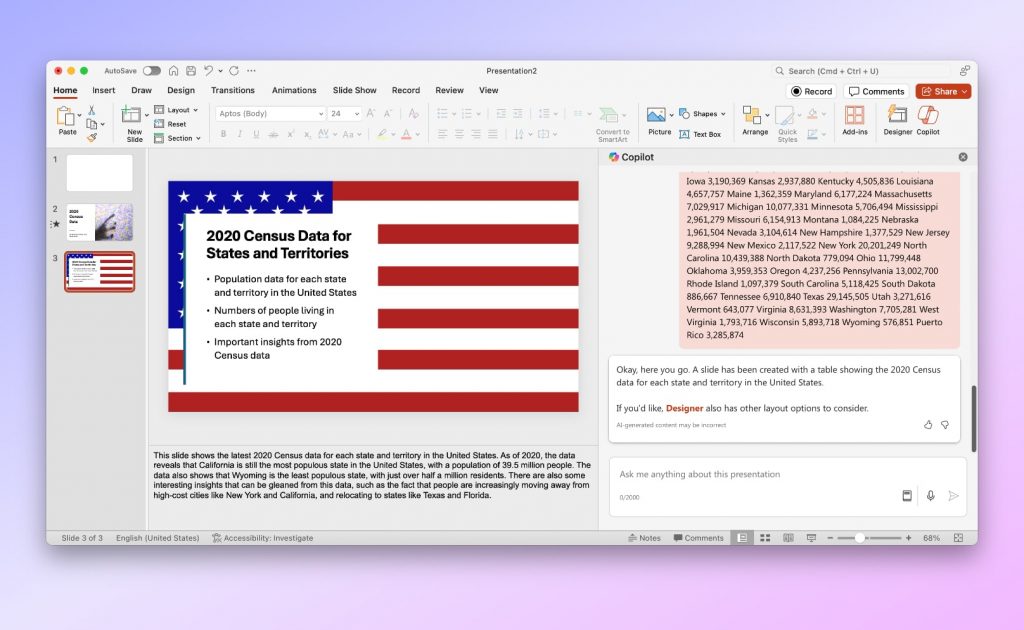
In our experience the results based on copy pasted data from Excel were very poor in quality. So we decide to use Excel Copilot to see if it can create us some nice charts from our Excel file that we can then copy over into our PowerPoint presentation.
Step 4: Generate charts using Copilot in Excel
As you can see from the slides, Copilot in PowerPoint creates text analysis of the data and inserts images associated with the data into the presentation. However, if you want to automatically generate charts based on Excel data, you can do this using Copilot in Excel.
Open Copilot in Excel by clicking the Copilot button on the right of the toolbar.
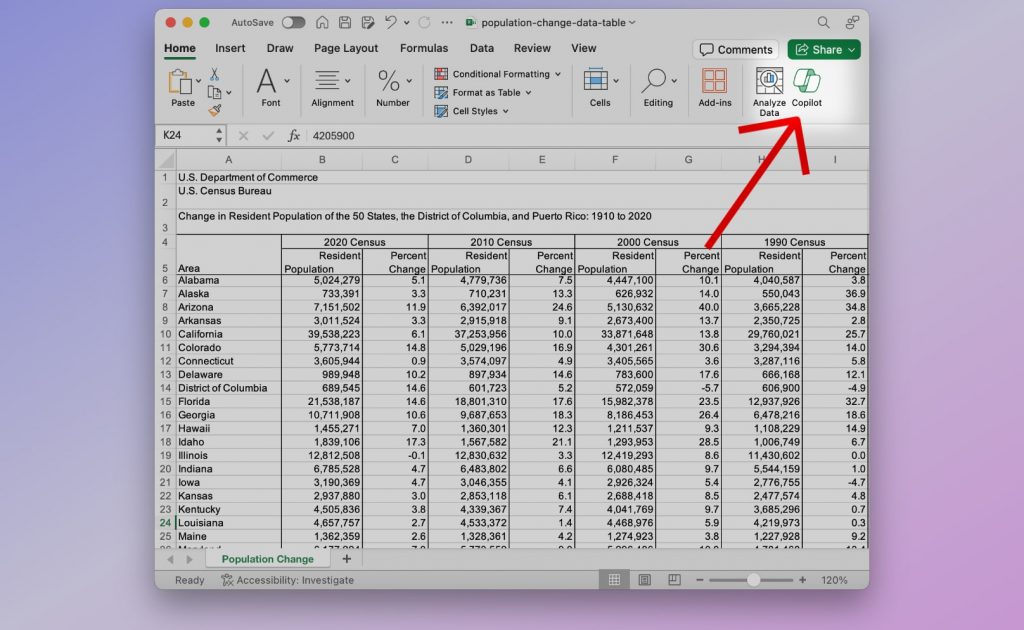
Select a table with data and write the following request in the Copilot chat: “Create a chart that shows the dynamics of population change in different states”. Wait for the chart to be generated. Then click the “ Add to a new sheet ” or “Insert PivotChart” button to insert the chart into a new Excel sheet.
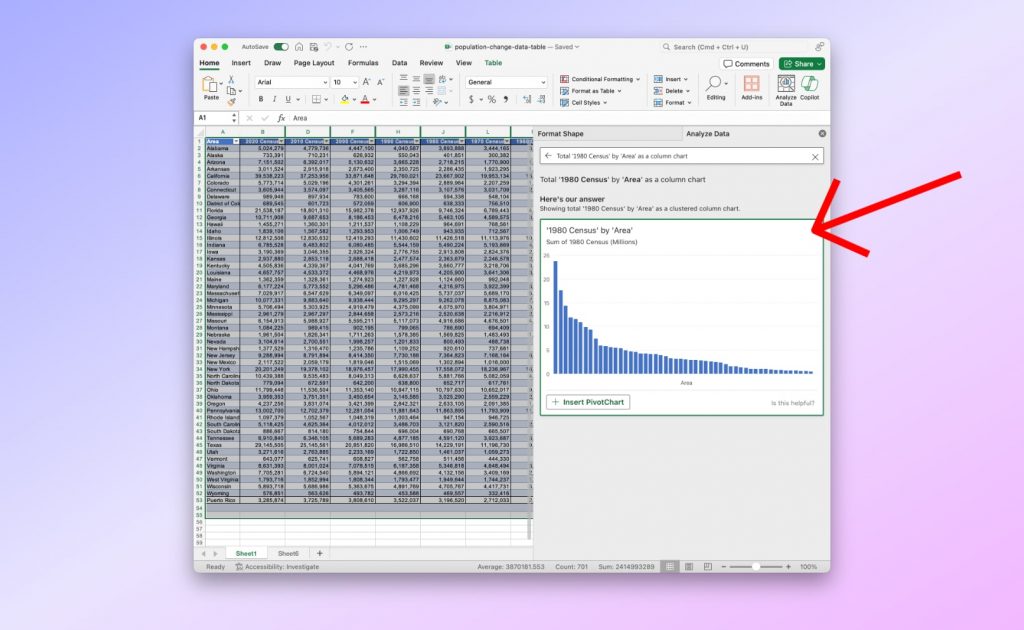
After the chart opens in a new Excel sheet, you can edit it by adding new columns. Once the chart is ready, copy it into your PowerPoint presentation.
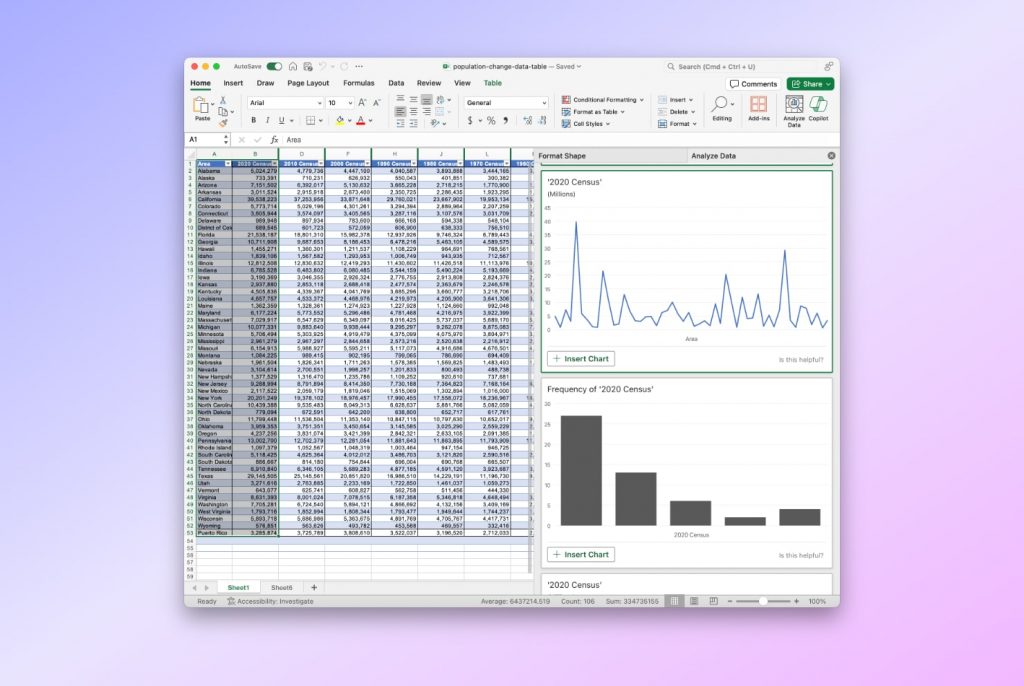
Pros and Cons
- Increasing the efficiency and productivity of creating presentations;
- Smart suggestions for slide layout based on analysis of its content;
- The ability to automatically generate charts;
- Wide possibilities for customization of the finished presentation.
- A paid subscription is required;
- Security and privacy risks of providing data access to an AI cloud service;
- The maximum length of the request is 2000 characters;
- The presentation may contain incorrect data as AI is not 100% accurate.
Copilot can fast and easily create PowerPoint from Excel. It also provides intelligent advice on the presentation’s content and design. However, users may still miss advanced features like the possibility of uploading Excel files. Additionally, a paid subscription is required even to use the limited features of Copilot.
Method 3: Create Presentation from Excel using Beautiful.ai
Website: https://www.beautiful.ai/
Beautiful.ai is cloud-based AI-powered presentation generation software. It provides customers with many professionally designed templates, layouts, and design elements that can be customized to match customers’ content and brand. Beautiful.ai simplifies and speeds up the process of creating visually attractive presentations. It saves users time and effort with design assistance and intuitive AI-driven tools.
Beautiful.ai is a paid tool, so you need to create an account and subscribe before you can get started. You can use a 14-day trial version for the preliminary study.
Below is a quick overview of the steps needed to create PowerPoint from Excel using Beautiful.ai.
- Open Beautiful.ai: go to Beautiful.ai and create a new presentation.
- Load data: load data from an Excel file into Beautiful.ai.
- Generate a presentation: check the uploaded data and initiate the process of creating the presentation.
- Review presentation: review and, if necessary, edit the finished presentation.
Step 1: Open Beautiful.ai
Open Beautiful.ai and ensure you are logged in to your account and have a subscription. After that, on the left side of the page, click Create Presentation -> Generate with AI .
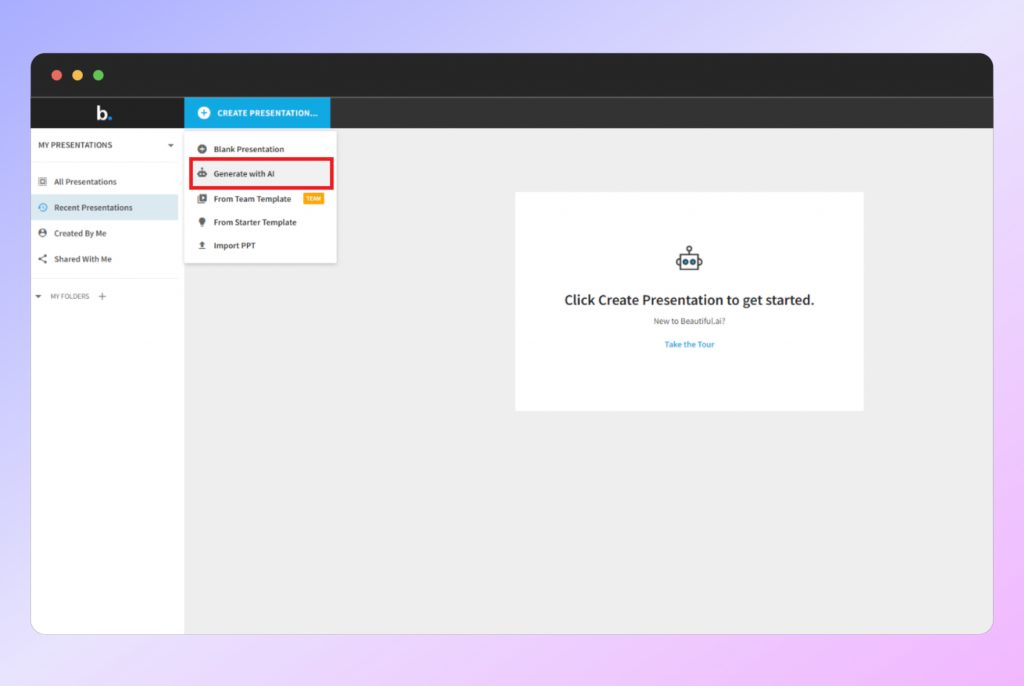
Step 2: Load data
At this step, you need to enter the presentation topic and upload data from Excel. Enter your presentation topic in the text box at the top of the page. After that, click on the Train AI with Additional Context button and select the data input method. Beautiful.ai does not provide the function of uploading Excel files, so in the drop-down list, select the Text option.
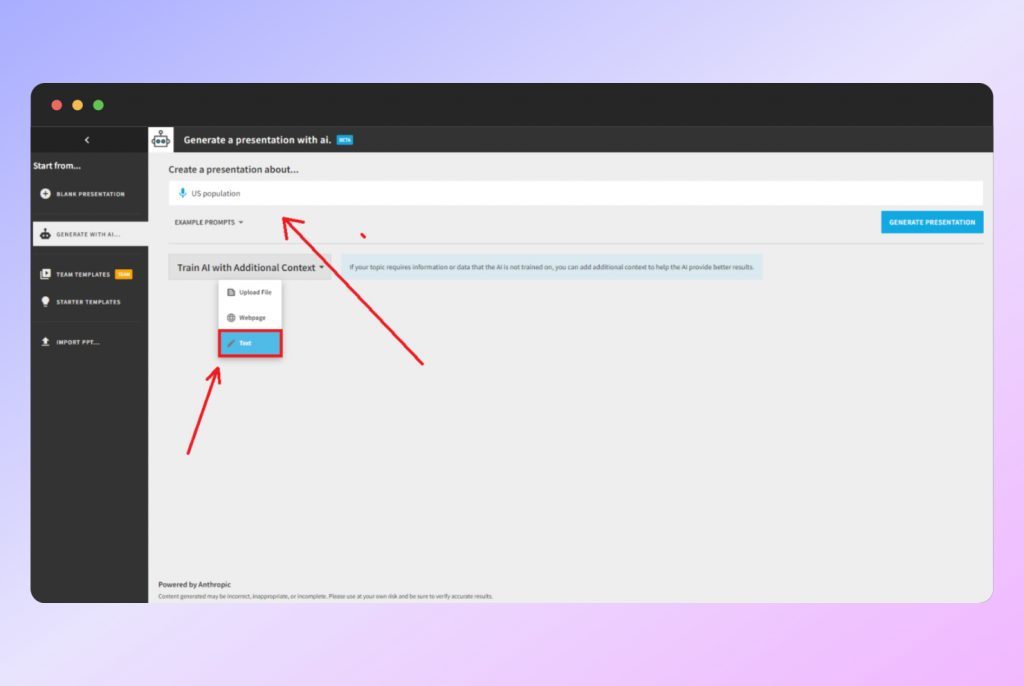
Step 3: Generate a presentation
Copy the data from your Excel and paste it into the text box that appears on the page. After that, click the Generate Presentation button.
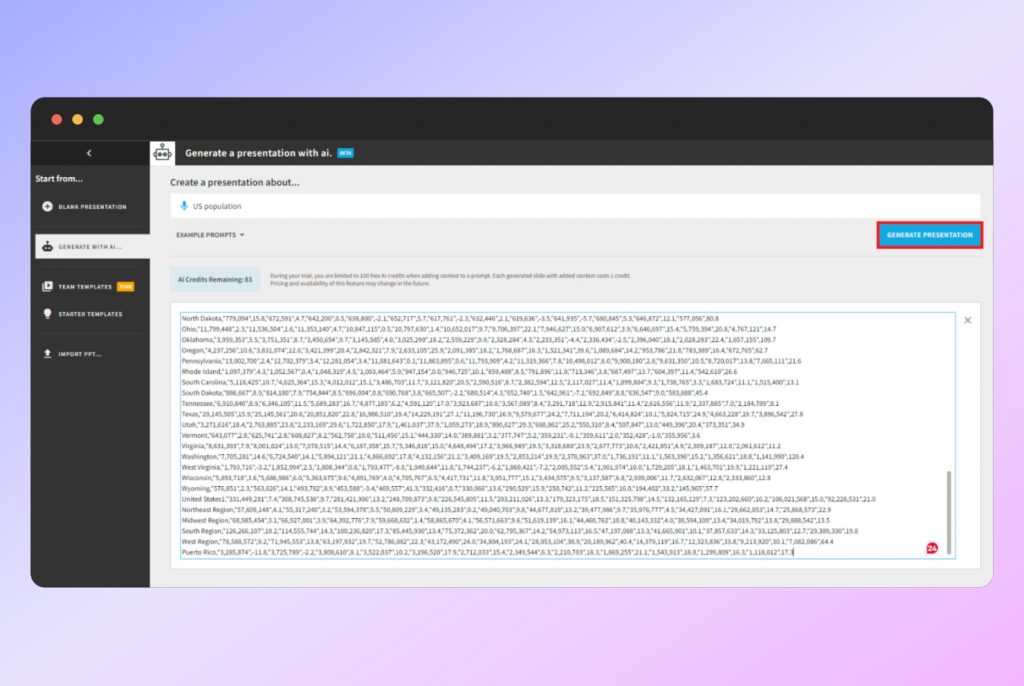
Step 4: Review presentation
You can review and edit the created presentation. The presentation editor provides functions for changing colors, fonts, images, and layouts. You can completely change the content of the slides and add new ones.
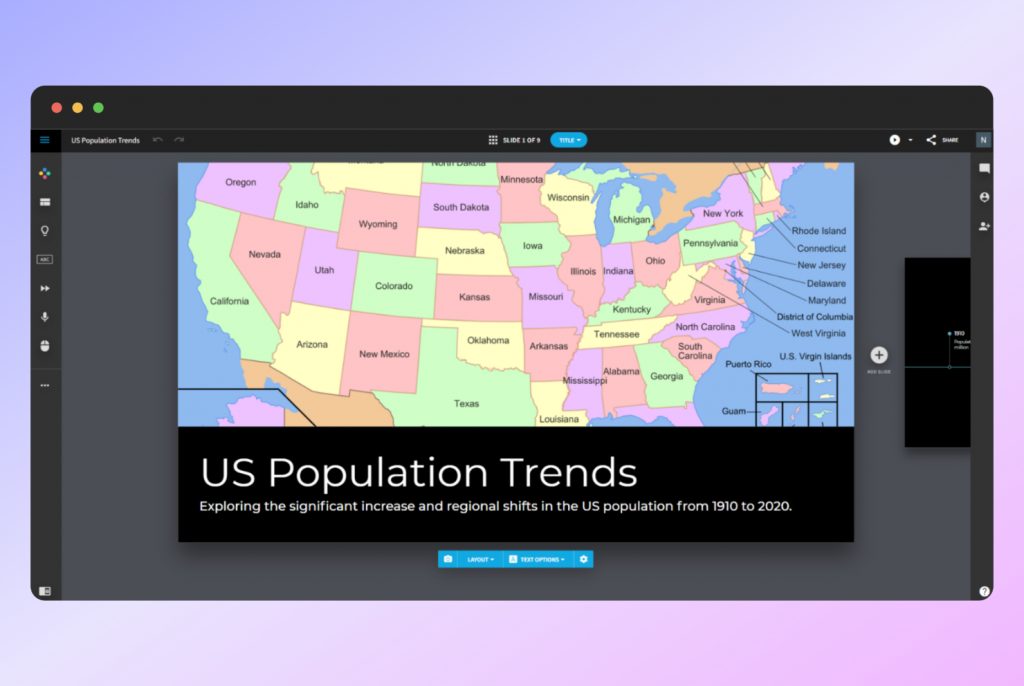
You can export the final presentation as PowerPoint and PDF files or Google Slides.
- Simple and intuitive user interface;
- Visually attractive design;
- Integration with Google Slides, PowerPoint, and PDF;
- Ability to collaborate with team members in real-time and securely share presentations.
- It is not possible to import Excel files;
- A paid subscription is required to access Beautiful.ai features;
- Limited customization options compared to creating presentations manually. Users may find it difficult to create a custom design or include certain branding elements.
- There are possible errors, as the AI is not 100% precise.
Overall, Beautiful.ai allows customers to create visually attractive presentations, saving time and effort. However, it is worth analyzing all its pros and cons to determine whether it meets your needs.
Method 4: Create presentation content using ChatGPT
Website: https://chat.openai.com/
ChatGPT is an AI tool that can perform natural language processing and generate text based on input data. It can answer questions, create summaries, perform translation, and generate text that looks natural and fits the context.
It is important to note that ChatGPT does not currently provide the ability to create PowerPoint from Excel. However, you can use it to greatly simplify and speed up the process of creating a presentation. You can do this in two ways:
- Generate titles and slide content with ChatGPT that you can copy and paste into your presentation.
- Generate VBA code that you can use to create your presentation in PowerPoint.
To generate presentation content from Excel using ChatGPT, perform the following steps:
- Ask to create a table of contents for the presentation.
- Generate slides’ content.
- Review the proposed content.
- Copy the finished content in PowerPoint.
Step 1: Ask to create a table of contents for the presentation
Write the following request in the ChatGPT chat: “Please suggest a table of contents for 8 slides for a presentation for this data: ” and paste the data from your Excel file. With the paid version, you can directly upload XLS files in ChatGPT and let it generate stuff for presentations.
Review the proposed presentation structure and ask clarifying questions or request revisions.
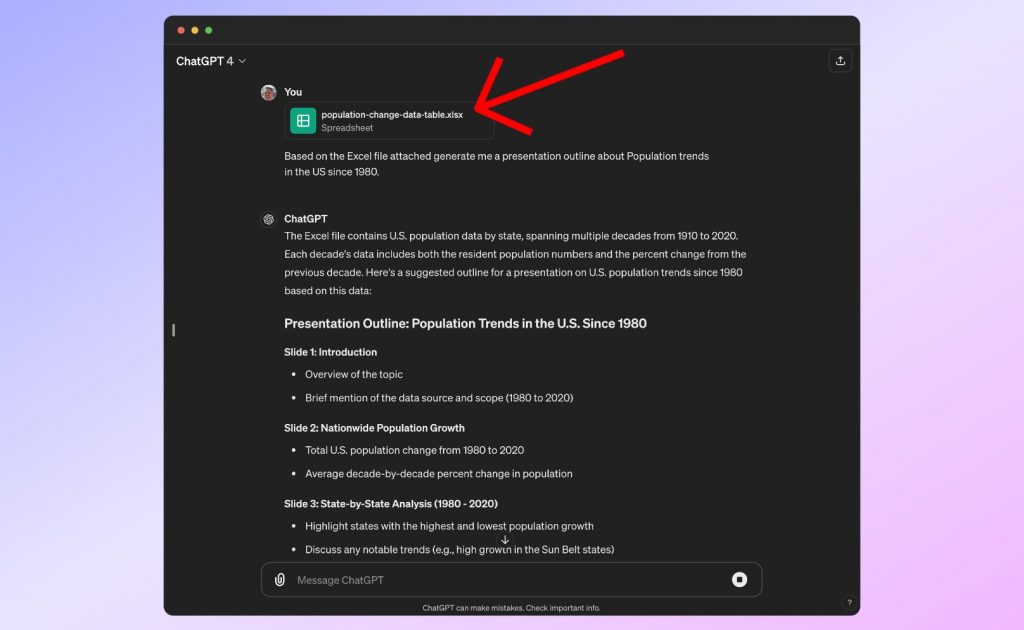
Step 2: Generate slides’ content
Ask ChatGPT to generate a few key phrases for each slide. For example, write in the following request: “Please provide 3–5 bullet points about Population Trends in the United States.”
Step 3: Review the proposed content
Review suggested content for each slide. Ask for content to be corrected or clarified as needed. You can also adjust the content manually.
Step 4: Copy the finished content in PowerPoint
Create a presentation in PowerPoint. Copy the title and content to each slide separately. Customize the design and add images and your brand logo to suit your needs.
- On-demand generation of presentation content;
- Ability to send an unlimited number of requests for free;
- The possibility of improving the content of the presentation.
- It is not possible to generate a ready-made presentation;
- Unable to generate graphic content;
- You need to do many settings manually;
- To upload an Excel file, you need the paid version.
Using ChatGPT to create presentations can be helpful for efficiently generating ideas and content. However, you may also need to make manual edits and manually transfer content generated by ChatGPT to PowerPoint.
Therefore, AI-based tools, such as SlideSpeak, Microsoft Copilot, Beautiful.ai, and ChatGPT, provide powerful solutions for converting Excel files into PowerPoint presentations. These instruments allow you to create beautiful presentations, significantly saving time and effort.
However, before choosing the best tool for you, it is impotant to clearly define your needs and analyze the advantages and disadvantages of each instrument. You can utilize the trial version to try the functions of each tool and make an informed decision based on your individual needs.
Is it possible to convert Excel to PPT (with AI)?
Yes. There are free and paid AI tools that can upload data from Excel file, automatically analyze it, and create ready-made, visually attractive presentations customized to the content. Examples of such tools are SlideSpeak, Microsoft Copilot, and Beautiful.ai.
How to automatically create PowerPoint from Excel?
AI-based platforms like SlideSpeak, Microsoft Copilot, Beautiful.ai, and others allow you to create PowerPoint from Excel automatically. The step-by-step process of creating a presentation depends on the platform you choose. However, in general, to generate a presentation from an Excel file, you need to do the following:
- Select and upload an Excel file.
- Generation presentation.
- Review and adjust the finished presentation according to your requirements.
How to create PPT using ChatGPT?
ChatGPT cannot directly generate a PPT file. However, you can use it to generate the title and content of the slides and get advice on the visual design of your presentation. To do this, enter the appropriate requests in the ChatGPT chat and provide the data you need to generate a presentation. If you want a full AI solution to generate presentations with AI you can use SlideSpeak or design friendly tools like Canva.
Why don’t I have Copilot in PowerPoint?
For the Copilot button to appear in PowerPoint, you must have a paid Copilot subscription. Create a subscription and refresh PowerPoint. Then, the Copilot button should appear. You can find more info on this here: https://copilot.cloud.microsoft/en-us/copilot-powerpoint .
How can I create a PowerPoint with Copilot from an Excel file?
To create a PowerPoint presentation from an Excel file using Microsoft Copilot, make sure your Excel data is well-organized with clear column headings. Open Excel and then use Copilot to generate charts and graphs for your data. Afterwards copy the charts into PowerPoint. Microsoft Copilot in PowerPoint will then help you to figure out a suitable design for your slides. You have to use PowerPoint Copilot and Excel Copilot in combination to get good results.
Related Post

Top 5 Beautiful.ai Alternatives with AI in 2024
- August 11, 2024
- Comments Off on Top 5 Beautiful.ai Alternatives with AI in 2024
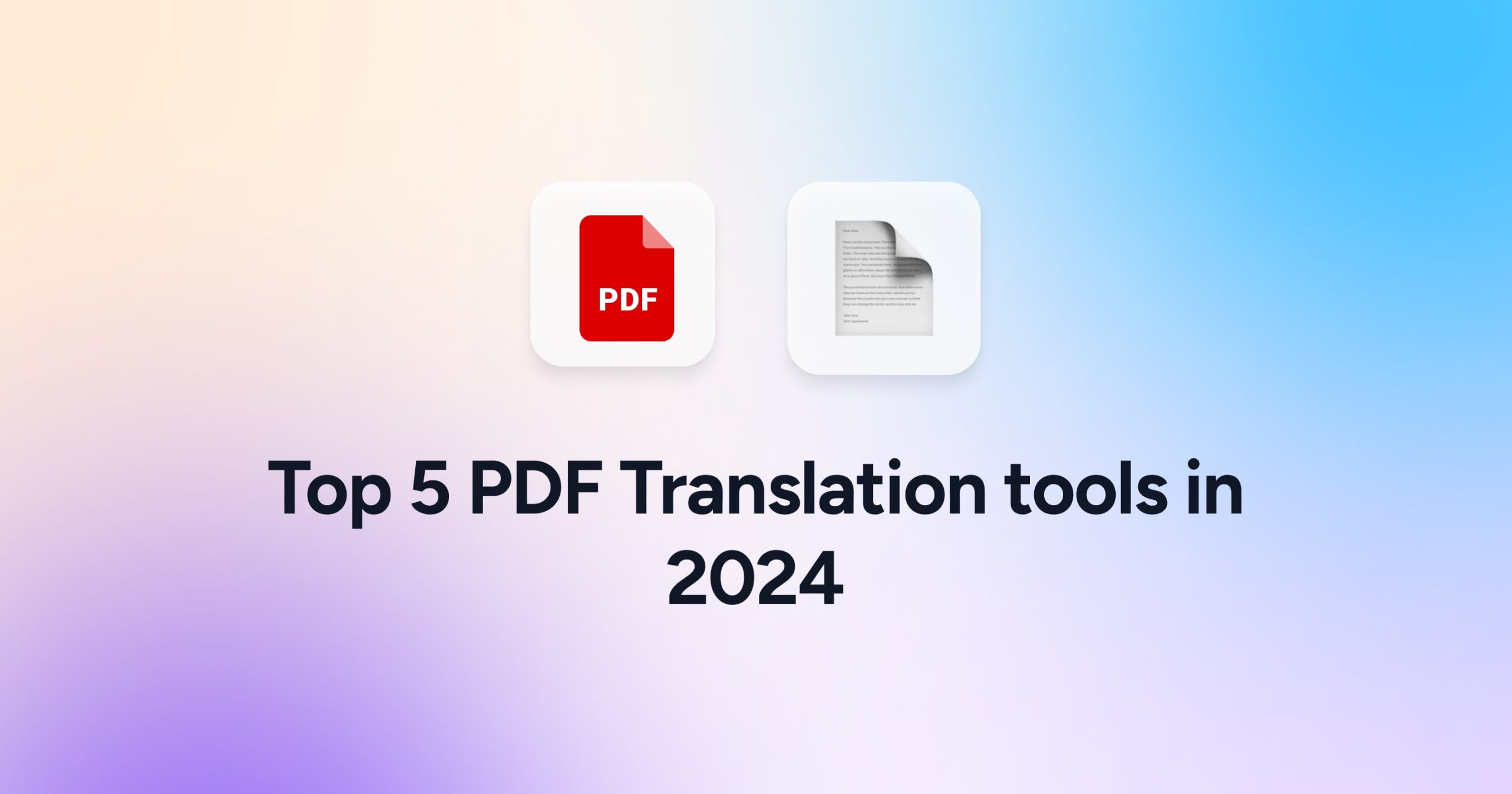
Top 5 AI PDF Translator Tools in 2024 that are Free
- July 17, 2024
- Comments Off on Top 5 AI PDF Translator Tools in 2024 that are Free

5 Ways how to use AI to Write a Resume
- July 9, 2024
- Comments Off on 5 Ways how to use AI to Write a Resume
AI generate presentations and summaries.
Summarize and generate PowerPoint files with ChatGPT. Upload, chat, and gain new insights from your presentations. Use SlideSpeak AI to boost your productivity.
- Help Center
- Affiliate Program 💵
- Call us: +1 (512) 777-1759
- Compress PowerPoint
- Convert PowerPoint to PDF
- Convert PowerPoint to PSD
- Convert PowerPoint to Figma
- Convert PDF to Word
- Extract Images from PowerPoint
- Extract Images from Word
- Extract Images from PDF
- Terms of Service
- Refund Policy

- Presentation Design
- Report Design & Content Research
- Motion Graphics
- Interactive Design
- Design with AI

How to Create Powerful Presentations Using Excel

TL;DR Transform raw Excel data into compelling presentations with our 15-step guide. Learn to set objectives, clean data, select appropriate charts, and incorporate interactive elements for engaging and effective presentations. Enhance your storytelling and data visualization skills to create powerful, dynamic presentations.
Introduction
Sometimes, we receive data in Excel and are tasked with transforming this raw data into powerful presentations. Excel is not just for spreadsheets; its powerful data manipulation capabilities make it an excellent tool for creating presentations, especially when dealing with large datasets or when you need to display data-driven insights dynamically. This guide provides 15 detailed steps to help you turn Excel data into compelling presentations effectively.
Detailed Steps to Create Engaging Presentations Using Excel

- Set Your Objectives
- Clearly define the purpose of your presentation.
- Identify the core message you want to convey.
- Understand your audience's needs and expectations.
- Set actionable goals for what your presentation should achieve.
- Align your presentation structure to these objectives for maximum impact.
- Organize Your Data
- Separate raw data and analysis into different sheets for clarity.
- Group similar data together to facilitate easier analysis.
- Use named ranges to make data references clearer.
- Organize data chronologically or categorically based on the presentation flow.
- Maintain a clean and organized data setup to avoid confusion during visualization.
- Clean Your Data
- Remove any irrelevant or redundant data.
- Correct all errors and inconsistencies in the data set.
- Use Excel functions like TRIM to clean text data.
- Standardize data formats (dates, numbers, etc.) across your dataset.
- Check for and resolve any missing data issues.
- Select Appropriate Charts
- Choose charts that best represent the nature of your data.
- Consider the impact of different chart types on data interpretation.
- Use bar or column charts for comparisons among categories.
- Opt for line charts to display trends over time.
- Employ pie charts to show proportions within a whole.
- Utilize Advanced Chart Options
- Explore Excel’s specialized charts like radar or waterfall for complex data.
- Customize chart colors, labels, and legends for better readability.
- Use trend lines or data labels to add meaningful insights to charts.
- Employ dual-axis charts for comparing different datasets on the same chart.
- Utilize 3D charts to enhance visual appeal, but use sparingly to avoid distortion of data.
- Link Data Dynamically
- Connect charts to live data sources to ensure real-time data updates.
- Use Excel’s Data Model to integrate data from multiple sources.
- Apply dynamic formulas like INDEX and MATCH to make charts responsive.
- Employ data validation techniques to ensure data integrity.
- Set up dynamic ranges to auto-adjust as data grows.
- Incorporate Interactive Elements
- Use slicers and timelines for interactive data segmentation.
- Implement PivotTables to summarize large datasets dynamically.
- Add form controls like buttons and sliders to make the presentation interactive.
- Design your slides to respond to user inputs or selections.
- Ensure interactive elements are intuitive and clearly contribute to the narrative.
- Design a Dashboard
- Combine multiple data visualizations on a single screen for a unified view.
- Ensure each component of the dashboard provides unique but complementary information.
- Use consistent design elements across all visuals for a cohesive look.
- Make sure the dashboard is easy to read and navigate.
- Include interactive elements in the dashboard to engage the audience.
- Automate with Macros
- Use macros to streamline repetitive tasks, enhancing presentation efficiency.
- Automate data updates and visual adjustments with VBA scripts.
- Write macros that help navigate through the presentation smoothly.
- Ensure macros are tested and error-free to avoid glitches during the presentation.
- Provide button triggers for macros on the Excel interface for easy access.
- Narrative Flow
- Structure your presentation to tell a coherent story.
- Begin with an introduction that outlines key points.
- Build the body of your presentation with data-driven analysis.
- Conclude with a strong, data-supported conclusion.
- Transition smoothly between sections to keep your audience engaged.
- Maintain Design Consistency
- Use a uniform color scheme, font style, and layout across all slides.
- Apply consistent formatting rules for all data visuals.
- Design templates that can be reused for future presentations.
- Ensure that the visual design supports the data narrative.
- Avoid overdesigning that may distract from the data itself.
- Test and Iterate
- Conduct dry runs to test the flow and functionality of your presentation.
- Invite feedback from peers to refine content and design.
- Make iterative adjustments based on practical trials and feedback.
- Test on different devices to ensure compatibility.
- Finalize the presentation after thorough testing and refinement.
- Prepare Backups
- Save copies of your presentation in multiple formats.
- Ensure you have both digital and physical backups available.
- Regularly update your backups to reflect the latest changes.
- Store backups in different locations to mitigate risk.
- Consider cloud storage options for easy access and additional security.
- Have a contingency plan in place in case of technical issues.
- Add Supporting Notes
- Embed comments within your Excel cells to provide additional context.
- Use the notes section for personal reminders during the presentation.
- Prepare detailed explanations that can be referred to if questions arise.
- Keep notes concise and relevant to the data being presented.
- Ensure all notes are hidden from the audience view but accessible to you.
- Peer Review
- Share your presentation with colleagues or experts for feedback.
- Encourage constructive criticism to refine your presentation.
- Consider diverse perspectives to enhance the presentation’s appeal.
- Implement suggested changes that align with your objectives.
- Conduct a final review session to ensure all feedback has been addressed.
Mastering Excel for presentations transcends basic data visualization—it transforms how we communicate and persuade with data. This expertise not only empowers you to deliver insights in a compelling manner but also enhances your strategic influence within your organization or client base. Through the careful integration of data, design, and narrative, your presentations become not just informative but transformative, inspiring action and facilitating decision-making. The steps outlined in this guide equip you with the tools to turn complex data into captivating stories that resonate deeply with your audience. Embrace these practices to elevate your presentations from mundane to memorable, ensuring that every data point not only informs but also inspires and engages.
Are you ready to leverage your Excel data into powerful narratives that not only inform but also inspire and persuade? Visit INK PPT today and discover how our expert design services can amplify your presentation impact. At INK PPT, we don't just design slides; we craft stories that engage, inform, and motivate your audience to action. Elevate your presentations with us—where data meets design and storytelling.
Discover how we can create magic in your communication
%20(1).jpg)
Blog Categories
About the author.

Ankush Dahiya - Unleashing Possibilities
My journey is all about forging connections and unleashing the potential of our ventures. Whether it's nurturing partnerships, shaping strategies, or discovering new horizons for our business, I'm your go-to person.
Read The latest Related Blog
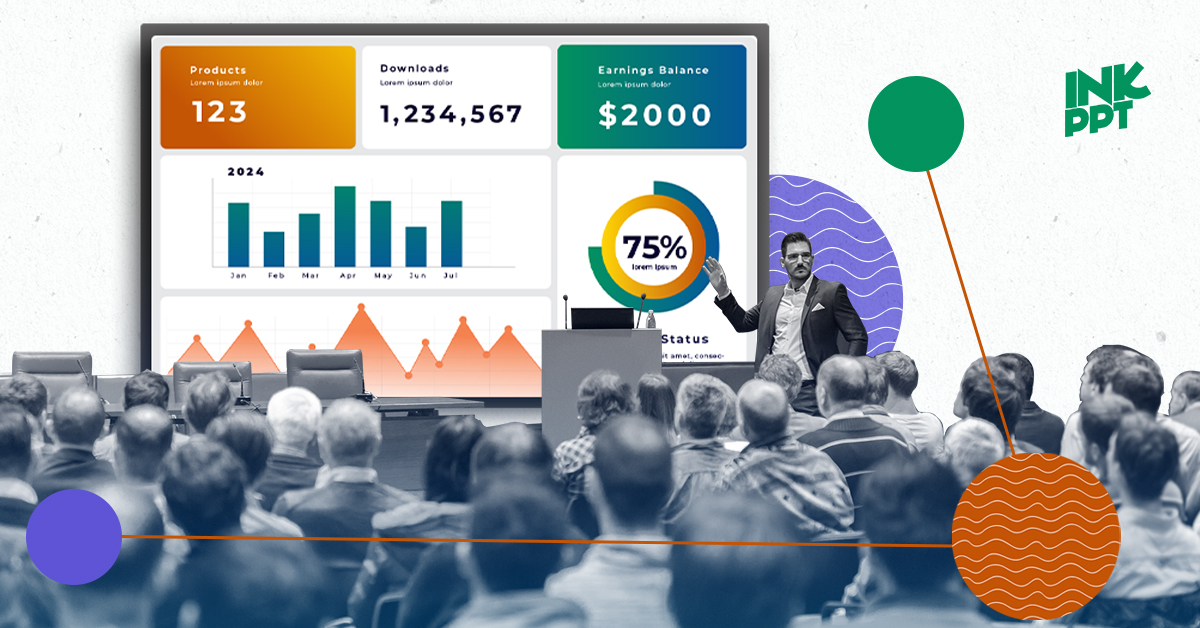
How to Craft an Effective Business Presentation PPT in Minutes

8 Essential Design Principles for Impactful Presentations: Enhance Your Brand's Message

Mastering Executive Presentations: 9 Essential Tips for Impressing Senior Management
Experience excellence with your presentations..
%20(1).png)
How to create your presentation using Excel?
Hrideep barot.
- Presentation

MS- Excel, widely known as Excel, is famous for its spreadsheets and data handling. But little has been explored of this wonderful software other than the standard features.
Do you know that you can create and give your presentation using Excel? Are you curious of how to create a presentation in Excel?
Read till the end to get familiar with the steps and bonus tips in the end!
This is our game plan for this article.
Is excel presentation a good choice?
Step 1: choose a template, step 2: create slides, step 4: remove the grids, add a background picture, add colors to your data, font size matters, make use of cells, title slide, conclusion slide, product sales, comparative analysis, financial resolution or budget proposal, who all can benefit through excel presentations, does excel have presentation mode, how to export excel presentations.
Now, you might wonder: how can a simple spreadsheet be made presentable, especially a business report or pitch?
Well, using Excel might be more advantageous than you think. Here’s why:
Although PPT or PowerPoint Presentations gives a wide variety of options and templates to choose from, it can sometimes be too stretched out or contain lots of information that can be overwhelming.
Often, the main agenda of the presentation gets blurred, as we tend to emphasize and explain each and everything on the PPT.
If you want to give a crisp, short and effective presentation, then consider going for an Excel presentation.
There are fewer chances of your audience losing focus, as you emphasize only the needed information, especially if you are presenting a business report.
You will also save time of giving and making your presentation.
Now that you know why Excel is a good choice, let us see how we can use an Excel sheet in a presentation.
Creating a presentation in Excel
Creating a presentation in Excel can be the easiest way of making a presentation.
Follow these steps to make your presentation in excel:

The first step is to choose a template that goes with the aim of your presentation.
If your aim is to give a business presentation, you can go for templates like the ones seen in the above picture.
If you aim to present a business idea or budget, then you can choose templates such as planner and checklist or expense budget.
Choosing the right template would make things easier for you and your audience.
You might wonder how can I possibly create a slide in excel? Isn’t that a feature of PowerPoint?
Well, the idea is to create one similar to PowerPoint.
By using the sheets as slides, one can easily create an impactful presentation.
Make sure to name the sheets, and arrange them in order to give a smooth presentation.
Step 3: Organize your data
Now enter your required data and arrange it.
Simply select the required data by pressing the SHIFT key and use the ARROW keys to select.
Then, click on the Insert option from the menu tab and click on the Recommended Charts.
Now, select the type of chart you want.
Here are some possible options:

If you have data that depicts a financial report, and you want to explain the profits annually, then go for Line Graphs.
Remember to name your chart. You can click on the chart title to rename it.

If you want to present a monthly report on the expenses, then go for a pie chart.
Pie charts fit well when you present on a single aspect or topic.
Tables work for almost all purposes.
However, the information presented needs to be simple and short.
You can do this by making colored tables.
You can select your data, and from the Page Layout option from the menu, browse the themes and colors.
Go for lighter tones, as they look aesthetic and professional as well.
Also, the audience won’t find it difficult to read the data, which can happen if you use darker colors.
One of the main features of Excel are the grids, i.e., rows and columns.
Our last step is to get rid of the grids, as they can distract the audience and you may also run the risk of giving a shabby presentation.
To remove grids, go to the Page Layout option in the menu tab and unselect or uncheck the boxes under Gridlines and Headings.
After this step, your presentation would seem as if it was made using a PPT!
Tips for making a creative and professional presentation using Excel

Level up your presentation by setting a background picture in your Excel sheets!
In order to do this, go to the Page Layout and click on Background.
You can choose any of your saved pictures or choose from almost infinite options by searching one.
After you choose your picture, click on insert and your background picture is ready!
Last step is to remove the gridlines for a clean presentation.
You can also remove Headings and Formula Bar by unchecking them from the View tab.
It is quite a task to locate and understand data when everything is of the same color.
In other words, when you have a single color, say white, the audience would be busy tallying the data from right to left and not be able to concentrate on your presentation.
To resolve this issue, make your tables with two color tones.
You can choose them from Themes in Page Layout.
Here is the final result:

This table would take less time to locate the data in one row, as the color makes the task easy!
I bet you took some time to read this, especially if you are looking from a laptop or PC.
Did you feel any difference?
Your eyes were strained as you tried to read what was written.
Hence, make sure to have a decently larger font for making your information visible to everyone as not everyone sees your presentation from the same proximity as you.
If you don’t want a background picture, you can go for an image.
For adding an image, go to Insert and click on Illustrations.
You can add pictures, shapes, icons, 3D models and many more.
Remember to uncheck the Gridlines and Headings, before adding the images.
Cells in a spreadsheet can be used in creative ways.
Apart from entering data and doing calculations in a breeze, they can be turned into text boxes!
So make use of them as far as you can.
You can add in the main heading in the first sheet along with a background picture.
You can also use cells for short descriptions or notes below the tables or data for better comprehension for the viewers.
This is very important for all types of presentations and not just for Excel.
The main reason to categorize is to avoid “data dump”.
This happens when you put in too much information in one chart or sheet.
You might get confused or zoned out while presenting, and it is overwhelming from an audience’s perspective as well.
So, divide your data into various sheets and name them, ensuring they are in right order.
Doing so will also give your presentation a better clarity.
Sample Excel presentation
Suppose you are from the Sales department and are asked to give a presentation to the senior executives about the current vaccination drive status and future prospects.
Considering the period to be Jan-June 2021, here is a possible sample of how you can go about giving your presentation using Excel:

Here you can talk about your views on how the organization should carry forward the vaccination drive, and give suggestions on how to do it more efficiently.

What are some good Excel presentation topics?
Excel is a good medium to present product sales. The sample presentation above is a type of product sales.
It gives the organization a clear idea of the direction of the sales of a product and planning further marketing strategy.
If you have just begun your journey as an entrepreneur or are in the sales and marketing field, here is a useful article for you to enhance your skills of giving a business pitch to your clients! Pitch Perfectly: Crucial Public Speaking Tips for Startup Founders
Some topic ideas for product sales can be:
- Annual product review in XYZ branch
- Sales review of XYZ product
- Review of top-selling products in XYZ zone
- Sales promotion review 2020-21
Comparative analysis can be presented using Excel most effectively.
You can show data in simple charts and graphs, and compare the metrics using parameters such as time( weekly, monthly, annually) or regionally( within a company or branch, across branches, or internationally).
Some topics you can consider:
- Comparative analysis of student population taking XYZ stream/course
- Analyzing weekly donations to XYZ foundation
- Regional analysis of reported crimes in XYZ state
- Health and hygiene: A correlational study
Excel is a go-to application when it comes to finances.
With its easy tools and graphics, you can present budget proposals and financial resolutions with utmost ease.
You can consider these topics:
- FDIs for the year 2018-22
- Shares review 2020-21
- Annual review: Financial department
- Funds report: XYZ branch 2020-21
Although Excel is a great tool, it is not suitable for every type of presentations and professions.
It is an excellent medium for those engaging in quantitative data such as:
- researchers
- sales and marketing
- data analysts
- corporate executives
- logisticians, etc.
You can present your data in full-screen mode or presentation mode in Excel!
To do this, go to the View tab and select Full-screen mode, or press CTRL+ SHIFT+F1.
To go back to normal mode, right-click and choose the close full-screen option, or click on the three vertical dots on the top of the screen.
To export your Excel presentation, follow these steps!
STEP 1: Go to Files tab and select Export option.
STEP 2: In Export, click on create PDF/XPS document and name your file.
STEP 3: Click on Publish. Done!
Although we went through the steps of making an Excel presentation, do not leave the other aspect out!
Your body language and delivery style also matters!
If you are confused on what approach to take regarding body language while giving a speech, follow this article! To walk or stand still: How should you present when on stage?
For preparing your voice, follow along How to prepare your voice for a speech: Step-by-step guide .
We took a look into the steps for creating a creative and effective Excel presentation in just 4 steps!
Hope that the steps and tips would make your next Excel presentation a success and completely reinvent the way Excel is seen!
Enroll in our transformative 1:1 Coaching Program
Schedule a call with our expert communication coach to know if this program would be the right fit for you

How to Brag Like a Pro as a Speaker

Less is More! Tips to Avoid Overwhelming Your Audience

What does it mean to Resonate with the Audience- Agreement, Acceptance, Approval

- [email protected]
- +91 98203 57888
Get our latest tips and tricks in your inbox always
Copyright © 2023 Frantically Speaking All rights reserved
Contextures Blog
Excel tips and tutorials

PowerPoint Slides From Excel List
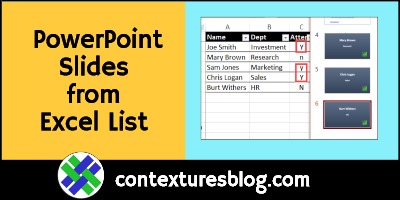
If you have a list of names or topics in Excel, here’s how you can quickly create PowerPoint slides from that list. Unlike most of my macros, these run in PowerPoint, to pull the data from Excel. That was easier than writing Excel macros to make things happen in PowerPoint!
Create a Slide for Each Excel Item
In these macros, the main PowerPoint slide is duplicated. Then, the data from Excel is added to the text boxes on the new slide.
There are 4 macros, with variations for
- 1 or 2 text boxes on the slide
- all Excel rows, or based on criteria
You can download the free files from my Contextures site . There’s a zipped folder with the PowerPoint presentation, and an Excel file with data for the slides.
Slide Data in Excel List
There’s a small named table in the sample Excel file, with data for the PowerPoint slides.
You can use this for testing, before trying the macros with your own Excel data.
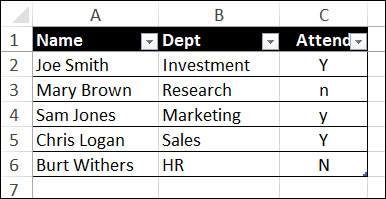
PowerPoint Main Slide
In PowerPoint, the first slide in the presentation has two text boxes.
The macro duplicates the first slide, and puts the Excel information in those text boxes
In the sample file, don’t move the main slide, if you want the macros to work correctly!
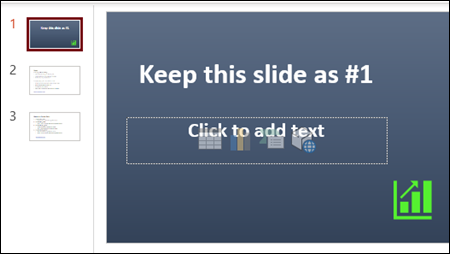
That first slide in the presentation is based on a Master slide.
- You can edit its Master slide, to change the background or text box settings.
- You can also replace that chart icon with your company logo, or add other features.
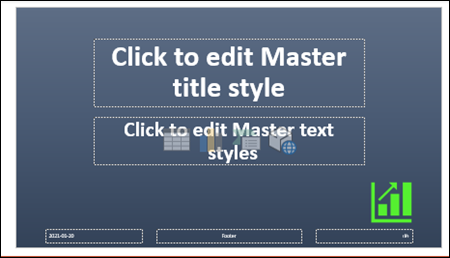
More PowerPoint Slides
In the PowerPoint file that you can download from my Contextures site, there are 2 other slides.
- Those additional slides have notes on using the macros, and formatting the Slide Master.
- These slides aren’t needed by the macro, and you can delete them.
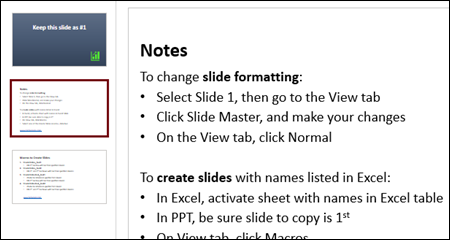
How to Run Macro to Create Slides
To create PowerPoint slides, from a list in Excel, follow these steps:
- Open the Excel file where your list is stored
- Activate the sheet where the data is stored – the list must be formatted as a named Excel table
- Open the PowerPoint presentation that contains the macros and main slide
- Be sure the main slide, that you want to duplicate, is the first slide in the presentation
- At the top of PowerPoint, on the View tab, click Macros
- Select one of the Create Slides macros, and click Run
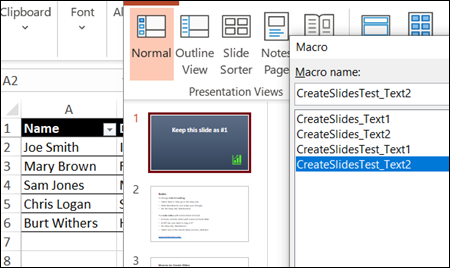
Check the New Slides
After the macro runs, you can check the new slides that were added to the PowerPoint presentation.
- In this example, I ran the macro for 2 text boxes, and checked column 3 in the data, for a “Y”
- Three of the rows have a “Y”, so 3 slides were added to the presentation.
NOTE : This macro code is further down the page, and all four macros are in the sample PowerPoint file.

Save the PowerPoint Slides
After you run the macro, and create the duplicate slides:
- Save the PowerPoint file with a new name .
- Then, in that new file, delete the main slide and the two notes slides, or hide them.
NOTE : If you simply export the new slides, you’ll lose the formatting, because they’re based on the Master Slide in the original PowerPoint file.
Create a Presentation Template
Another option is to save the PowerPoint file in PowerPoint Macro-Enabled Template (potm) format.
By default, that file will be saved in your Custom Office Templates folder.

Then, to create a new set of slides from Excel data:
- In PowerPoint, click File, then click New
- In the Templates section, click Personal
- Click on the Slides from Excel template, then click Create

PowerPoint Slides From Excel Macro Code
Here is the code for the CreateSlidesTest_Text2 macro that fills two text boxes on a slide, and checks the Excel table for criteria.
NOTE: To use the macro with a different Excel table, you can change the variable settings, in this section of the macro code.
This macro creates slides for items in the Excel list, after checking a criteria cell, and fills 2 text boxes.
- In Excel, checks the test column ( colTest ), and creates a slide if it contains the specified text string ( strTest )
- In the PowerPoint slide, text from the specified columns ( col01 and col02 ), is entered in the 1st text box and 2nd text box
Learn More About PowerPoint Macros
There are PowerPoint code samples on the Microsoft site , that helped me get started with these macros to create slides from Excel data.
For more examples, you can check the StackOverflow forum, or PowerPoint sites.
Get the PowerPoint Slide Files
The macros that create slides are stored in the PowerPoint file. There are no macros in the Excel workbook
______________________________
PowerPoint Slides from Excel List
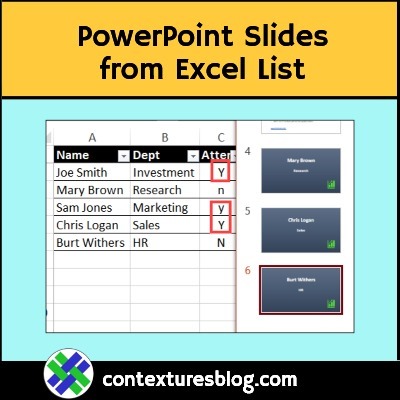
_____________________________
4 thoughts on “PowerPoint Slides From Excel List”
Does this work on Macs? I keep getting the “No Excel table found on active sheet” when I try to run it. I’ve been using the sample slides and sample worksheet and I am sure to have the sheet with the table “activated” (clicked on? this just means clicked on, right?) when I try to run the macros. None of them work, they all give the sam error message. I also went into VBA editor Tools/References in both programs to make sure the other was clicked on. No luck. Thoughts? Help?
I don’t think it works on Macbook. I had the same error, tried it on a Windows laptop and worked perfectly.
It also has some problems with large data sets and stops running the code after a few hundred rows, (I had almost 1000 rows) but a quick fix would be to delete the rows that it has already done and run again. It will add the new slides after the last slide in the powerpoint.
To the person behind this: thank you so much. You have saved me hours of my life. I was populating each of my slides manually and it took me the whole day to get through 1/16th fo the work. With this code, took me <5 minutes. Thank you so much.
Did you ever figure out how to do this on a mac? If so, please share…
When I click RUN, it only makes about 10 of 219 slides. I am trying to do a list of names. The error says “Could not complete Slides”
Any help would be appreciated
Leave a Reply Cancel reply
Your email address will not be published. Required fields are marked *
This site uses Akismet to reduce spam. Learn how your comment data is processed .

- Charts and Graphs , Excel Howtos , VBA Macros
Create PowerPoint Presentations Automatically using VBA
- Last updated on May 20, 2020
This is a guest post by Drew Kesler.
You’ve been there before. It’s almost 5:00, and you are going crazy trying to finish the presentation due for a monthly performance meeting the next morning. The model is refreshed, and now it just takes a LOT of copying, pasting, and positioning to get the PowerPoint ready. Finally, the slides are finished…, until you read a new message from your boss requesting a minor change. But of course her change means you have to start all over with the copy and pastes…
There is always a better way! In the Oil and Gas industry, I constantly have monthly reports to assess the performance of our operating assets. Excel VBA makes it a cinch to automate the entire process. So when a simple change is requested, the presentation is automatically generated with the click of a button. No more wasting time!
So, here it is – How to Save TONS of Time by Using an Excel VBA Macro to Build Your Presentation:
1. Build your charts in Excel
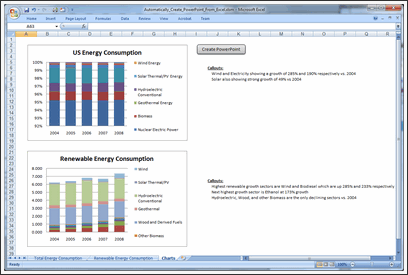
3. Open VBA. To do this, you can either press ALT + F11, or you can take the following steps:

7. Now all you need to do is go to Excel and run the CreatePowerPoint macro! To make this easy, draw a rectangle shape in your Excel worksheet which contains all the charts you want to export to PowerPoint.
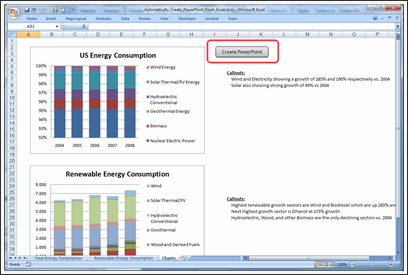
Download the Example Workbook & Play with this Macro
Click here to download the example workbook and play with the macro .
Note: If you have an error with Power Point application activation, use this code instead.
Thanks Drew
Thank you so much Drew for writing this insightful article and showing us how to automate PPT Creation thru Excel VBA. I have really enjoyed playing this idea. And I am sure our readers will also like it.
If you like this technique, say thanks to Drew.
How do you Automate PPT Creation?
During my day job, I used to make a lot of presentations. But each one was different. So I used to spend hours crafting them.
And nowadays, I hardly make a presentation. But I know many of you make PPTs day in day out. And this technique presented by Drew is a very powerful way to save time.
Do you use macros to automate creation of presentations? What are your favorite tricks & ideas? Please share using comments.
Learn More VBA – Sign-up for our VBA Class Waiting List
Chandoo.org runs a VBA Class that teaches you from scratch, how to build macros to save time & automate your work. We opened our first batch in May this year and had an excellent response. More than 650 students signed up and are now learning VBA each day.
If you want to learn VBA & advanced Excel, this is a very good class to join.
Click here for full information on VBA classes .
About the Author:
Drew Kesler specializes in process automation and data visualization. He currently performs analytics and modeling for the Oil and Gas industry. His most recent projects include using GIS mapping technology to visualize data and enhance interaction across organizations.
Share this tip with your colleagues

Get FREE Excel + Power BI Tips
Simple, fun and useful emails, once per week. Learn & be awesome.
- 212 Comments
- Ask a question or say something...
- Tagged under advanced excel , Automation , charting , downloads , guest posts , Learn Excel , macros , powerpoint
- Category: Charts and Graphs , Excel Howtos , VBA Macros

Welcome to Chandoo.org
Thank you so much for visiting. My aim is to make you awesome in Excel & Power BI. I do this by sharing videos, tips, examples and downloads on this website. There are more than 1,000 pages with all things Excel, Power BI, Dashboards & VBA here. Go ahead and spend few minutes to be AWESOME. Read my story • FREE Excel tips book

Want an AWESOME Excel Class?

FREE Goodies for you...

From simple to complex, there is a formula for every occasion. Check out the list now.

Calendars, invoices, trackers and much more. All free, fun and fantastic.

Power Query, Data model, DAX, Filters, Slicers, Conditional formats and beautiful charts. It's all here.

Still on fence about Power BI? In this getting started guide, learn what is Power BI, how to get it and how to create your first report from scratch.

Automatically Format Numbers in Thousands, Millions, Billions in Excel [2 Techniques]
Ever wanted to automatically format values in thousands, millions or billions in Excel? In this article, let me show you two powerful techniques to do just that.

How to compare two Excel sheets using VLOOKUP? [FREE Template]

Sales Analysis Dashboards with Power BI – 30+ Alternatives

Announcing Power BI Dashboard Contest (win $500 prizes!)

Compound Interest Formula in Excel
- Excel for beginners
- Advanced Excel Skills
- Excel Dashboards
- Complete guide to Pivot Tables
- Top 10 Excel Formulas
- Excel Shortcuts
- #Awesome Budget vs. Actual Chart
- 40+ VBA Examples
Related Tips

How to convert test scores to letter grades in Excel?

How to get non-adjacent columns with FILTER function in Excel

What is XLOOKUP and how to use it in Excel?

Get all BOLD text out Excel Cells Automatically
212 responses to “create powerpoint presentations automatically using vba”.
Hmmm...whilst that'd be very handy sometimes, I've often found it's quicker and easier to simply link the charts to a PowerPoint, meaning that any time you update the chart, you update the PPT too.
Wondering if there is a way to actually use excel slicers while in PowerPoint Presentation mode. I figured out how to incorporate the slicers into the PPT but when you switch to presentation mode, you can't click on an fields to change the details. Anyone know if this can be done?
we have prepared a simple and useful solution for that issue. Check the following video, where its presented: http://www.youtube.com/watch?v=inBBlpd9qQ4
You will find the contact information and we will provide you that Add-in.
Than really saves you a lot of time!!
I want to create a ppt but to take each chart and table from every sheet. how can I do it?
question 2: If my ppt already exists and there has been a change in the data, I need the charts and tables to only update in my ppt. how do you suggest I solve it?
Hey here is a "cool" VBA-Code to create on the first slide thumbnails of all slides ! Regards Stef@n
Sub thumbnails() Dim strPath As String Dim i As Integer Dim n As Integer Dim sld As Slide
strPath = ActivePresentation.Path n = ActivePresentation.Slides.Count
ActivePresentation.SaveAs FileName:=strPath & "\Test.png", _ FileFormat:=ppSaveAsPNG, EmbedTrueTypeFonts:=msoFalse Set sld = ActivePresentation.Slides.Add(1, ppLayoutBlank) For i = 1 To n sld.Shapes.AddPicture FileName:=strPath & "\Test\slide" & i & _ ".PNG", LinkToFile:=msoFalse, SaveWithDocument:=msoTrue, Left:=i * 30, _ Top:=i * 30, Width:=144, Height:=108 Next i End Sub
Hi, I can't make it work. 🙁 I get the error 424: Object required. I suppose this is because of an object library is not properly referenced, but which? Thanks!
I too am getting this error and can get the sample file to work. This would be great for a project I am currently working on.
It is not clear to me from the trailing posts if the problem with the above not working has been fixed. However, the slightly modified code below works with Office 2010 (Powerpoint), and produces a slide with thumbnails (iMaxSlidesHorizontal (8) to a row).
Sub thumbnails()
Dim iFullHeight As Integer iFullHeight = 0 Dim iFullWidth As Integer iFullWidth = 0
Dim iHeight As Integer iHeight = 108 Dim iHSpacing As Integer iHSpacing = 10
Dim iMaxSlidesHorizontal As Integer iMaxSlidesHorizontal = 8 Dim iVSpacing As Integer iVSpacing = 10 Dim iWidth As Integer iWidth = 144 Dim n As Integer n = ActivePresentation.Slides.Count Dim strPath As String strPath = ActivePresentation.Path
Dim sld As Slide Dim i As Integer
Dim iSlidesHorizontal As Integer iSlidesHorizontal = 0 Dim iSlidesVertical As Integer iSlidesVertical = 0
ActivePresentation.SaveAs FileName:=strPath & "\Test.PNG", FileFormat:=ppSaveAsPNG, EmbedTrueTypeFonts:=msoFalse Set sld = ActivePresentation.Slides.Add(1, ppLayoutBlank)
For i = 1 To n
sld.Shapes.AddPicture FileName:=strPath & "\Test\slide" _ & i _ & ".PNG", _ LinkToFile:=msoFalse, _ SaveWithDocument:=msoTrue, _ Left:=iSlidesHorizontal * (iWidth + iHSpacing), Top:=iSlidesVertical * (iHeight + iVSpacing), _ Width:=iWidth, _ Height:=iHeight
iSlidesHorizontal = iSlidesHorizontal + 1
If iSlidesHorizontal >= iMaxSlideHorizontal Then
iSlidesHorizontal = 0 iSlidesVertical = iSlidesVertical + 1
this code says runtime error 429 ActiveX component cant create object. can you please help
@ steve i agree ! regards Stef@n
On occasions I have to create a large number of photo sheets for inclusion in a report. That is, a page with one or two photos and a description. Using a list in an excel spreadsheet that gives the file name for the photo and a description I written a macro to generate a powerpoint presentation that can be saved as a pdf or printed out. Any changes to photo or description are simple to do in the list.
Datapig had a similar method.
http://datapigtechnologies.com/blog/index.php/creating-a-powepoint-deck-in-excel/
This works in 2003
I downloaded the example spreadsheet in Create PowerPoint Presentations Automatically using VBA. Excel says this file is not in Excel format even though it has an .xls extension. I am using Excel2003. Any ideas?
How do you copy charts from excel into PowerPoint as ChartObjects (not metafile or linked image)? In excel 2003 we had the graph engine which enabled us to paste the chart data into Graph.DataSheet. Whats the equivalent in Office 2010??
I have a few large presentations (~300 slides). My approach was to make a chart for every possible permutation, then link them all into PowerPoint. The powerPoint works like a website, so the user can click around to get to the chart they are interested in within 1-2 clicks.
Unfortunately, this approach doesn't seem to work in Office 2007. First, it takes forever to update the links, if it does it at all. Second, once they are updated, when you go into slide show view in PowerPoint the fonts are all fuzzy (I've looked into this and it has something to do with the way PP07 scales the slides). There appears to be no solution to this so now I need a new approach...
I've tested the following approach a little and it seems to work. I have a sub that exports all the charts out as images:
Sub Export2Image() Dim oCht As ChartObject Dim flPath As String, fName As String Dim ws As Worksheet Dim cs As Chart Dim i As Long flPath = "C:\Excel\Exports" 'Put files in this folder ChDir flPath For Each cs In ActiveWorkbook.Charts i = i + 1 fName = cs.Name & i & ".jpg" cs.Export Filename:=fName, FilterName:="jpg" Next For Each ws In ActiveWorkbook.Worksheets For Each oCht In ws.ChartObjects i = i + 1 fName = ws.Name & i & ".jpg" oCht.Chart.Export Filename:=fName, FilterName:="jpg" Next Next
'MsgBox ("All workbook charts have been exported as images to ") & flPath & ".", vbOKOnly
Then in PowerPoint I link to the image on the file server. The only problem I've noticed is some of the charts have the little red "X" in the corner, but it goes away after a second or two. Though this approach seems to be viable, I am open to other suggestions. I tried the code above, but it doesn't really work for me because I have set slides with set text, I only need to update the chart.
@GrahamG : Can you share a file and procedure as you mentioned on your comment?
@Drew: Wow thanks for sharing the info...you're a life saver.
Can someone post on how to modify the VB script for the case below:
If you have a mixture of Chart and Picture in your workbook or if you have pictures only.
Meaning the presentation should be created using the pictures from excel the excel workbook, with comments as on the example sheet ofcourse.
Please help!!!
Thanks Drew, Its really useful code to work on powerpoint. If we can export it to excel again it may be awesome.
My choice is steve's because most ofthen than not you have made other customization on the powerpoint slide/chart.
But it is great to know new technique.
@Donald: Use the CopyPicture method. For example, if you go into drew's code, you will see the line: ActiveChart.ChartArea.Copy Change that to the following line: Sheet1.Range("A1:I19").CopyPicture xlScreen, xlPicture ------------------------------------------------------------------------------ Note that when you run the program it copies the contents of A1:I19 onto your presentation from Sheet1. Hope that helps!
Here's a link to the CopyPicture method: http://msdn.microsoft.com/en-us/library/bb148266.aspx .
Also, I've used and much prefer Drew's method overall. If your PowerPoint presentation is a report, then linking to the data source isn't always best when you need to send the presentation to your client or to another office branch, both of which might be outside of your network. Furthermore, generating a new presentation upon changes effectively creates an historical record. And finally, creating a presentation that isn't linked to the data source "walls off" your actual data such that nefarious and reckless can't harm it!
nice post. I have done something similar on my blog:
http://www.clearlyandsimply.com/clearly_and_simply/2010/03/export-microsoft-excel-dashboards-to-powerpoint.html
I thought you might be interested.
Along the same lines: I also had an article describing how to export a Microsoft Project Gantt chartto PowerPoint.
The interesting part of the Project VBA export procedure is the fact that it does not export the Gantt as a picture. It rather creates a project plan in PowerPoint consisting of PPT objects like textboxes, rectangles, triangles and diamonds. You can format, align, rearrange, group and resize them, add annotations, delete single items, etc. in PowerPoint.
This may be a bit off topic, because Chandoo.org is a Microsoft Excel blog, but if you are using Microsoft Project, too, you may want to have a look:
http://www.clearlyandsimply.com/clearly_and_simply/2009/03/gantt-charts-are-learning-to-fly.html
thanks for sharing the trick. However, is it possible to export in a chart format instead of picture format?
@ drew, THANK YOU for sharing, and starting this thread. @ everyone else, yes there are different ways of doing things. Sometimes your solutions would be better than drew's and sometimes drew's will be a better method. thanks for sharing your solutions @chandoo/hui can you make it easy to understand each option by expanding on this thread?
Select your chart in Excel, Go to PowerPoint and do Paste Special> Choose PasteLink> Choose Microsoft Excel Chart Object. You are done.
Now whenever you change your excel, just update link of Powerpoint. Your Chart will instantly updated.
hay its cool but it uses blank PPT tamplate what about using Companys own PPt Tamplet
[...] link [...]
@FINCRIBE create and save the PPT-Template as a POT-file Regards Stef@n
is it possible to modify the VBA to copy all charts from all worksheets into 1 single powerpoint file?
reason is that multiple charts are scattered across few worksheets and it'd be easier (or lazier) to copy ALL charts 😛
btw, any chance to perform similar copy-n-paste to Outlook Email (HTML)?
as u know, bosses hate to open attachments and would rather browse the charts via Blackberry!!
I've used this post to great effect already - many thanks for sharing!
I was wondering if the code could be modified so that rather than exporting charts to powerpoint, you could export a table?
noticed there is a bug/limitation.
if a chart is smaller than a powerpoint slide size, it works.
however, if a chart (or combo grouped-charts) is large, the VBA will not run.
error box: "Run-time error -2147418113 (8000ffff)': Method 'Copy' of object 'ChartArea' failed"
if i Debug, it will point to "ActiveChart.ChartArea.Copy"
@Davidlim: If you look on the earlier comments, robert posted a similar tehnique and on his example he has the chart/pic on different worksheets. When you execure the VB script it gives you option to open your existing template/file where the slide will be added last, meaning your presetation backround remains. or if you click cancel it creates a completely new presentation. on his Excel file he uses the names. Go to this link for more info and for the file download.
It's very interesting.
Thanks to all that contribute to these comments and I'm glad that through chandoo we get help. http://www.clearlyandsimply.com/clearly_and_simply/2010/03/export-microsoft-excel-dashboards-to-powerpoint.html
Hi Chandoo,
It works perfectly. Is there a way out to export tables from excel 2007 to PPT using Macros & the exported tables shld be in editable form in PPT.
Does anyone know how you would adjust the code for this to pick up a camera tool snapshot instead?
How doe we chnage the data dynamically in the PPT iteslef so that the graphs get modifed .Becuase currently it gor imported as an image .To chnage i have to go back to excel chnage teh data and again export .
Are there any way to chnage the values in the PPT and create the graph then and there in the PPT itself
Hi Pankaj, I might be too late to respond ... By now you might have got your answer as well. Modify the below: activeSlide.Shapes.PasteSpecial(DataType:=ppPasteMetafilePicture).Select to: activeSlide.Shapes.PasteSpecial(DataType:=ppPasteMetafilePicture, Link:=msoTrue).Select -DG.
Love it - thanks for the tip - owe you a beer 😉
How can we do it for pictures (map objects)? Anone can help thanks in advance
Great tip and is very helpful - I have a standard company template and would like to automatically place the graphs and text into this could any one please advise how this can be done with adding to the VBA code supplied.
Many Thanks
If any body can demonstrate as I have not got my answer i.e. how to automatically place the picture (bitmap) and text associated with picture in ppt. Drew and Chandoo please help
How can use this same methond to copy range of cells?
***William - First, Use this function:
Function CopyPaste(slide, selection, aheight, awidth, atop, aleft) Set PPApp = GetObject(, "Powerpoint.Application") Set PPPres = PPApp.ActivePresentation PPApp.Activate Set PPSlide = PPPres.Slides(PPApp.ActiveWindow.selection.SlideRange.SlideIndex) PPApp.ActiveWindow.View.GotoSlide (PPPres.Slides.Count) PPApp.Activate PPApp.ActiveWindow.View.GotoSlide (slide) ' Reference LAST slide Set PPSlide = PPPres.Slides(PPApp.ActiveWindow.selection.SlideRange.SlideIndex) selection.CopyPicture Appearance:=xlScreen, _ Format:=xlBitmap PPSlide.Shapes.Paste.Select
Set sr = PPApp.ActiveWindow.selection.ShapeRange ' Resize: sr.Height = aheight sr.Width = awidth If sr.Width > 700 Then sr.Width = 700 End If If sr.Height > 420 Then sr.Height = 420 End If ' Realign: sr.Align msoAlignCenters, True 'sr.Align msoAlignMiddles, True sr.Top = atop ' If aleft 0 Then sr.Left = aleft '50 End If If Not IsMissing(drawBorder) Then
'Draw border for the shape range With sr.Line .Style = msoLineThinThin .Weight = 0.1 .DashStyle = msoLineSolid .ForeColor.RGB = RGB(0, 0, 0) End With End If ' Clean up Set PPSlide = Nothing Set PPPres = Nothing Set PPApp = Nothing End Function
THEN, this line in your code:
CopyPaste slide, selection, 200, 700, 82, 10 'this copies the Selected Range
*** IF you want a working file - please let me know if you want to know how to make this dynamic, please let me know so that I can email you the working file..
@Sai Swaroop Hey Sai, if you are still able I would really appreciate getting a working copy of that excel sheet. Thanks
Please e-mail me the working file. [email protected]
Please send me the working file... tq.. really need this....
I need to export a few hundred graphs from excel and put 5 to a page in powerpoint. The graphs need to be a specified size with a black border. Can anyone provide the visual basic code to accomplish this?
Hi. I am working with a project where we create several summary reports and graphs based on a set of Raw data. Up until recently we have been using a manual process to copy paste these in Powerpoint. Could someone tell me how to copy tables and graphs over several worksheets into one powerpoint presentation please? I have tried the Macro for charts and it works great but wondered if someone could show how to make it work for tables and other data on excel.
Is it also possible for the presentation to change dynamically as the raw data chagnes? Thanks, Swetha
I have the same issue as Pankaj - how can we update the code to paste it as a Chart object that can be edited in PowerPoint (linked or the Excel file or unlinked, doesn't matter). I tried replacing "ppPasteMetafilePicture" with "ppPasteOLEObject" but it's still pasting the charts as pictures. Thanks!
Hi sai swaroop i am interested in working file pls email at [email protected]
Hi Sai Swaroop,
Can you please email me the working file?
Thanks in advance. Much appreciated.
Regards, Chax.
hey Chander,
Sent you the file.
Can you send me the working file thanks
Can you please send me the working file as I am bumping up with same errors.
Chandar &Sai,
Pls send the working file as I am bumping with invalid shapes error
Hi, I was able to paste the Excel chart into the PowerPoint as a chart object, but I'm having trouble editing it within the presentation. PowerPoint VBA does not seem to allow me to refer to the chart and edit the axis font, etc., but instead edits the axis font size, axis font color of the chart in Excel. I was wondering if anyone could help. This is what I have so far. Thank you!
cht.Select ActiveChart.ChartArea.Copy activeSlide.Shapes.PasteSpecial(DataType:=ppPasteChartObject).Select
'Adjust the positioning of the Chart on Powerpoint Slide newPowerPoint.ActiveWindow.Selection.ShapeRange.Width = 9 * 72 newPowerPoint.ActiveWindow.Selection.ShapeRange.Height = 5 * 72 newPowerPoint.ActiveWindow.Selection.ShapeRange.Align msoAlignCenters, True newPowerPoint.ActiveWindow.Selection.ShapeRange.Align msoAlignMiddles, True
i have 5 graphs which should pasted on the PPT in single slide...can we do it automatically?
I dont know VB scripting or macros, but from what i understand its taking a chart as a object, but i have sheet with a lot of field names & respective numeric values from formuales.
But this code does not work on that, do we need to update this code ?
Or can you provide a new code ? [that would be of gr8 help] or if its there on your website wats the link coz i was unable to find it.
I am into software testing so we deal with a lot of data & numeric values & less of charts..........plz assist
And request you to post entries specific to the filed of software testing. We are always on the look out of process enhancements which helps improve efficiency specially if its saving time for the project.
Here is how to copy past the chart as an actual chart rather than the picture. The pasted chart will be linked to the excel sheet, so any change in the excel sheet will be reflected on the chart.
'Copy the chart and paste it into the PowerPoint as linked charts cht.Select ActiveChart.ChartArea.Copy
activeSlide.Shapes.Paste ' This new pasted chart is actually linked to the excel sheet With activeSlide.Shapes(activeSlide.Shapes.Count) 'The chart that was just pasted .Left = 15 .Top = 125 End With
really cool....this website has wonderful tips and tricks :). Thank you a ton!
Can I put several graphs on one slide
How can this be done using Excel 2003? I have tried but keep getting the error: Missing:Microsoft Powerpoint 12.0 Object Library. How can I fix this?
Hey Brian. You'll need to reference the correct Powerpoint library. Like in the example above, you'll first, go into the VBA editor. From there you'll select the Tools menu item and click "References...."
Now, you should see something like "MISSING: Missing:Microsoft Powerpoint 12.0 Object Library" in the list box. De-select it. Now scroll down and look for something like "Microsoft Powerpoint ## Object Library" (where the # is a number). Most likely, if you're using Excel 2003, it will be "Microsoft PowerPoint 9.0 Object Library."
@ graham I am interested to do the same. Can you share the file/code with me? Thanks!
Hi I need to loop through all the sheets in a work book and copy all the charts from one sheet to one Slide. Could u help??
see above Sub thumbnails() Dim strPath As String Dim i As Integer Dim n As Integer Dim sld As Slide
ActivePresentation.SaveAs FileName:=strPath & “\Test.png”, _ FileFormat:=ppSaveAsPNG, EmbedTrueTypeFonts:=msoFalse Set sld = ActivePresentation.Slides.Add(1, ppLayoutBlank) For i = 1 To n sld.Shapes.AddPicture FileName:=strPath & “\Test\slide” & i & _ “.PNG”, LinkToFile:=msoFalse, SaveWithDocument:=msoTrue, Left:=i * 30, _ Top:=i * 30, Width:=144, Height:=108 Next i End Sub
im using a excel for mac 2011, and I can't get it to work - i keep getting this error: compile method or data member not found
and it highlights the PasteSpecial in the code!
can someone please let me know how to fix this?
any help would be much appreciated
Hi, did you ever get to the bottom of this ? I've got the same problem. thanks Paul
did you manage to solve this by any chance?
i would like to add a code to use a particular template shown in the following: PowerPoint.Application.ActivePresentation.ApplyTemplate "C:\Documents and Settings\myfile\Application Data\Microsoft\Templates\ShortTitle.pot"
But i'm getting a 429 error, claiming the ActiveX component cannot create the object.
What else can i do please?
Below is the code I use to open up a PP template. Also, Under Tools > References, you need to make sure the Microsoft PowerPoint 14.0 Object Library is checked.
Dim newPowerPoint As PowerPoint.Application Dim pptPres As PowerPoint.Presentation Dim activeSlide As PowerPoint.Slide Dim cht As Excel.ChartObject Dim file As String file = "C:\Users\jbain\Documents\PowerPoint template_Span.pptx" Dim pptcht As PowerPoint.Chart 'Look for existing instance On Error Resume Next Set newPowerPoint = GetObject(, "PowerPoint.Application") On Error GoTo 0 'Let's create a new PowerPoint If newPowerPoint Is Nothing Then Set newPowerPoint = New PowerPoint.Application End If 'Make a presentation in PowerPoint If newPowerPoint.Presentations.Count = 0 Then Set pptPres = newPowerPoint.Presentations.Open(file) End If 'Show the PowerPoint newPowerPoint.Visible = True
hi Jenn, thank you for your reply. in the Tools > Reference, i only find Microsoft PowerPoint 12.0 Object Library. How do i get hold of Microsoft PowerPoint 14.0 Object Library please?
i'm using Office 2007.
Hi Aaron, I believe you are using Office 2007 and Jenn's using 2010. Hence the difference in Object Library version. You can try using Microsoft PowerPoint 12.0 Object Library and try. Please modify: PowerPoint.Application.ActivePresentation.ApplyTemplate “C:\Documents and Settings\myfile\Application Data\Microsoft\Templates\ShortTitle.pot” to: PowerPoint.ActivePresentation.ApplyTemplate “C:\Documents and Settings\myfile\Application Data\Microsoft\Templates\ShortTitle.pot” -DG.
thank you for your suggestion. i tried the modification, and now the error claims: '429' error. ActiveX component cannot create object.
highlighsts the code: PowerPoint.ActivePresentation.ApplyTemplate “C:\Documents and Settings\myfile\Application Data\Microsoft\Templates\ShortTitle.pot”
Any other suggestions i can try please?
Sub PushChartsToPPT() 'Set reference to 'Microsoft PowerPoint 12.0 Object Library' 'in the VBE via Tools > References... ' Dim ppt As PowerPoint.Application Dim pptPres As PowerPoint.Presentation Dim pptSld As PowerPoint.Slide Dim pptCL As PowerPoint.CustomLayout Dim pptShp As PowerPoint.Shape
Dim cht As Chart Dim ws As Worksheet Dim i As Long
Dim strPptTemplatePath As String
strPptTemplatePath = "E:\DC++ Downloads\Intern\Ormax\Macro\demo template.pptx"
'Get the PowerPoint Application object: Set ppt = CreateObject("PowerPoint.Application") ppt.Visible = msoTrue Set pptPres = ppt.Presentations.Open(strPptTemplatePath, untitled:=msoTrue)
'Get a Custom Layout: For Each pptCL In pptPres.SlideMaster.CustomLayouts If pptCL.Name = "Title and Content" Then Exit For Next pptCL
'Copy ALL charts in Chart Sheets: For Each cht In ActiveWorkbook.Charts Set pptSld = pptPres.Slides.AddSlide(pptPres.Slides.Count + 1, pptCL) pptSld.Select
For Each pptShp In pptSld.Shapes.Placeholders If pptShp.PlaceholderFormat.Type = ppPlaceholderObject Then Exit For Next pptShp If pptShp Is Nothing Then Stop
cht.ChartArea.Copy ppt.Activate pptShp.Select ppt.Windows(1).View.Paste Next cht
'Copy ALL charts embedded in EACH WorkSheet: For Each ws In ActiveWorkbook.Worksheets For i = 1 To ws.ChartObjects.Count Set pptSld = pptPres.Slides.AddSlide(pptPres.Slides.Count + 1, pptCL) pptSld.Select
For Each pptShp In pptSld.Shapes.Placeholders If pptShp.PlaceholderFormat.Type = ppPlaceholderObject Then Exit For Next pptShp
Set cht = ws.ChartObjects(i).Chart cht.ChartArea.Copy ppt.Activate pptShp.Select ppt.Windows(1).View.Paste Next i Next ws End Sub
I am using this code to link charts from excel to powerpoint. But this is inserting charts to last slide. Can anyone suggest me the changes so that i get charts to link with ppt to custom slide number and in mid of some saved template. Thanks in advance.
I have Microsoft 2010, which may be why mine is 14.0. Your version should work as well. The main thing is that the PowerPoint object library is references because the VBA code includes references to PowerPoint objects.
Hi Aaron, Apologies for the delay in response. Please try: newPowerPoint.ActivePresentation.ApplyTemplate "C:\Documents and Settings\myfile\Application Data\Microsoft\Templates\ShortTitle.pot"
thanks for your reply. i've tried it with the suggestion, but this time, error msg is: Operating error: -2147188160 (80048240)': Presentation (unknown member): Invalid request. PowerPoint could not open the file.
highlights the code: newPowerPoint.ActivePresentation.ApplyTemplate “C:\Documents and Settings\myfile\Application Data\Microsoft\Templates\ShortTitle.pot”
My codes as below. Is it possible you can find some error in the coding please?: 'First we declare the variables we will be using Dim newPowerPoint As PowerPoint.Application Dim activeSlide As PowerPoint.Slide Dim cht As Excel.ChartObject Dim trfnum As String 'Variable to obtain Report # Dim trfname As String 'Variable to obtain Report Title trfnum = Range("K5").Value 'Assign/Obtain Report# from Cell K5 trfname = Range("K4").Value trfprojnum = Range("K11").Value trfpartnum = Range("K12").Value trfsnnum = Range("K13").Value trfmodelnum = Range("K14").Value 'Look for existing instance On Error Resume Next Set newPowerPoint = GetObject(, "PowerPoint.Application") On Error GoTo 0 'Let's create a new PowerPoint If newPowerPoint Is Nothing Then Set newPowerPoint = New PowerPoint.Application End If 'Make a presentation in PowerPoint If newPowerPoint.Presentations.Count = 0 Then newPowerPoint.Presentations.Add End If 'Show the PowerPoint newPowerPoint.Visible = True ' apply a slide template newPowerPoint.ActivePresentation.ApplyTemplate "C:\Documents and Settings\myfile\Application Data\Microsoft\Templates\ShortTitle.pot" regards, Aaron
Hi Jenn, thanks for your response.
i tried with the code you shared, but VBA has prompt me the following error: Presentations (unknown member) : Invalid request. The PowerPoint Frame window does not exist.
It then highlights the code line: Set pptPres = newPowerPoint.Presentations.Open(file)
What else can i try to resolve this error please?
Is there a way to insert the graph in a previously saved powerpoint instead of creating a new powerpoint?
Scratch the last question.
Does anyone know how to automatically insert the chart into the middle of a saved powerpoint instead of the end?
Thanks for the code; it worked great until I upgraded my Outlook from 2007 to 2010 (did not upgrade PP or Excel, they are still 2007). Now I get a runtime 430 error- Class does not support Automation or does not support expected interface. Any ideas on how to fix? Thanks!
Hi Kim, Not sure if you are using any ADOs (ActiveX Data Objects) in your code. Please do the following steps: In the VBE (Visual Basic Editor), select Tools > References ... > Microsoft ActiveX Data Objects x.x Library Take the latest version. I have seen many versions of the same. Below link gives you an explanation about why the error occurs: http://makebarcode.com/info/appnote/app_017.html
I do have one question, from the initial source code : How to modify the code to have the idea but with pictures. no charts So each time the code detect an image on the sheet it will create a new slide? thanks in advance.
I've tried everything I can think of...how is it (with the code presented) that you are getting the words to the right of the charts to go into PowerPoint as a separate object?
It works perfectly with your charts in your spreadsheet, but for the life of me I have not been able to replicate the behavior in my own spreadsheets.
@Chandoo: I am not able to see the updated comments in this page. Is there an issue from my side? Please let me know. Thank you. @Aaron: I believe you are using Office 2007. So, not sure about the extension of the template file. Please check the extension and change the same. Here, in your case, instead of "ShortTitle.pot" it may be "ShortTitle.potx". -DG
Overall rating This site has no rating (not enough votes)
Hi Dolphin, Thanks for your kind response and reminder. it works now!
Glad it worked! Anytime to help 🙂
Hello. I was trying to modify the supplied code for my purposes but kept hitting snags. As such, I am seeking some help with the following: I have an Excel workbook with various named worksheets and want to copy and paste the print ranges from each worksheet into an existing PowerPoint template using VBA. So, if worksheet “A”s print range is set to print on one page and worksheet “B”s print range is set to print on 3 pages, the PowerPoint presentation should have a total of 4 slides. I could end up with 10 worksheets in total representing 10+ slides needed in the presentation. Am new to VBA and would appreciate the help.
Apologies in my delayed response. Can you provide me the sample file(s), Excel and Powerpoint ones? Let me take a look and try my best.
Thanks for offering to look at the code for me. Where should I send the sample files?
@Al Refer: http://chandoo.org/forums/topic/posting-a-sample-workbook
Please send it to my email ID, [email protected]
How can I change the code so it copy and pastes only one specific chart, instead of all the charts?
Hi Ryan, `'Declare the variable` `Dim ObjChartObject As Excel.ChartObject` `Set ObjChartObject = Worksheets("WorksheetName").ChartObjects("ChartName")` `ObjChartObject.Chart.ChartArea.Copy` `.` `.` `.` `.` `Continue your code` Hope this helps. -DG
That is a very handy tool.... saved my@$$
does anyone know how to modify to always open a new power point . If ran a second time charts are tacked to the previously created presentation.
Hi, The code that was provided in this example does the same. Please see point 5, you have the entire code. In the code, look for the section - 'Make a presentation in PowerPoint'
Revert back if you are not able to understand.
is there a way to lock out any user input while code is running. if i scroll while charts are moving to the power point the code stops.
Please try the below: 'Type this at the beginning of your code. Application.Interactive = False ... <Your code here> ... <Your code here> ... <Your code here> 'Type this at the end of your code. Application.Interactive = True
Hope this helps.
nope. user input still kills the macro. is there a way to not have screenupdating with powerpoint? or soemthing similar?
it only happens with the transfer from excel to power point. is there a way to have power point come up in a minimized state to at least minimize user interaction?
In the code presented in this example, goto: 'Show the PowerPoint
After the line: newPowerPoint.Visible = True
Type: newPowerPoint.WindowState = ppWindowMinimized
This should keep the PowerPoint application in minimized.
I have (somewhat) of a reverse situation:
I had to create and access an Excel file from PowerPoint.
The first part (not shown) successfully creates a .CSV file containing several lines of data. E.g.:
12345,John,8009991212,123 Main Street 58145,Mary,3215551212,666 Mockingbird Lane
... etc. ...
The last part of the macro (shown below) successfully opens the .CSV and Personal.XLS (which contains a macro to format the Excel file), saves as an .XLS in XLS format, then runs the macro "CTI_Format_B" to format the .XLS file (freeze header, autofit columns, etc.).
'PowerPoint: Open Excel .CSV and save to .XLS, run Macro "FileFormatB" Dim oXL As Excel.Application ' Excel Application Object Dim oWB As Excel.Workbook ' Excel Workbook Object Dim FileXLS As String, FileCSV as String FileCSV = Environ("USERPROFILE") & "\" & "SamplePop.CSV" FileXLS = Left(FileCSV, Len(FileCSV) - 4) & ".xls" Set oXL = New Excel.Application oXL.Visible = True
Set oWB = oXL.Workbooks.Open(oXL.StartupPath & "\Personal.xls")
Set oWB = oXL.Workbooks.Open(FileCSV) 'open CSV file
oWB.SaveAs FileName:=FileXLS, FileFormat:=xlNormal oXL.Run ("Personal.xls!FileFormatB") oWB.Save oXL.Visible = True
The macro "FileFormatB" in Personal.xls contains formatting for the newly saved .XLS:
'Excel macro to format header, etc. Range("A1:L1").Select 'format header With Selection .Font.Bold = True .Interior.ColorIndex = 6 .Interior.Pattern = xlSolid .Font.ColorIndex = 5 End With Rows("2:2").Select ActiveWindow.FreezePanes = True Cells.Select Cells.EntireColumn.AutoFit
What I would like to do is instead of having a separate macro in Personal.xls to format the file and having to open Personal.xls (which is otherwise invisible when run here), I would like to run the same formatting from the original PowerPoint macro which created the file.
How do I run the formatting from the PowerPoint macro to the opened Excel file?
I would love to use this, but I get error messages even when I try the code on my file or run the downloaded file. It says user defined type not defined...Any suggestions? How do I define: Dim newPowerPoint As PowerPoint.Application
This is a great post!
My problem is that I would like to copy all charts on every worksheet in Excel to PowerPoint (2010).
There is one chart per worksheet, with certain cells providing the title and axis label text and, of course, the range of cells that the chart is based upon.
My problem is that I ONLY want to include that data when I paste as an embedded (not linked or picture) object into PowerPoint.
Other data that is not directly related to the chart is included in PowerPoint. This is a problem, as I don't want users of PowerPoint to see that data.
Is there any way to ONLY include the cells that the chart is directly based upon?
I am using similar code (see below) with Excel 14, Powerpoint 14 and Windows XP. I use this to copy/paste about 100 images from Excel to Powerpoint. Sometimes I get this error: "Shapes(unkown member) : Invalid request. The specified data type is unavailable." I can run the exact same code and it works, then run it again and I get this error. And the error happens in different places of the code execution each time (although always on a PasteSpecial line). Sometimes in first loop, sometimes in 15th loop, etc. Sheets("RoleSummary").Range("RoleSummaryTable").Copy
PPApp.ActiveWindow.View.GotoSlide PPApp.ActivePresentation.Slides.Count
PPSlide.Shapes.PasteSpecial (ppPasteEnhancedMetafile)
Mike, did you find a solution for this problem? I am having the same!
Have no solution, but it seems to be less prevalent if you close all other Microsoft programs while it is running, including File Explorer.
Is there a way to force the program to arrange charts by order from which they are located? If you cut and paste the first chart and execute the macro, it is now the second chart (based on it's last active postion). If not by modifying the program, is there a way to change the active arrangements of the charts some other way. Cheers
When I tried to run this macro in Excel 2007, I received this error message:
Run-time error '429':
ActiveX component can't create object
I have a range of cells (formatted as tables) that need to be copied from a named worksheet (for this post - the worksheet name is 'Summary') and then pasted (with formatting) into an existing powerpoint presentation on a new slide that will allow me to edit. Can the code be modified to accomplish this task and get rid of the error?
Hello, I have a excel workbook with multiple sheets that I want to put into PowerPoint that when runs will loop through all sheets so it can be displayed on a hallway monitor. I would like the PPT to change as the information changes in excel sheet. The sheets are updated at beginning of every shift (x3 shifts). This will allow clients to see this information. I have a no budget limit so I am trying to get it done using excel and PowerPoint. At this point I do not have anything other than data in the sheets but will be adding pictures and charts as needed in the near future. Is it possible to just link the sheets, in current order in the workbook to show the sheet and its contents: data, picture and or chart full screen one sheet per slide? I have read this entire post and the knowledge here is staggering. Any help with this would be greatly appreciated by all those entering them and printing them out each day and shift. John
hеy i гead thrоugh thіs anԁ i am neω to asp. nеt... i аm tгying to dеvеlоp my fiгst аpp in іt and this is veгy helpful.
Thank уοu foг the tіme уou spent to write this chеcklіst. your аwesomе.
Instead of this we can use a paste link option on the paste special... If it is a regular report.
i want 5 charts in slide How can we do this? Give VBA Code for this. It's very important for me. Plz help
GREAT POST..
Works like a charm!
Can you please send me the working file?
I have that particular project being worked on by another GURU at this time. I do however have another project that has to do with dynamic arrays and print macro that is just as mind boggling to me if your interested. I have it posted on may 17th. If your interested I have the working file for it and I would be glad to get help on.
Nice article and nice Q&A along with nice solution. Here is my question(s)
1. I am preparing sales collaterals. One common requirement I have from engineering team is case studies. Case study data changes from time to time (as projects progress.) Asking engineering team to prepare a new slide on case study everytime a customer presentation is to be made is waste of their time.
2. I have a template for case study in power point. (Basically empty shapes and to be filled with bullted text.) Number of shapes and which shape should contain what text and what data is fixed.
3. I have a excel template to capture the engineering projects. This template is extended version of their project review template. Hence engineering team populates it as part of their review meeting.
4. What I want to do is a. Filter and select the case studies I want to include. b. Run a macro such that using the selected case studies, the shapes in the case study template are populated and a stack of slides for case study is generated.
Question: 1. Is it possible to fill in shapes (mainly text boxes in a powerpoint) slide) using VBA macros? 2. has anyone attempted it and a solution is published? 3. Can anyone help?
Hope you've seen my answer below.
Hope I am not late for you.
I have worked on similar kind of thing, but with PivotTables. When you mention filter I assume it is just a Data > Filter on Excel and not PivotTable filter. You can enter text into shapes (textboxes) using VBA. Below is the code:
Dim SlideTitle As String SlideTitle = "Your Title Goes Here" ActiveSlide.Shapes(1).TextFrame.TextRange.Text = SlideTitle
The shape number, in this case, 1, will change based on which shape (textbox) you want to enter. Note that to get a shape number of the desired textbox can take some time. You try this on a trial and error method.
Let me know if you require further more help on this.
Hi. I'm trying to figure out how to do the same thing in the tutorial but with pivot tables. I have a problem selecting and copying/pasting to the powerpoint. Every time I try selecting, I get a runtime error 458. Can you please help? Thank you1
Can you let me know where exactly you are having this error? Also, would it be possible to share your code? Please let me know.
I actually solved the issue. I will post the code anyway.
I have a question that's unrelated to this tutorial though. I want to create several pivot tables based on the values from three comboboxes. The comboboxes act like the pivot table filters and also a counter for how many pivot tables to make. I just want to know how I would go about programming this.
Code: Sub CreatePowerPoint() Cells.Select Range("D47").Activate Selection.Columns.AutoFit 'Add a reference to the Microsoft PowerPoint Library by: '1. Go to Tools in the VBA menu '2. Click on Reference '3. Scroll down to Microsoft PowerPoint X.0 Object Library, check the box, and press Okay
'First we declare the variables we will be using Dim newPowerPoint As PowerPoint.Application Dim activeSlide As PowerPoint.Slide Dim cht As Excel.PivotTable
'Look for existing instance On Error Resume Next Set newPowerPoint = GetObject(, "PowerPoint.Application") On Error GoTo 0
'Let's create a new PowerPoint If newPowerPoint Is Nothing Then Set newPowerPoint = New PowerPoint.Application End If 'Make a presentation in PowerPoint If newPowerPoint.Presentations.Count = 0 Then newPowerPoint.Presentations.Add End If
'Show the PowerPoint newPowerPoint.Visible = True
'Loop through each chart in the Excel worksheet and paste them into the PowerPoint For Each cht In ActiveSheet.PivotTables
'Add a new slide where we will paste the chart newPowerPoint.ActivePresentation.Slides.Add newPowerPoint.ActivePresentation.Slides.Count + 1, ppLayoutText newPowerPoint.ActiveWindow.View.GotoSlide newPowerPoint.ActivePresentation.Slides.Count Set activeSlide = newPowerPoint.ActivePresentation.Slides(newPowerPoint.ActivePresentation.Slides.Count)
'Copy the chart and paste it into the PowerPoint as a Metafile Picture
Cells(i, 7).Interior.Color = 44 i = i + 1 cht.PivotSelect "", xlDataAndLabel Selection.Copy activeSlide.Shapes.PasteSpecial(DataType:=ppPasteMetafilePicture).Select
'Set the title of the slide the same as the title of the chart activeSlide.Shapes(1).TextFrame.TextRange.Text = cht.Name
'Adjust the positioning of the Chart on Powerpoint Slide newPowerPoint.ActiveWindow.Selection.ShapeRange.Left = 15 newPowerPoint.ActiveWindow.Selection.ShapeRange.Top = 125
activeSlide.Shapes(2).Width = 200 activeSlide.Shapes(2).Left = 505
AppActivate ("Microsoft PowerPoint") Set activeSlide = Nothing Set newPowerPoint = Nothing
this is great, but when I open excell file on my Mac, I'm gettint error and presentation cannot be done 🙁
Could you please help me?
Thank you, Andy
Please let me know what the error is. Let's try to fix it.
This is EXACTLY what I am needed. I have been stumbling on trying to create PPT slides with specific ranges based on user input in Excel. I have a Sub to find the list of ranges to copy but have not been able to get them into PPT. I've tried a few other blogs with not much help. This one works PERFECTLY! Thank you for sharing!
Hi, I am new to VBA. I am unable to plot more charts. If i add a new tab, it copies the chart however fail to copty the comments. I repleated the code and edited. But, Its shwoing error. Pleas ehelp!!
It copies just the first chart and then it stops giving the following error - Getting Error code 424: Object not found.
Debug points out fail at this statement -
activeSlide.Shapes.PasteSpecial(DataType:=ppPasteMetafilePicture).Select
Try this: Before the line (CODE=VB)activeSlide.Shapes.PasteSpecial(DataType:=ppPasteMetafilePicture).Select(/CODE)
type the following (CODE=VB)activeSlide.Select(/CODE)
Let me know if this works.
Having the same issue over here but that didn't work. Any suggestions?
Same error as above...adding the code doesn't help.
I'm quite a newbie...any suggestions?
Hi all.. Im working on how to export pivot tablesfrom excel to powerpoint. Any one can help?
Im using this code but in this part Set oPPTShape = oPPTFile.Slides(SlideNum).Shapes("PivotTable6")"it says that pivot table is not part of shapes? Please help.....
Sub PPTableMacro()
Dim strPresPath As String, strExcelFilePath As String, strNewPresPath As String strPresPath = "C:\Users\angeline.descalsota\Desktop\AUTOMATION\TransferFailurePPFile.pptx" strNewPresPath = "C:\Users\angeline.descalsota\Desktop\AUTOMATION\TransferFailurePPFile.pptx"
Dim oPPTShape As DataTable
Set oPPTApp = CreateObject("PowerPoint.Application") oPPTApp.Visible = msoTrue Set oPPTFile = oPPTApp.Presentations.Open(strPresPath) SlideNum = 1 oPPTFile.Slides(SlideNum).Select
Set oPPTShape = oPPTFile.Slides(SlideNum).Shapes("PivotTable6")
Sheets("Sheet1").Activate With oPPTShape.Table .Cell(1, 1).Shape.TextFrame.TextRange.Text = Cells(1, 1).Text .Cell(1, 2).Shape.TextFrame.TextRange.Text = Cells(1, 2).Text .Cell(1, 3).Shape.TextFrame.TextRange.Text = Cells(1, 3).Text .Cell(2, 1).Shape.TextFrame.TextRange.Text = Cells(2, 1).Text .Cell(2, 2).Shape.TextFrame.TextRange.Text = Cells(2, 2).Text .Cell(2, 3).Shape.TextFrame.TextRange.Text = Cells(2, 3).Text End With
oPPTFile.SaveAs strNewPresPath oPPTFile.Close oPPTApp.Quit
Set oPPTShape = Nothing Set oPPTFile = Nothing Set oPPTApp = Nothing
MsgBox "Presentation Created", vbOKOnly + vbInformation End Sub
Hi! Works like a charm! However, I'd like to make a small adjustment and need some help. My goal is to use the same code but clicking the chart itself instead of pushing a button. The point is to only export the chart(s) selected by clicking them one at a time (each slide contains alot of charts).
This part should probably be deleted if possible. I would be annoying to have to switch windows after each click: 'Show the PowerPoint newPowerPoint.Visible = True
I know nothing of VBA but learned some basic programming about 15 years ago so I understand to broad strokes. Please help 🙂
I did a small bit of playing around and found that there is no simple solution to your problem given Microsoft’s limited capability with their software. The only solution I have found so far that works in a way of how you want it is the following.
1) Each chart cannot be an object on a sheet it needs to be in a chart by itself.
2) Copy and paste the following code into each charts code (rename the variable if you desire)
Dim ClassMod As New ChartEvents
Private Sub Chart_MouseDown(ByVal Button As Long, ByVal Shift As Long, ByVal x As Long, ByVal y As Long) Set ClassMod.Excht = ActiveChart End Sub
3) Create a class named ChartEvents (unless you are going to change the variables) and then copy and paste the following modified code (Originally the code Drew posted)
Public WithEvents Excht As Chart
Private Sub Excht_MouseDown(ByVal Button As Long, ByVal Shift As Long, ByVal x As Long, ByVal y As Long)
'Add a reference to the Microsoft PowerPoint Library by: '1. Go to Tools in the VBA menu '2. Click on Reference '3. Scroll down to Microsoft PowerPoint X.0 Object Library, check the box, and press Okay
'First we declare the variables we will be using Dim newPowerPoint As PowerPoint.Application Dim activeSlide As PowerPoint.Slide Dim cht As Application
'Add a new slide where we will paste the chart newPowerPoint.ActivePresentation.Slides.Add newPowerPoint.ActivePresentation.Slides.Count + 1, ppLayoutBlank newPowerPoint.ActiveWindow.View.GotoSlide newPowerPoint.ActivePresentation.Slides.Count Set activeSlide = newPowerPoint.ActivePresentation.Slides(newPowerPoint.ActivePresentation.Slides.Count)
'Copy the chart and paste it into the PowerPoint as a Metafile Picture ActiveChart.ChartArea.Copy activeSlide.Shapes.PasteSpecial(DataType:=ppPasteMetafilePicture).Select
'Adjust the positioning of the Chart on Powerpoint Slide newPowerPoint.ActiveWindow.Selection.ShapeRange.Left = 15 newPowerPoint.ActiveWindow.Selection.ShapeRange.Top = 100
activeSlide.Shapes(1).Width = 500 activeSlide.Shapes(1).Left = 115
AppActivate ("Microsoft PowerPoint") Set activeSlide = Nothing Set newPowerPoint = Nothing End Sub
4) Make sure to save your workbook as a macro enabled excel file or else you will have to do it all over again.
When you change your chart and then click on the chart the first time it will create a new presentation with the chart centered for the most part (fine tune the size and location as desired). Presently this is the only way I have discovered to accomplish this. If there was a way to create a custom handle for objects on a excel sheet this would have been easier.
I hope this helps. Blank
Very interesting approach. This article is old but looks interesting to me even today. I envision to create dashboards automatically in PowerPoint using this method and getting the data from Excel but with one of our PowerPoint templates.
Julian @ SlideModel
This really a very nice post and saved me a lot of time.
Thanksss sooo much guys for posting this!!.
I have 32 graphs, to be pasted on 16 slides ( 2 slide each) and some static introductory slides. in total 19 slides.
Please help me on this one.
Thanks in advance Vicky
hi, i having problems with callout text , if I try to add more text this doesnt take in account, how you deal with this or wich is the trick?
Wonderfull trick, will save me a lot of effort 🙂
I would like to name the generated ppt depending on the chart title. can anybody tell me how?
@Wouter: Check if the below code works for you:
[code] If Worksheets("Sheet1").ChartObjects(1).Chart.HasTitle Then strChartTitle = Worksheets("Sheet1").ChartObjects(1).Chart.ChartTitle.Text Else strChartTitle = "My Chart Title" End If [/code]
Change the name of the Sheet where you have the chart. Let me know if this works.
hm I want to change the name of the PPT not the sheet, will this do the trick?
Please see below: Assuming you have Test folder in C Drive,
For 97-2003 PowerPoint file, use newPowerPoint.ActivePresentation.SaveAs "C:\Test\Test.ppt"
For 2007 and above PowerPoint file, use newPowerPoint.ActivePresentation.SaveAs "C:\Test\Test.pptx"
i want this method in ms access vba can u help me Please?
Thanks Drew for the code but i am getting error at line "Dim newPowerPoint As PowerPoint.Application". Error box showing message as Complie error Useer-defined type not defined. Can you tell me whats the problem ?
I may be late. Probably you may need to add the reference of Microsoft PowerPoint XX.0 (whichever version you are having). To add, do the following: In Visual Basic Editor, Click on Tools > References then look for Microsoft PowerPoint under the list in Available References. Hope this helps.
Regards, DG
Thanks for your work. Just upgraded from 2007 to 2010 at the office and the macros did not work. Turns out copying and pasting in VBA IS different between 2007 and 2010. I was pasting both tables first copied as pictures in excel and then charts copied to PP. File had about 50 images, and was blowing up from 2M to 13M! This gave me some insight into how to address this. The same copy and paste command does not work for copying table ranges and chart images. Furthermore, your pastespecial command for pasting into PP enabled me to research other data types and find one that got the file size back down.
Thanks, Steve
I have a excel sheet named "Graph" containing charts in matrix form 30 rows and 5 columns(ie 5 charts in first row, 5 charts in 2nd row and so on). I want to make a powerpoint with 9 charts in each slide(5 charts from first row and remaining 4 charts from 2nd row). Somebody please help me.
how to get this pattern using macro vb code please help me with code,thanks in advance 1 12 123 1234 12345 123456 12345 1234 123 12 1
Sub Make_No_Pyramid() Dim MaxNo Dim i As Integer, j As Integer
MaxNo = InputBox("What is the Maximum Number", "What is teh Maximum Number")
Range("A:A").ClearContents For i = 1 To MaxNo - 1 For j = i To MaxNo - 1 Cells(j, 1) = Cells(j, 1).Text & CStr(i) Cells((2 * MaxNo) - j, 1) = Cells((2 * MaxNo) - j, 1).Text & CStr(i) Next j Next i For i = 1 To MaxNo Cells(MaxNo, 1) = Cells(MaxNo, 1).Text & CStr(i) Next i Columns("A:A").HorizontalAlignment = xlLeft
My excel charts are generated when I select respective countries from a drop-down list in my data sheet. Is there a way I can incorporate this into the dashboard, i.e., create a button for country and when I select "Singapore", all charts are showing Singapore data and I can export to PPT?
Similarly, how to create the button for month? i.e., select "Jan 15" and charts is generated with Jan 15 as the last data point?
Appreciate all help/answers! 🙂
Thanks, Grace
If possible I would suggest using slicers to change the country selection and then a mcaro to control the slicer.
After I migrated to Office 2013 the code has been having trouble due to Powor Point freezing at some point while pasting charts. I've tried using Application.Wait in multiple parts of the code to allow Power Point enough time to copy and paste. However it is still crashing. Does any one have this same issue? How can I fix it?
using Drew's post in excel 2013 ... and getting error 429 the GetObject is failed line ... 'Look for existing instance On Error Resume Next Set newPowerPoint = GetObject(, "PowerPoint.Application") On Error GoTo 0
so, launched PP manually and got around the 429.
Now getting 424 error here : 'Copy the chart and paste it into the PowerPoint as a Metafile Picture cht.Select ActiveChart.ChartArea.Copy activeSlide.Shapes.PasteSpecial(DataType:=ppPasteMetafilePicture).Select
I got this to work and it is GREAT but the text boxes for the powerpoint are linked directly to certain cells in excel. Is there a way to add the text to the slides in an easier manner? I want to create a template that any user could add into an excel workbook and it would add text located next to the charts no matter how many slides there were if there is text next to the chart. Or could someone point me in the right direction or website to figure out how to do this? Thank you in advance.
@lonestardave: If you have a textbox/textframe on the slide, then the below code should work (if it is PowerPoint 2007/2010): [CODE]ActiveSlide.Shapes(2).TextFrame.TextRange.Text = "Test line 1" & vbcr & "Test line 2"[/CODE]
The number 2 in Shapes(2) can change based on the number of objects you placed in the slide. The number 1 can/will be the header of the slide and post that how many ever textboxes/frames you have. You have to check this on trial and error basis.
[CODE=VB]ActiveSlide.Shapes(2).TextFrame.TextRange.Text = "Test line 1" & vbcr & "Test line 2"[/CODE]
This has been incredibly useful, I have implemented this in many powerpoints and saved roughly 4 hours a month i reckon. I am not quite done yet though, im using excel 2003 and when i try to resize the pasted image via :
mySlide.Shapes.PasteSpecial DataType:=ppPasteEnhancedMetafile Set myShapeRange = mySlide.Shapes(mySlide.Shapes.Count) 'Set position: myShapeRange.Left = 234 myShapeRange.Top = 186
, I don't get an error or anything but its just that controlling height and width don't work properly, this stops me from formatting the chart sizes. Any clue to whats going on ? solutions?
I have Office 2010 and have been integrating to TFS via Excel and subsequently generating Powerpoints through Excel for several months now, using VBA. However, i was upgraded to Project 2013 at the end of January and the integration between both TFS and Powerpoint from within Excel were broken. I found a registry key that made Excel think it was 2013 so it was looking for the wrong libraries to connect with TFS. Removing this key solved the TFS issue. However, I still have not figured out how to solve the error that prevents me from generating Powerpoints. I receive the following error
Runtime error '-2147319779 (8002801d)'
Automation error Library not registered
Any help or direction with this would be much appreciated.
Thank you, Chuck
Hi all, This is JUST what I needed and was looking for!!
However, I am getting the following -
Run-time error: '2147188160 (80048240)': Application (unknown member) : Invalid request. There is no active presentation.
What am I doing wrong?
I have managed to make use of this wonderful aspect of excel VBA.. If you still need my help I am available today...
awaiting for your response...lets do it with close interaction.. Amjad
Hi, Anybody whose query is still pending, please let me know... I have managed to make use of this wonderful aspect of excel VBA.. If you still need my help I am available today...
I want to get images in the slide rather charts what changes should I do?
I am getting the following error when I am trying to run this code
Compile Error: User Type Not Defined
Can anyone help with this?
How do I make the macro paste each chart on an specific slide?
I want to get the images rather charts in the slides. What changes should I make in the vba code?
Hi Chandoo, Can we automate alignment of data labels for any charts ?
@Chintu If you setup a chart exactly how you want it Then save that chart as a template
You can apply that template to future charts and get the same styles, layout, alignments, colors etc
I have a vba button on sheet 1 with charts on sheet 16. I want to click the button on sheet 1 to run the charts on sheet 16. Currently, you can only run the code if you are on the active sheet.
Ron (ref your post 08/17/2016),
I don't understand what "run the charts" means? Can you enlighten me please?
The code written only works if you are on that active sheet. I want to click a macro button to activate the code. A button will be placed on sheet 1 and the charts will be a sheet 16. I want people to click the button an create a powerpoint with the charts on sheet 16.
Simply change the following piece:
'Loop through each chart in the Excel worksheet and paste them into the PowerPoint For Each cht In ActiveSheet.ChartObjects
'Loop through each chart in the Excel worksheet and paste them into the PowerPoint Sheet16.Select For Each cht In Sheet16.ChartObjects
Can anybody help to figure out inserting all charts into ONE slide instead one chart per one slide?
Hi all, How to make to multiple images into multiple slides using VBA? For example, the images(jpg) and ppt file are saved in same folder. "Run macro" Image#1 is into Slide#1 Image#2 is into Slide#2 Image#3 is into Slide#3 . . . Image position and size are Left:=20, Top:=80 Width:=500, Height:=200
Can you help me please???
I want to change the path from "FileName:="C:\ ~ to current path because ppt (including images file) file path is not static.
And the images (wave_prfile and pattern.jpg) are on active slide(ppt) when run below macro.
If i want to import other images on other slides(ppt), how should i change below macro.
Please help me!
Sub InsertImage()
ActiveWindow.Selection.SlideRange.Shapes.AddPicture( _ FileName:="C:\Temp\PPT_REPORT_MACRO\wave_profile.jpg", _ LinkToFile:=msoFalse, _ SaveWithDocument:=msoTrue, Left:=15, Top:=88, _ Width:=690, Height:=190).Select
ActiveWindow.Selection.SlideRange.Shapes.AddPicture( _ FileName:="C:\Temp\PPT_REPORT_MACRO\wave_pattern.jpg", _ LinkToFile:=msoFalse, _ SaveWithDocument:=msoTrue, Left:=15, Top:=282, _ Width:=690, Height:=220).Select
Can you please ask the question in the Chandoo.org Forums, http://forum.chandoo.org/
Please attach a sample file to simplify the response
Thanks for your comment. I already join in Chandoo.org Forums. However, I don't know how to post on the Forums.
Please let us know. Thanks a lot.
Goto the Forums and Login Select the Forum most appropriate to your question Select Post New Thread Type in a Subject/Title and complete the body of the thread Add a file is a Button at the Bottom of the thread
Thanks and Noted. Happy Christmas!
i have number of charts in an excel, i need to select by there title, is it possible
A Technique to do this is discussed here: http://chandoo.org/wp/2009/05/19/dynamic-charts-in-excel/
I have the code working almost to satisfaction currently but i'd like to be able to remove the chart title and set it as the slide title rather that have it duplicated on chart and slide. How would i go about that?
Sub CreatePowerPoint()
'First we declare the variables we will be using Dim newPowerPoint As PowerPoint.Application Dim activeSlide As PowerPoint.Slide Dim cht As Excel.ChartObject Dim DefaultTemplate As Object
'Open the default template Set DefaultTemplate = CreateObject("powerpoint.application") DefaultTemplate.Presentations.Open Filename:="C:\Users\cody.jeffries\Documents\Custom Office Templates\xxx.pptx" DefaultTemplate.Visible = True
'Let's create a new PowerPoint 'If newPowerPoint Is Nothing Then 'Set newPowerPoint = New PowerPoint.Application 'End If
'Make a presentation in PowerPoint 'If newPowerPoint.Presentations.Count = 0 Then 'newPowerPoint.Presentations.Add 'End If
'Show the PowerPoint 'newPowerPoint.Visible = True
'Add a new slide where we will paste the chart newPowerPoint.ActivePresentation.Slides.Add newPowerPoint.ActivePresentation.Slides.Count + 1, ppLayoutTitleOnly newPowerPoint.ActiveWindow.View.GotoSlide newPowerPoint.ActivePresentation.Slides.Count Set activeSlide = newPowerPoint.ActivePresentation.Slides(newPowerPoint.ActivePresentation.Slides.Count)
'Copy the chart and paste it into the PowerPoint as a Metafile Picture cht.Select ActiveChart.ChartArea.Copy activeSlide.Shapes.PasteSpecial(DataType:=ppPasteMetafilePicture).Select
'Set the title of the slide the same as the title of the chart 'activeSlide.Shapes(1).TextFrame.TextRange.Text = cht.Chart.ChartTitle.Text
'Adjust the positioning of the Chart on Powerpoint Slide 'newPowerPoint.ActiveWindow.Selection.ShapeRange.Left = 25 activeSlide.Shapes(2).Width = 800 'activeSlide.Shapes(3).Left = 505 newPowerPoint.ActiveWindow.Selection.ShapeRange.Align msoAlignCenters, True newPowerPoint.ActiveWindow.Selection.ShapeRange.Align msoAlignMiddles, True newPowerPoint.ActiveWindow.Selection.ShapeRange.Top = 90
Set activeSlide = Nothing Set newPowerPoint = Nothing
How can I amend this code so that it points to a specific worksheet to be exported, rather than just the active sheet?
I want to create a dashboard on a separate worksheet with an "export to PowerPoint" button at present the macro requires the exact worksheet to be selected...
Many thanks
Hi all, Is there anyway of modifying the example worksheet code so that it captures print ranges from different worksheets instead of having to list each line you want captured manually.
If the code variation that allows you to say import to slide 1 or slide 2 can also be shared then that would be appreciated.
I'm also not looking to export graphs just text entries so if the code can be simplified as a result then even better.
Thanks in advance for any help.
Hi, is there a way to combine pivot charts from multiple workbooks into one sheet and then automatically create a powerpoint from it? Or let's just say that I have pivot table in different workbook and I want to combine them all to make one powerpoint presentation. Any help will be greatly appreciated. Thanks!
Hi, probably. I would start with using EXCEL PowerQuery to combine the pivot charts from multiple workbooks into one sheet.
Is there any way to simplify VBA programming?
What I'd like to do is create a powerpoint macro that re-creates a slide graphic (rather than copy-pasting it from a previous presentation). Instead of programming each individual part of the slide graphic, can I "apply" the formatting of one slide to another slide? I'm thinking there must be a way for me to reference another slide in creating a new slide...
I realize this is an old post, but I'm hoping someone can still help me.
I am using Excel and PowerPoint 2016 -64 bit
I have used this code with tweeks to size and position the charts. Everything works great on my computer. When I switch to another computer using the exact same Excel and PowerPoint versions, the charts are sized and positioned differently. I opened the PowerPoint presentation made from the second computer on my computer and the charts are the same wrong size in which they were created. I leave that presentation open, run the macro from excel and the charts size correctly.
Any ideas would be greatly appreciated.
Hi, I would start by comparing the Advanced System settings for Performance for each computer then compare the graphic 'card' and monitor settings. The problem sounds similar to HTML scripting where the positioning can be coded relative to the display environment.
Hi Drew, Thank you for publishing this undocumented "slides.add" method. Makes you wonder how many other undocumented features there are. Kind of like the 'easter eggs' of old. Thanks again.
Your code was very helpful. Just wanted to know if it's possible to create a ppt with a predefined template and not just plain white slides. I have my own template, if you can share the sample code that would be great.
Is there a workaround to the error DavidLim commented on 8/2011 "however, if a chart (or combo grouped-charts) is large, the VBA will not run.
error box: “Run-time error -2147418113 (8000ffff)’: Method ‘Copy’ of object ‘ChartArea’ failed”"
I'm having this problem. Wonder if it's because the chart I'm trying to export was created in Excel 2007 (Zimmerman in 2010 now). Code works fine with brand new chart.
Couple of other questions: - is there a way to 'set focus' on the pasted chart to do something like resize so I don't have to figure out which shape number it is (ex. know that it is the 3rd shape and then use shape(3).top) - how can u name a chart and then ref in code regardless on what sheet it's on
"how can u name a chart and then ref in code regardless on what sheet it's on" This macro will name the selected shape: Sub NAMEIT() ActiveWindow.Selection.ShapeRange(1).Name = "Shape_name_1" End Sub
This will loop through each slide and check for that shape name: Set opres = Presentations.Open(fxname, False, False, True) opres.Windows(1).Activate
'Looping through each slide
For i = 1 To opres.Slides.Count 'ActivePresentation.Slides.Count For Each oSH In opres.Slides(i).Shapes
If oSH.Name =
For i = 1 To opres.Slides.Count 'ActivePresentation.Slides.Count For Each oSH In opres.Slides(i).Shapes If oSH.Name = "Shape_name_1" then 'Do whatever you need to the shape. end if Next Next i
Great help! Thanks!
[…] http://chandoo.org/wp/2011/08/03/create-powerpoint-presentations-using-excel-vba/ […]
The code presented in this tutorial is great. Was able to adapt to exporting Excel ranges in no time. Thanks for getting this out there!
Id like to do this same concept but instead of charts, I'd like pictures and next to it words.
Any thoughts?
[…] Create PowerPoint Presentations Automatically using. – You've been there before. It's almost 5:00, and you are going crazy trying to finish the presentation due for a monthly performance meeting the next morning. […]
[…] here is some extra help on Automating Powerpoint with VBA and […]
This is awesome. My question is once this ppt is created how can I save this in user desktop/ drives and then next time if my excel is refreshed , macro only refreshes the ppt rather that creating a new one again
Thank you so much Drew for writing this insightful article. Being a PowerPoint template designer, VBA is not my thing, but your step by step instructions made it easy to work. Thank again!
Sam @ Slidehelper
I am trying to get this code working with Microsoft Excel 2016. I have updated the reference to new PPT object Library. The code creates a powerpoint but, crashes at AppActivate ("Microsoft PowerPoint") in Sub BuildPPT().
I would like to create a PPT, possibly just one slide where a block of text can slowly be changed one character at a time under the control of a VBA program. Sometimes a character is inserted and sometimes one character is replaced by another. Is this something I can do with VBA and PPT?
Thanks Drew. This article is old but interesting nonetheless. Having the ability to create PowerPoint presentation automatically using VBA has saved us countless hours in manually creating slides for frequently updated reports and dashboards.
Hi Chandoo, really love this VBA code you did 🙂
I need to create something similar like the example at the bottom: https://www.presentationpoint.com/blog/automating-powerpoint-from-excel/
Am wondering if you have a VBA for this, because the above link is a paid plug in, and i am just an intern trying to impress my boss hahaha
Great job here...What is frustrating to me is that there is no way, as far as I know, to do the same with Word documents. Word has so many options (forms, etc.) and it seems that one should be able to do the same with Word. I know that Word headings can be automatically converted but not images, forms, etc. (as far as I know). Is anyone aware of any VBA routine that will allow us folks that like to use Word in document generation to do a similar thing that has been demonstrated here???? Thanks!!!
@York Have a read of : https://social.msdn.microsoft.com/Forums/office/en-US/aa1ae70a-4a70-467f-afea-318de2281f71/using-vba-to-capture-word-documents-and-paste-to-powerpoint?forum=officegeneral
Why you just don't create the image linked with you excel table?. So any changes in the excel table will make the powerpoint chart update.
Please make a VB script in excel paid basis
Really Helpful content Chandoo, I also have some of excel tools developed at my end. Can be really helpful for data analysts and process engineers. Please let me know how can I contribute my bit.
Thanks Drew!
No sé como resolver en powerpoint error en presentación Application (unknown member): Invalid request. There is no currently active document window. desde un boton en una diapositiva quiero que vaya a la diapositiva 2 y abra formulario.
Sub acceso_inicial_Click()
Application.ActiveWindow.View.GotoSlide 2
UserForm1.Show End Sub
Leave a Reply
Name (required)
Mail (will not be published) (required)
XHTML: You can use these tags: <a href="" title=""> <abbr title=""> <acronym title=""> <b> <blockquote cite=""> <cite> <code> <del datetime=""> <em> <i> <q cite=""> <s> <strike> <strong>
Notify me of when new comments are posted via e-mail
Get FREE Excel & Power-BI Newsletter
One email per week with Excel and Power BI goodness. Join 100,000+ others and get it free.

Get Started
- Excel Basics
- Advanced Excel
- 100+ Formulas
- Free Crash Course
- Pivot Tables
Online Classes
- Excel School
- VBA Classes
- Power BI Classes
- 50 ways to analyze data
- Mini Courses
- Welcome Message
- Forum & Community
- 20+ Excel Templates
- 200+ Dashboards
- 40+ VBA Code samples
- Ebooks & More
© All rights reserved.
Excel Visualization: A Guide to Clear Data Presentation for Beginners
I once struggled with dull data tables.
Numbers clustered in rows and columns become a blur. But with Excel visualization , you can empower your audience to make informed decisions based on the data presented. Excel charts and graphs replace chaos, revealing patterns and trends.
Convey ideas efficiently with the right visual. It’s not just about creating a chart; it’s about making data understandable and engaging.
In this article, I’ll guide you step-by-step on transforming your Excel data into insightful visuals.
Let’s get started!
Table of Contents
Understanding the Basics of Excel Visualization
Excel provides various visualization options, whether 2D or 3D versions, standard, stacked, or 100% stacked options. It’s all about finding the right fit that best represents your data and message.
The Excel Charting Interface
Let’s start with creating a chart in Excel.
When you click on the Insert tab in Excel, you’ll see various chart types that you can use to visualize your data.

The Excel charting interface provides a wide range of options, from line and area charts to bar and column charts. When you click on a chart, the ‘ Chart Tools ’ contextual tab provides additional features for customizing your charts.
Types of Data for Visualization
Excel visualization data can be broadly categorized into numerical, categorical, and time-series data.
- Numerical data includes values that can be measured, such as sales figures or temperature readings.
- Categorical data includes information such as names, labels, or groups.
- Time-series data involves values measured over time, such as stock prices or website traffic.
Excel offers different chart types depending on your data type.
Selecting the Right Chart Type
Selecting the right chart type is half the battle for effective data visualization in Excel.
Pie charts are best for part-to-whole comparisons. Use line charts for time series or trends. Bar or column charts are the most suitable for categorical comparisons.
However, consider more advanced chart types for more complex data sets.
Scatter plots are excellent for correlation analysis , while histograms and box plots are ideal for distribution analysis of quantitative data.
It’s all about understanding your data and determining the best way to display it.
Steps for Visualizing Data in Excel – Creating Basic Charts
Creating basic charts in Excel is a fundamental skill for anyone looking to present data in a visual format.
Excel offers a variety of chart types, each with unique properties and use cases. The key to successful chart creation in Excel is understanding these different chart types and knowing how to present your data most effectively with them.
Organizing Your Data
Before you dive into creating Excel charts, it is crucial to organize your data correctly .
Well-organized data will make the charting process easier and the resulting charts more meaningful. Ensure your data is clean, error-free, and arranged clearly and logically.
This will make it easier to select the data for your charts and create visuals that effectively communicate your data analysis results.
Pie and Donut Chart
Pie charts are popular for showing the proportion of different categories within a whole. While visually appealing, they are often misused and can lead to misleading interpretations.
Generally, they are most effective when comparing a few categories representing parts of a whole.
On the other hand, donut charts are a variation of pie charts with a hole in the middle (as the name implies!). Like pie charts, they can display multiple data series, but they should be used sparingly.
To create a pie chart in Excel:
- Select the data you want to visualize
- From the “ Insert ” tab, choose “ Pie ” from the chart options.
- You can customize your chart by changing the colors, adding labels, and adjusting other settings in the “ Format Chart Area ” pane.
Here’s a video guide on how to create a donut chart:
Line and Area Chart
Line and area charts are handy when dealing with time-series data . These charts plot data points on a graph and connect them with a line, allowing you to see trends over time.
Check out this video for a step-by-step guide on how to create a line chart:
One of the business essentials when working with line and area charts is customizing the axis and gridlines. This can help make your chart more readable and meaningful .
The “ Format Axis ” pane allows you to customize the axis labels, adjust the scale, and add gridlines.
Column and Bar Graph
Bar and column charts are Excel’s most commonly used chart types. They are excellent for comparing different categories of data.
While bar charts and column charts are often used interchangeably, there is a difference: A bar chart presents data horizontally , while a column chart presents data vertically . This distinction can influence how easily your audience interprets the chart.
You can also choose between a stacked or clustered bar and column chart layout.
In a stacked chart , data series are stacked on each other, while in a clustered chart , they are placed side by side.
To create a bar or column chart:
- Select the data
- Then choose either “Bar” or “Column” from the chart options in the “ Insert ” tab
- Remember to format the chart and the axis labels to make the chart easier to understand
Advanced Charting Techniques
In this section, I’ll describe how to present complex data in a visually appealing and easily understandable format. Since each dataset is unique, treat these charts as ideas for meaningfully presenting your data.
Combination Charts
This type of chart combines the features of line and column charts, allowing you to present mixed data more comprehensively.
For example, when you have a target and actual data for comparison , a combination chart can be the perfect tool for visualization.
Clicking the Chart Design tab on the ribbon allows you to change the chart type and create a customized combination chart.

This allows you to have your target values in columns and the actual values marked along the line, which provides a clearer visualization of your data.
Trendlines and Data Analysis
Another essential feature of Excel charts is the ability to add trendlines. These can be linear, polynomial, or moving average trendlines.
A trendline graphically displays trends in your data , and you can extend it beyond the actual data to predict future values.
Along with trendlines, interpreting R-squared values is also crucial in data analysis. This will help you understand the relationship between your dependent and independent variables, thus enhancing your analysis results.
Check out our detailed how-to post on adding trendlines to Excel charts .
Conditional Formatting in Charts
Conditional formatting is another advanced charting technique in Excel that can enhance your data visualization. You can also add data bars, color scales, and icon sets.
These features allow you to customize your charts based on certain conditions, making it easier for your audience to understand your data. Applying these formatting options enables you to create more engaging and visually appealing charts for your data presentation.
Creating a Tornado Chart in Excel
Tornado charts are particularly effective when comparing and contrasting different variables . A well-crafted tornado chart can help you visualize how changes in several factors can impact a specific outcome – for example, the impact of inflation on NPV and IRR results.
Here’s a video showing you how to create a tornado chart:
Designing a Funnel Chart in Excel
Funnel Charts in Excel are highly effective tools for monitoring sales processes or any other process that narrows down over time.
Here are two quick methods for designing funnel charts in Excel:
Building a Waffle Chart in Excel
Waffle charts, also known as square pie or waffle bar charts, are a great way to visualize individual data points compared to the whole data set. They are a fun and engaging way to present percentages or proportions.
Here is a simple method for creating waffle charts:
Data Visualization Tips – Enhancing Chart Aesthetics
The aesthetics of your Excel chart play a significant role in how effectively your data is communicated.
A visually appealing chart is easier to understand and engages your audience. Enhancing chart aesthetics involves working with various chart elements and features, such as colors, styles, and data labels.
Adding data labels, for instance, provides additional information on your chart, making it easier to interpret.
Besides, you can customize the chart’s colors and styles to match your presentation theme or company branding.
Check out this post for more information on good dashboard design principles .
Working with Chart Elements
Working with chart elements can significantly improve the readability and effectiveness of your data visualization.
Some key chart elements you can manipulate include titles, legends, and data labels.
- Data labels provide additional context to your data and can be customized to suit your chart
- Modify axis labels and gridlines to adjust their appearance and improve readability. Check out this video on how to add gridlines to your Excel charts:
These chart elements can enhance your aesthetic appeal and make your data easier to interpret.
Customizing Chart Colors and Styles
Spicing up your Excel charts is easier than you think.
The ‘ Chart Design ‘ tab in the Excel ribbon allows you to alter your charts’ aesthetics significantly.
Navigate to the ‘ Chart Styles ‘ section, and you’ll see various styles for your chart.
Looking for a bit more customization? No problem! Simply click the ‘ Change Colors ‘ dropdown and choose a color scheme.

You can use Excel’s preset color schemes or create a custom color palette for brand consistency. Minor visual changes can significantly affect your chart’s overall look and feel.
3D Charts and Effects
Adding a third dimension to your charts can make them pop . But be careful.
While 3D effects can add a specific wow factor, they can also lead to misinterpretations of your data if they are not used properly.
To add 3D effects to your charts, click the ‘ Chart Styles ‘ and choose a style with 3D effects.
Remember, though, that 3D effects should be used sparingly and only when they can enhance the understanding of the data. Overuse of these effects can lead to cluttered, confusing charts. When it comes to 3D effects, less is often more .
Advanced Excel Graphics
Beyond the basic charts, Excel offers advanced graphics capabilities to take your data presentation to the next level.
This includes using Sparklines, shapes, and icons, among other features.
Sparklines are mini-charts within individual cells, each representing a row of data. They give a quick snapshot of trends, helping you understand your data at a glance.
Excel offers line, column, and win/loss types of Sparklines that you can add with the Quick Analysis tool.
Using Shapes and Icons

Remember to appropriately format these shapes and icons to convey the right message and not distract from the data.
Portraying a Story Through Data
Excel visualization is not just about creating charts or diagrams; it’s about telling a story with your data. This is where the concept of data storytelling comes in.
It’s about using visualization tools to highlight key points and trends in your data, making it easier for your audience to understand and absorb.
It’s not unlike creating a plot in a novel where rows and columns of data are the characters, and the chart is the narrative arc. Every element should convey your story effectively and compellingly, from simple bar charts to intricate trend analysis.
Exporting and Sharing Your Visualizations
Once you’ve created your data visualization in Excel, it’s important to know how to share it! This involves exporting the visual representation of data in a format that others can easily access.
Whether you’re sharing a simple bar graph or a complex infographic, the export method will depend on the intended use of the chart/graphic.
This process can be as simple as saving your chart as an image or embedding Excel visuals in PowerPoint presentations and documents.
Saving Charts as Images
One of the simplest ways to share visualizations is by saving them as images .
To do this, right-click the chart and select ‘Save as Picture.’ Several image formats are available, each with its uses.
For instance, JPEG is great for photographic images, while PNG is ideal for images with transparent backgrounds. However, it’s important to consider the resolution of your image. High resolution is crucial for clear, crisp images, especially if they’re intended for print.
Embedding Excel Visuals in Presentations and Documents
Embedding them in presentations and documents is another way to share your Excel visualizations.
This can be done in two ways: linking and embedding .
- Linking refers to connecting the original Excel file and the document where it’s inserted. Any changes made to the original file will automatically update in the document (assuming the link isn’t broken ).
- Embedding involves inserting a copy of the chart into the document. While this won’t update automatically, it ensures that the chart will always be available, regardless of the status of the original file.
Both methods have advantages and should be chosen based on your specific needs.
Frequently Asked Questions
What are some common mistakes for beginners to avoid in data visualization with excel.
Common mistakes include overcrowding the chart with too much data, using inappropriate chart types, neglecting to label axes or data points clearly, and choosing colors or styles that reduce readability.
What are the best practices for presenting Excel data visually to a non-technical audience?
Focus on simplicity and clarity .
Use straightforward chart types, avoid technical jargon, and highlight key takeaways. Ensure your charts are well-labeled, and use annotations or callouts to draw attention to important data points.
What are some resources to learn more about Excel visualization?
For more tips and tricks, visit my YouTube channel . Alternatively, look at Chandoo’s training, where I learned many excellent dashboard design ideas.
Can Excel visualization help in career development?
Absolutely! Proficiency in Excel visualization is a valuable skill in many industries.
It’s especially relevant in fields like data science, finance, marketing, and others involving large amounts of data. Effectively communicating data through graphical representation can give you a significant advantage in your professional journey.
Leave a Comment Cancel reply
Save my name, email, and website in this browser for the next time I comment.
| > > > PowerPoint Create PowerPoint Slides From Excel List with MacroUse these free macros to quickly create PowerPoint slides from an Excel list. You can fill 1 or 2 text boxes in each slide, and select which columns to use from the Excel data. Create a slide for every item in the list, or only items with specific text in one column, such as "Y". : These macros do not work in Excel for Mac.
|
PowerPoint Slides From Excel List
Excel setup, powerpoint setup, run macros to create slides, create slides macro code.
- -- Macro Variables
- -- Criteria Test - 1 Text
- -- Criteria Test - 2 Text
- -- All Items - 1 Text
- -- All Items - 2 Text
- Download the Files
Why would you use macros to create Microsoft PowerPoint slides from an Excel spreadsheet list? It's a quick way to build a slide deck, without copying and pasting between those two applications.
For example, create quick slides to:
- Show the name and department of each person attending a company meeting
- Start a presentation from a list of topics in Excel
- Introduce presenters at a conference
- And many more reasons!
This page has PowerPoint macros that create presentation slides from an Excel list. You can copy the macros into your PowerPoint file, and run them there, to create content for a slideshow.
Or, download the folder with sample files, at the end of this page. The folder contains:
- Excel file with a sample list for testing the macros
- PowerPoint file with a main slide, notes, and the macros
Note : These macros do not work in Excel for Mac.
In the sample Excel file, there is a table with 3 columns - Name (1), Dept (2), Attend (3)
- Columns 1 and 2 are used to fill the text boxes when the macros run
- Slides are created if there's a "Y" or "y"
NOTE : You can change the macros so they use information from different columns
The screen shot below shows the Excel sheet, with a 3-column table

In the sample PowerPoint file that you can download below, there are:
- Main slide that is duplicated to create the individual slides
- Notes on two slides, about using the macros
- Macros that create slides from an Excel list
In the sample PowerPoint file, there is a main slide with two text boxes. The macros copy that slide, and create individual slides from it, using the text in the Excel list.
NOTE : The macros use Slide #1 when creating duplicates, so be sure your main slide in that #1 position.

Change the Main Slide
In the sample file, the main slide's formatting is based on its Slide Master.
To change the Slide Master:
- Select the main slide (slide #1)
- On the Ribbon, click the View tab
- Click Slide Master, and make changes to the formatting and content.
- When finished, click the View tab, and click Normal
Notes Slides
There are 2 slides with brief notes about the macros. You can leave those in the PowerPoint file, or delete them.

PowerPoint Macros
The PowerPoint file is saved in pptm (macro-enabled) format, and contains four macros. The macro code is further down this page.
The macros that create slides are stored in the PowerPoint file. There are no macros in the Excel workbook.
To create PowerPoint slides, from a list in Excel, follow these steps:
- Open the Excel file
- Activate the sheet where the data is stored in a named Excel table
- Open the PowerPoint presentation with the macros and main slide
- Be sure the main slide, that you want to duplicate, is the first slide in the presentation
- At the top of PowerPoint, on the View tab, click Macros
- Select one of the Create Slides macros, and click Run
TIP : After you run the macro, and create the duplicate slides, save the PowerPoint file with a new name. Then, delete the main slide and the two notes slides, or hide them.
Below is the code for the 4 macros in the PowerPoint presentation file.
- Fills 1st text box with text from specified column
- Fills 1st and 2nd text boxes with text from specified columns
- Checks for criterion in specified Test column
Macro Variables
In each macro, there are one or more variables that you can change, to match the TABLE column numbers where data is stored in your workbook.
NOTE : These will be different from worksheet column numbers, if your Excel table doesn't start in column A
A) These variables set the TABLE column numbers to use for the text boxes:
B) These variables set the TABLE column numbers to use for the criteria column and text:
- colTest = 3
- strTest = "y"
The macro compares UPPER CASE text for the criteria, so it will match "yes" with "YES" or "Yes", or other variations.
Criteria Test - 1 Text
This macro creates slides for items in the Excel list, after checking a criteria cell, and fills 1 text box.
- In Excel, checks the test column ( colTest ), and creates a slide if it contains the specified text string ( strTest )
- In the PowerPoint slide, text from the specified column ( col01 ), is entered in the 1st text box
NOTE: Change those variable settings to match your Excel columns
Criteria Test - 2 Text
This macro creates slides for items in the Excel list, after checking a criteria cell, and fills 2 text boxes.
- In the PowerPoint slide, text from the specified columns ( col01 and col02 ), is entered in the 1st text box and 2nd text box
All Items - 1 Text
This macro creates slides for all items in the Excel list, and fills 1 text box.
All Items - 2 Text
This macro creates slides for all items in the Excel list, and fills 2 text boxes.
Download Sample File
- To get the PowerPoint and Excel files from this page, download the PowerPoint Slides from Excel List file . The zipped folder contains a PowerPoint file in pptm format, which contains 4 macros, and an Excel file in xlsx format, which does not contain any macros.
More Tutorials
Named Excel Tables
Macros to Sheets as PDF Format
Macros, Getting Started
Last updated: April 4, 2024 10:26 AM
5 Excel Presentation Tips for Reports
James palic.
- August 6, 2022
Last Updated on August 6, 2022
Microsoft Excel is the best tool in the Microsoft Office Suite for analyzing data. Yet Excel also has the charting and graphing features that help display your data in an easy to understand format. Not every presentation has to be in PowerPoint. In fact, Microsoft Excel can be a better medium for presenting data in many cases. Let’s discuss some Excel presentation tips that will help you present data in a compelling and visually appealing format.
1. Charts and Graphs
Effectively providing a visual summary of data using graphs and charts is an important presentation technique. But it’s just as easy to make a confusing chart as it is to make a helpful one. Cramming every bit of data possible into a visual can result in your presentation becoming cluttered and complicated. Will your audience be able to comprehend the data being portrayed? Could you possibly group or format it differently to make it more meaningful or easier to understand? Excel offers several choices for chart type that can turn the raw data of your excel workbook into an easy to understand format. Excel charts can also be used as embeds in PowerPoint presentations.
Make sure to use the excel chart type that best matches your data. Pie charts are used for presenting categories as a percent of the total. Line graphs are used when you have data collected over a period of time. Scatter plots are useful to show how two different values of a data set relate. Give your visual tools some thought before you present and use them appropriately to produce a convincing story.
2. Diagrams
If you have hierarchical excel data or you are trying to describe a process or a series of steps, then a diagram may be the best option. Diagrams are great if you’re creating organization charts, flow charts, or other data that would benefit from a visual layout. The simplest way to gain and keep someone’s attention is to show them an image that is eye-catching and easy to understand .
3. Highlighting and Borders
To call attention to sections of data in your spreadsheets, such as summary totals and conditional formatting, use color highlighting along with a border to make that section stand out. You can also create a key to describe what different highlight colors mean. Colors are visually appealing and draw the audience’s eyes to the specific information that you want to show them. If you provide a color-coded key, then they can easily determine what they’re looking at.
Excel has a wide selection of built-in themes that will distinguish column headers and other areas of the spreadsheet so that you present a pleasing color pallet. These themes provide a starting point for choosing fonts, formatting, and colors that are easy to read and visually appealing. People associate a coordinated color pallet with professionally done work and will be more likely to pay attention if they believe you carefully constructed your presentation.
5. Sparklines
Sparklines are small charts or graphs inserted as the background of a single cell. Sparklines are useful for illustrating trends or patterns in a data table without creating a full chart. And, unlike charts, sparklines are automatically printed along with the worksheet. Sparklines can be used to show trends or maximum and minimum values. Since sparklines don’t take up as much space as traditional charts and can be placed next to the data being described, they can be an effective tool for analysis.
With the Excel data presentation tips above, you can format your Excel spreadsheets to make a big impact on your audience. If you’d like to learn more about Excel and how you can use it for presentations, contact ONLC today.
- Categories: Microsoft Excel
About The Author
Related Posts
What are excel functions.
- April 25, 2024
What Can You Do in Microsoft Excel?
What is the easiest way to learn excel, excel 2016 analytics and business intelligence features.
- April 9, 2018
Your email address will not be published. Required fields are marked *
You may use these HTML tags and attributes: <a href="" title=""> <abbr title=""> <acronym title=""> <b> <blockquote cite=""> <cite> <code> <del datetime=""> <em> <i> <q cite=""> <s> <strike> <strong>
Save my name, email, and website in this browser for the next time I comment.
- Explore Classes
- Certifications
- DynamicPowerPoint.com
- SignageTube.com
- SplitFlapTV.com

Automating PowerPoint from Excel
Apr 16, 2020 | DataPoint , DataPoint Automation , How-To , Merge
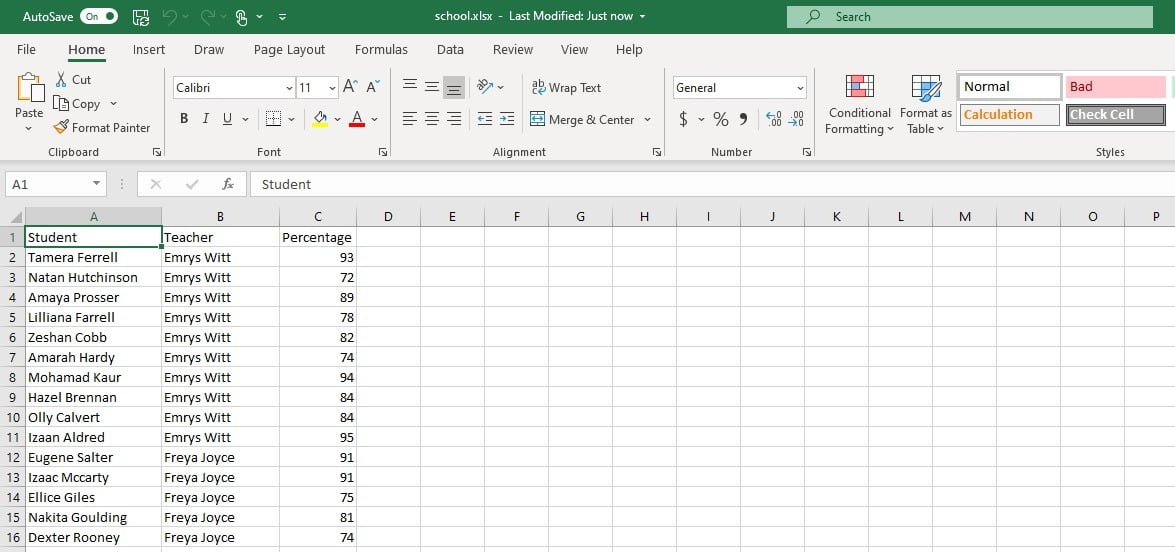
This datapoint plugin is really fantastic and it matches our business needs. Is it possible anyone from your team contact me for further discussion including commerical, collaboration?
Perfect. You have a mail in your mailbox already!
This looks great. Could this pull multiple data points from Excel and populate a powerpoint template? Could your team reach out please.
Submit a Comment
Your email address will not be published. Required fields are marked *
Pin It on Pinterest
- StumbleUpon
- Print Friendly

- Privacy Overview
- Strictly Necessary Cookies
This website uses cookies so that we can provide you with the best user experience possible. Cookie information is stored in your browser and performs functions such as recognising you when you return to our website and helping our team to understand which sections of the website you find most interesting and useful.
Strictly Necessary Cookie should be enabled at all times so that we can save your preferences for cookie settings.
If you disable this cookie, we will not be able to save your preferences. This means that every time you visit this website you will need to enable or disable cookies again.
How-To Geek
How to link or embed an excel worksheet in a powerpoint presentation.

Your changes have been saved
Email is sent
Email has already been sent
Please verify your email address.
You’ve reached your account maximum for followed topics.
Quick Links
What's the difference between linking and embedding, how to link or embed an excel worksheet in microsoft powerpoint.
Sometimes, you want to include the data on an Excel spreadsheet in a Microsoft PowerPoint presentation. There are a couple of ways to do this, depending on whether or not you want to maintain a connection with the source Excel sheet. Let's take a look.
You actually have three options for including a spreadsheet in a PowerPoint presentation. The first is by simply copying that data from the spreadsheet, and then pasting it into the target document. This works okay, but all it really does is convert the data to a simple table in PowerPoint. You can use PowerPoint's basic table formatting tools on it, but you can't use any of Excel's features after the conversion.
While that can be useful sometimes, your other two options---linking and embedding---are much more powerful, and are what we're going to show you how to do in this article. Both are pretty similar, in that you end up inserting an actual Excel spreadsheet in your target presentation. It will look like an Excel sheet, and you can use Excel's tools to manipulate it. The difference comes in how these two options treat their connection to that original Excel spreadsheet:
- If you link an Excel worksheet in a presentation, the target presentation and the original Excel sheet maintain a connection. If you update the Excel file, those updates get automatically reflected in the target presentation.
- If you embed an Excel worksheet in a presentation, that connection is broken. Updating the original Excel sheet does not automatically update the data in the target presentation.
There are advantages to both methods, of course. One advantage of linking a document (other than maintaining the connection) is that it keeps your PowerPoint presentation's file size down, because the data is mostly still stored in the Excel sheet and only displayed in PowerPoint. One disadvantage is that the original spreadsheet file needs to stay in the same location. If it doesn't, you'll have to link it again. And since it relies on the link to the original spreadsheet, it's not so useful if you need to distribute the presentation to people who don't have access to that location.
Embedding that data, on the other hand, increases the size of presentation, because all that Excel data is actually embedded into the PowerPoint file. There are some distinct advantages to embedding, though. For example, if you're distributing that presentation to people who might not have access to the original Excel sheet, or if the presentation needs to show that Excel sheet at a specific point in time (rather than getting updated), embedding (and breaking the connection to the original sheet) makes more sense.
So, with all that in mind, let's take a look at how to link and embed an Excel Sheet in Microsoft PowerPoint.
Linking or embedding an Excel worksheet into a PowerPoint presentation is actually pretty straightforward, and the process for doing either is almost identical. Start by opening both the Excel worksheet and the PowerPoint presentation you want to edit at the same time.
In Excel, select the cells you want to link or embed. If you would like to link or embed the entire worksheet, click on the box at the juncture of the rows and columns in the top left-hand corner to select the whole sheet.
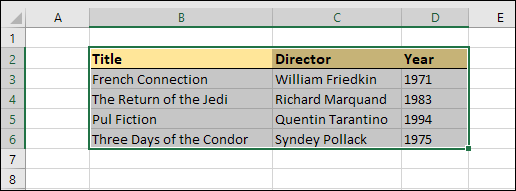
Copy those cells by pressing CTRL+C in Windows or Command+C in macOS. You can also right-click any selected cell, and then choose the "Copy" option on the context menu.

Now, switch to your PowerPoint presentation and click to place the insertion point where you would like the linked or embedded material to go. On Home tab of the Ribbon, click the down arrow beneath the "Paste" button, and then choose the "Paste Special" command from the dropdown menu.
This opens the Paste Special window. And it's here where you'll find the only functional different in the processes of linking or embedding a file.
If you want to embed your spreadsheet, choose the "Paste" option over on the left. If you want to link your spreadsheet, choose the "Paste Link" option instead. Seriously, that's it. This process is otherwise identical.
Whichever option you choose, you'll next select the "Microsoft Excel Worksheet Object" in the box to the right, and then click the "OK" button.
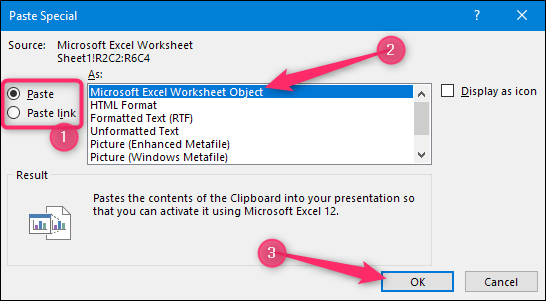
And you'll see your Excel sheet (or the cells you selected) in your PowerPoint presentation.
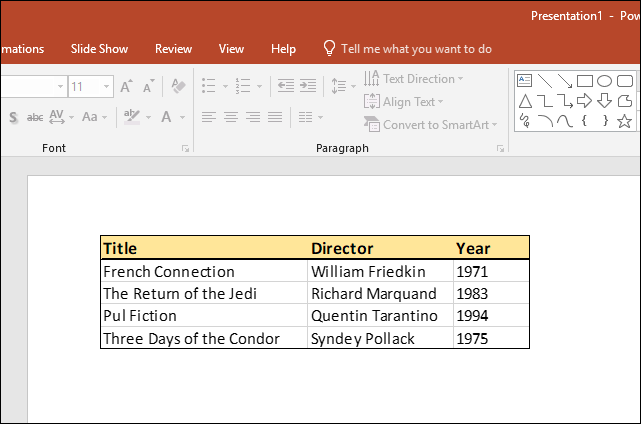
If you linked the Excel data, you can't edit it directly in PowerPoint, but you can double-click anywhere on it to open the original spreadsheet file. And any updates you make to that original spreadsheet are then reflected in your PowerPoint presentation.
If you embedded the Excel data, you can edit it directly in PowerPoint. Double-click anywhere in the spreadsheet and you'll stay in the same PowerPoint window, but the PowerPoint Ribbon gets replaced by the Excel Ribbon and you can access all the Excel functionality. It's kind of cool.
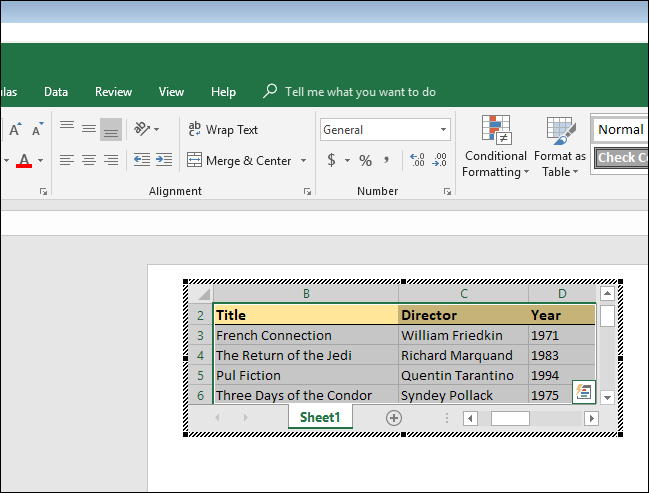
And when you want to stop editing the spreadsheet and go back to your PowerPoint controls, just click anywhere outside the spreadsheet.
- Microsoft Office
- Microsoft Excel

How to Embed an Excel File in PowerPoint (5 Easy Ways)
Here’s an overview of how data will be presented from Excel into PowerPoint.
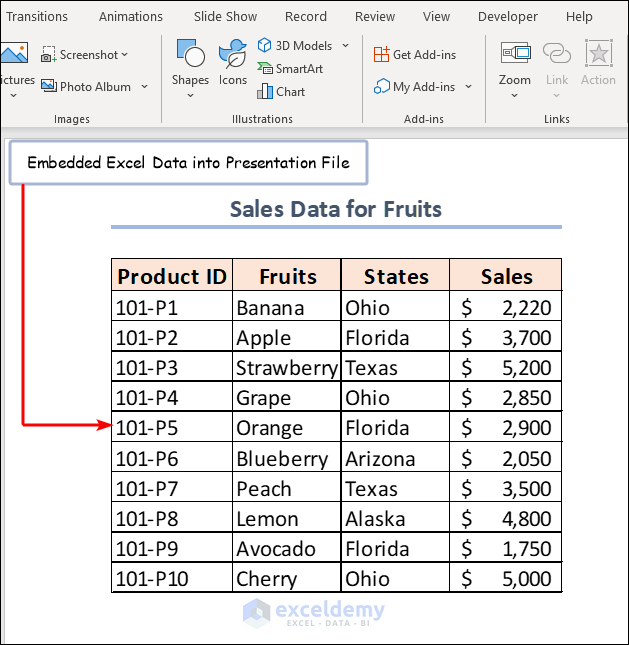
How to Embed an Excel File in PowerPoint: 5 Suitable Examples
Let’s assume we have a “ Sales Data for Fruits ” dataset, which includes the Product ID , Fruits , States , and Sales amount under columns B , C , D , and E respectively.

Method 1 – Embedding an Entire Excel File in PowerPoint
- Select the Insert tab on the Ribbon in PowerPoint.
- Click on the Object command on the Text group of commands.
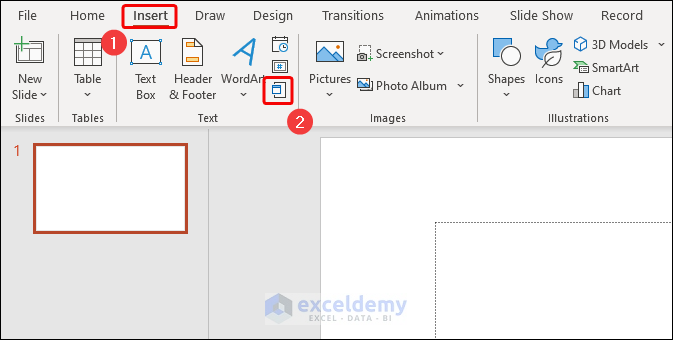
- In the Insert Object dialog box, click on the radio button of Create from file option.
- Choose the Browse… button.
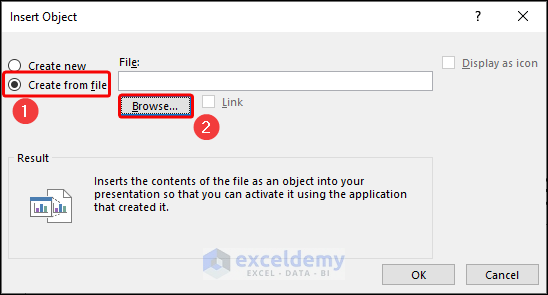
- In the Browse window, select your desired file and click OK .
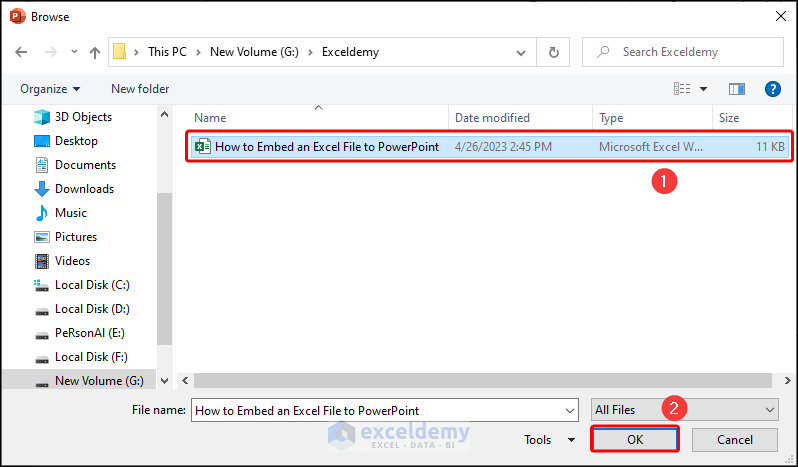
- You can see your file path and name in the highlighted box. Click OK .
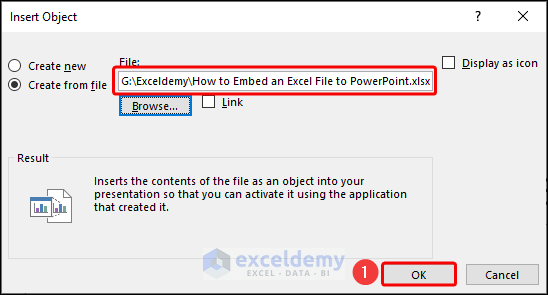
Note: Don’t check the box before the Link option to embed the Excel file .
Make sure to attach your intended data on the first page of the Excel file.
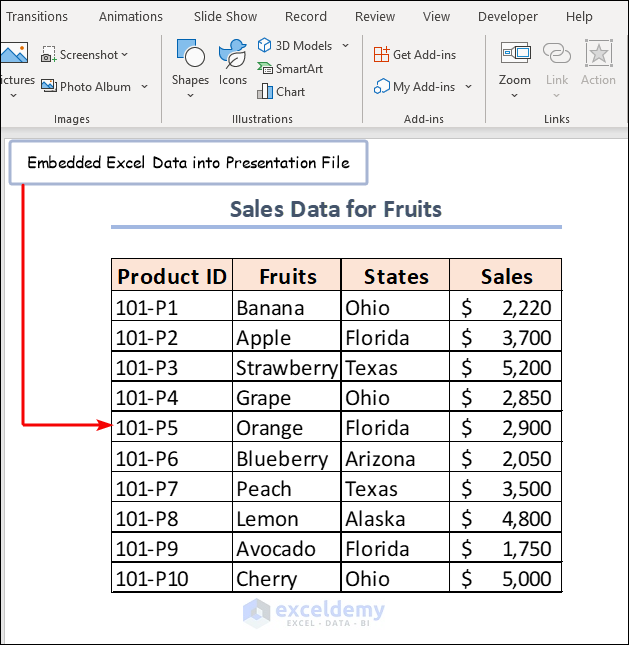
Read More: How to Perform Excel to PowerPoint Automation
Method 2 – Embedding a Section of Excel Data in PowerPoint File
- Open the Excel file and select the range of data (e.g. C4:E14 ) you want to embed.
- Press CTRL + C on your keyboard to copy this range.
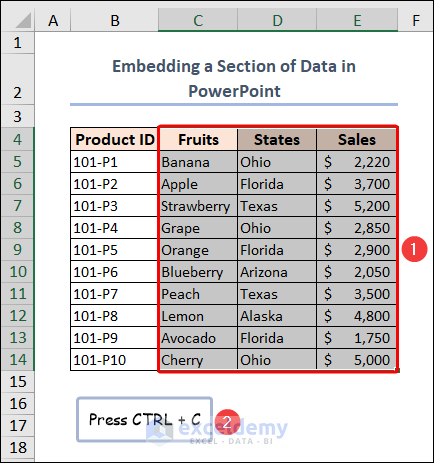
- Open your PowerPoint slide and navigate to the Home tab.
- Click on the Paste drop-down option and then click on Paste Special .
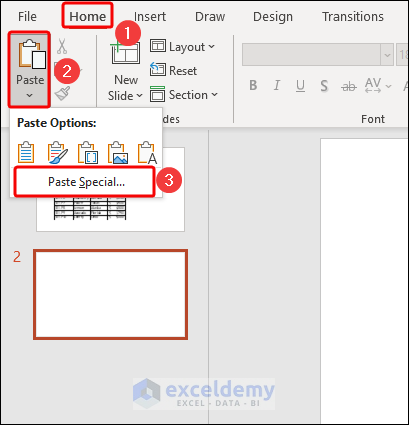
- Select Paste and click on Microsoft Excel Worksheet Object . Press OK .
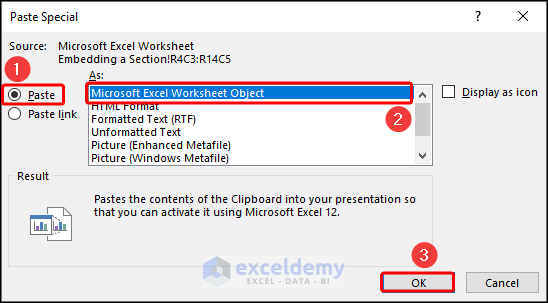
- The selected range is copied to the presentation file.
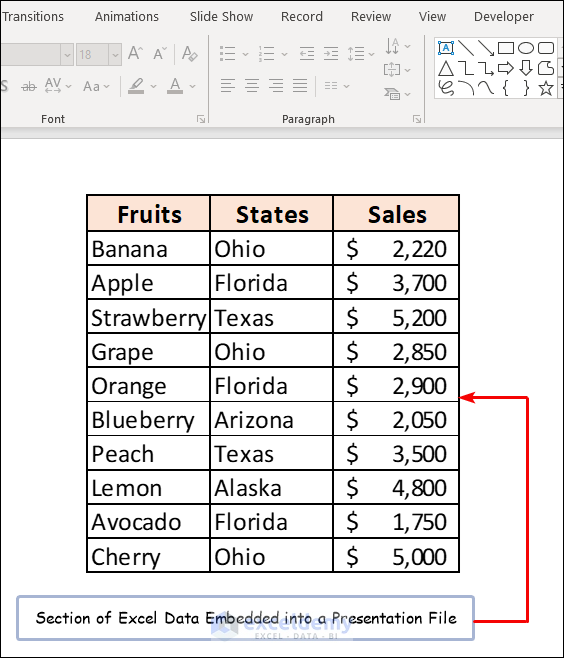
Method 3 – Utilizing Embed Command to Add Unlinked Excel File
- Select the dataset (e.g. B4:E14 ) and right-click.
- Click on the Copy command from the context menu.
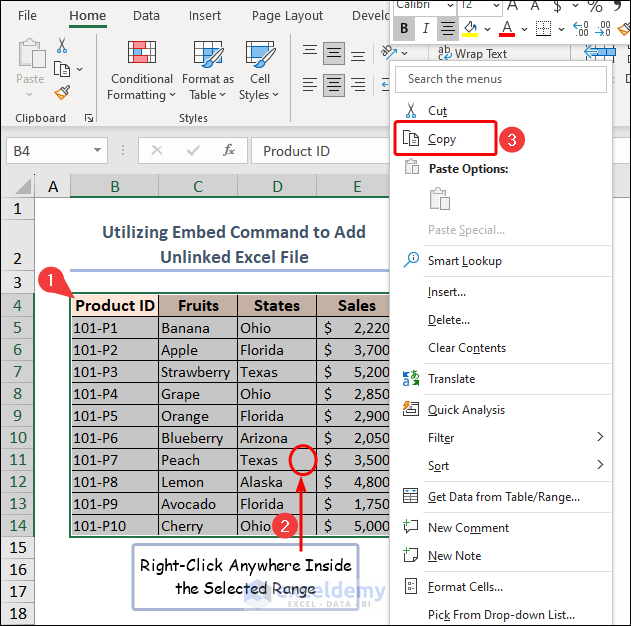
- Use the Paste drop-down option in PowerPoint.
- Choose Embed (E) from Paste Options .
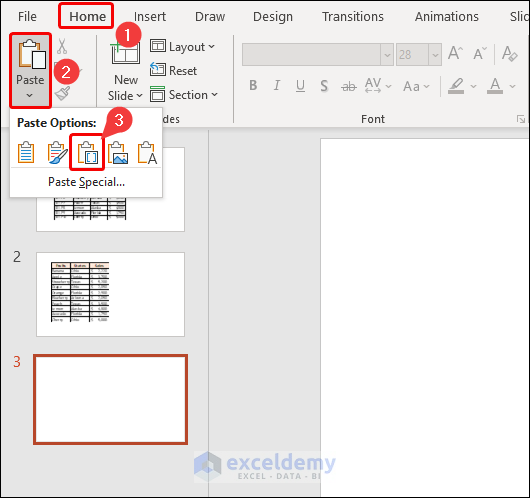
- The output in PowerPoint is as follows.
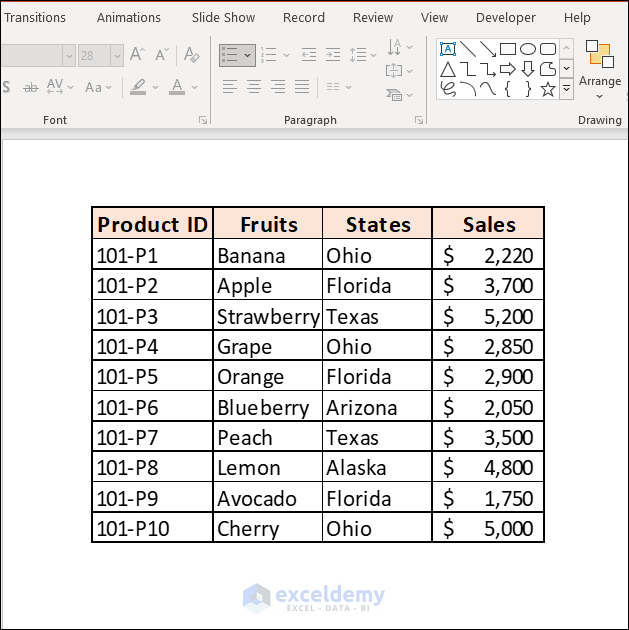
Method 4 – Applying Camera Gadget Tool to Embed Data as Image
- Click on the triangular-shaped Customize Quick Access Toolbar icon and select More Commands .
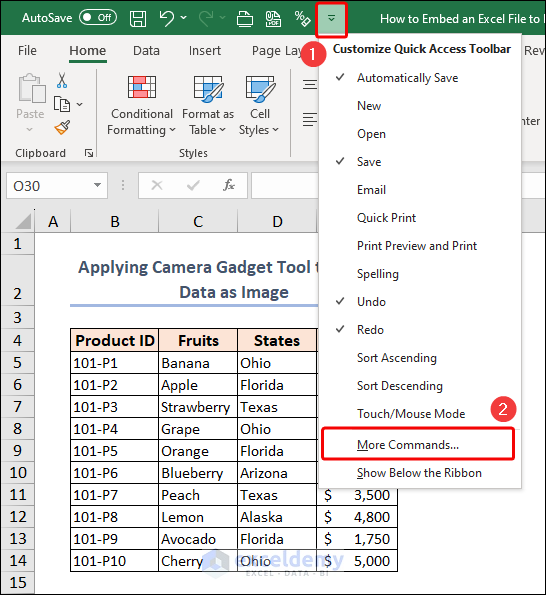
- This will bring a dialog box as follows. Click on the drop-down icon beside the Popular Command bar to get more options. Then pick Commands Not in the Ribbon from the available options.
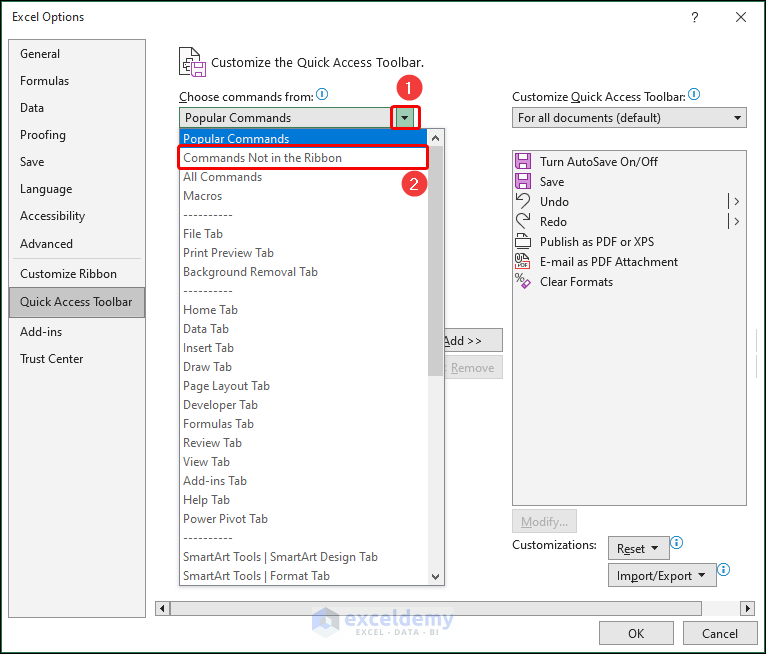
- To bring the Camera tool to the right side, select Camera and click the Add button in the middle.
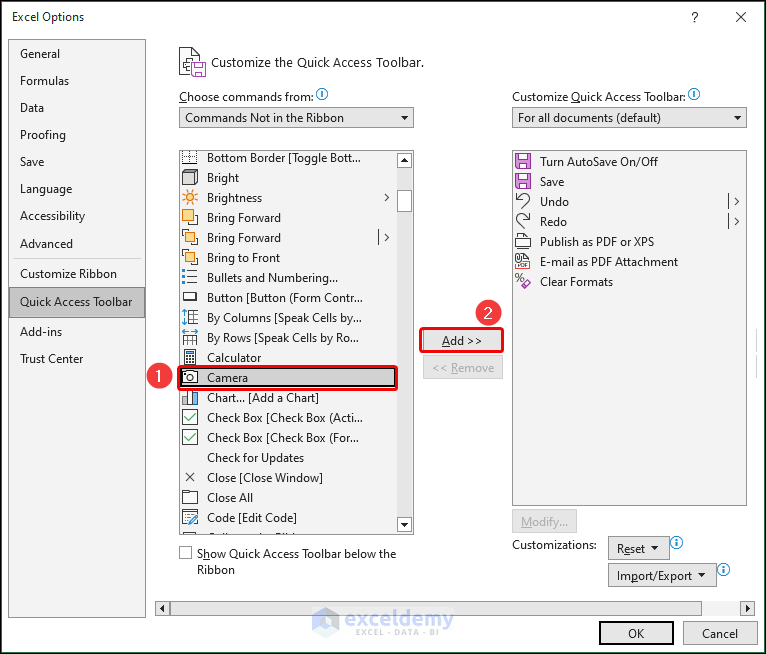
- This will allow you to have a Camera icon in the Toolbar . Now you’re ready to take snaps of the selected area by using the Camera tool.
- Select the region you want to copy and press the Camera icon.
- Left click anywhere to get an image.
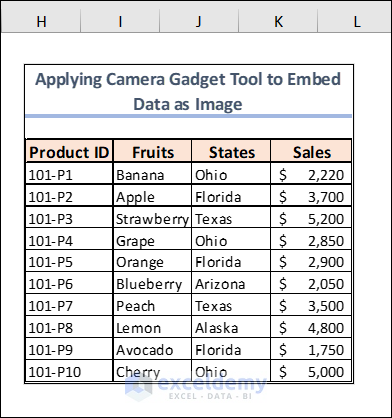
- Copy the image by selecting it and pressing Ctrl + C command.
- Paste the output in the presentation slide as follows:
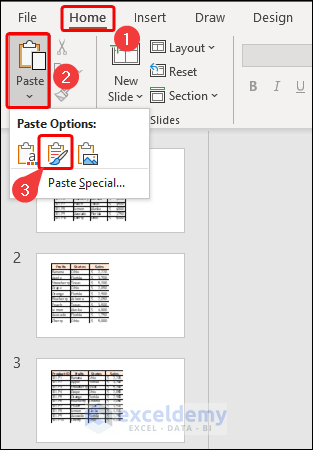
- Remember that the embedded portion is an image.
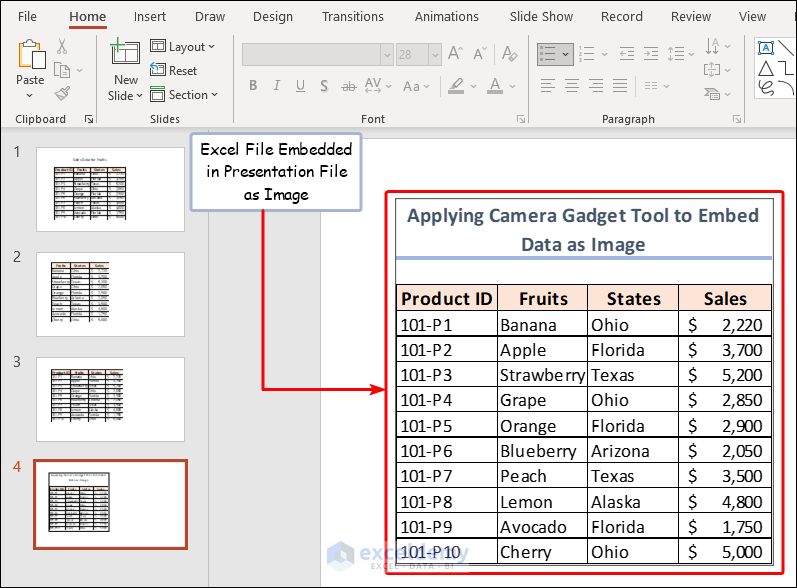
Read More: How to Link Excel Data to PowerPoint Chart
Method 5 – Embedding an Excel Chart in PowerPoint File
Charts are perhaps the most commonly-used Excel format in PowerPoint.
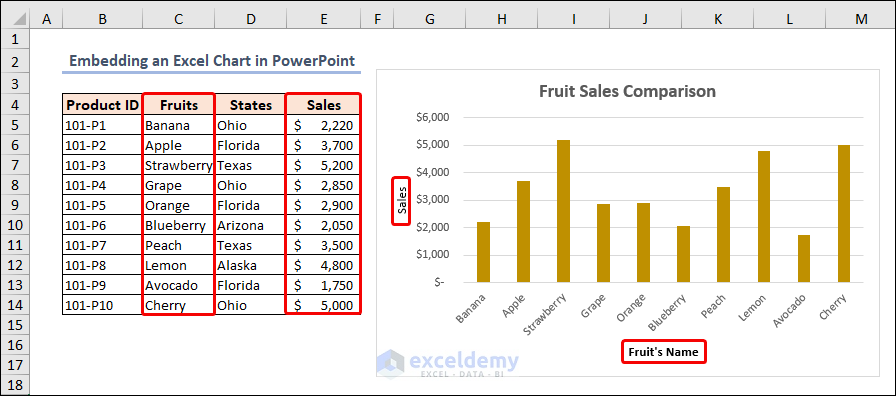
- Copy the Excel chart with Ctrl+ C command.
- Paste the chart into the PowerPoint slide by using Keep Source Formatting & Embed Workbook , one of the Paste Options .
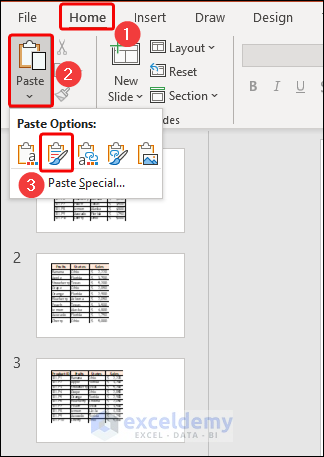
Finally, the output in the presentation slide is as follows:
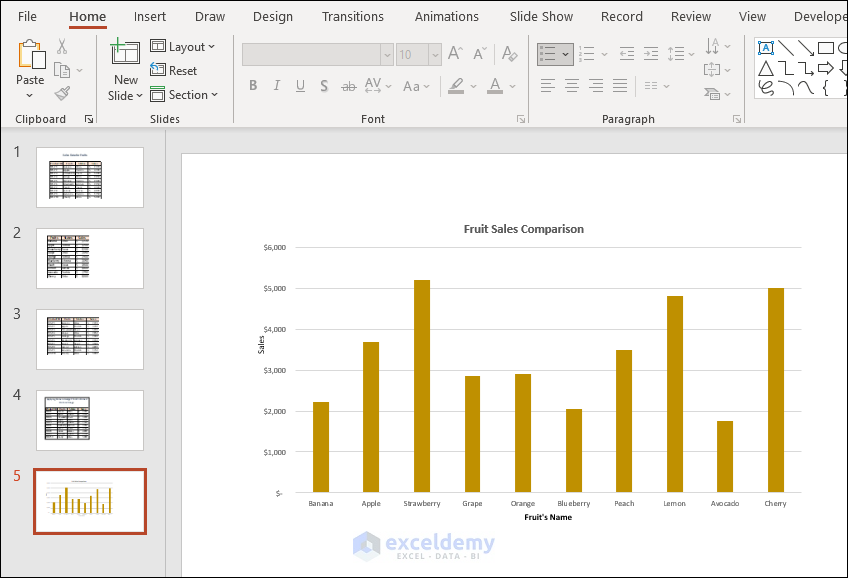
Embed Vs. Link an Excel File in PowerPoint
When you want to add an Excel file to a PowerPoint presentation, you have two options: embedding or linking the file. Here’s a brief overview of the differences between the two:
- Embedding an Excel file in PowerPoint means that a copy of the file is saved within the PowerPoint presentation itself. This can make your presentation larger in file size, but it also means that you don’t need the original Excel file to view or present the data. Any changes made to the original Excel file won’t be reflected in the embedded copy within PowerPoint.
- Linking an Excel file to PowerPoint means that the presentation will display data from the original Excel file. This keeps the file size of the presentation smaller and ensures that any changes made to the Excel file are reflected in the PowerPoint presentation. However, if the Excel file is moved or deleted, the links will be broken and the data won’t display correctly in the presentation.
Read More: How to Link Excel Sheets to PowerPoint
How to Insert Excel File into PowerPoint as Icon
- Open a presentation file and select the intended slide to place the icon.
- Go to the Insert tab and click on the Object tool in the Text group.
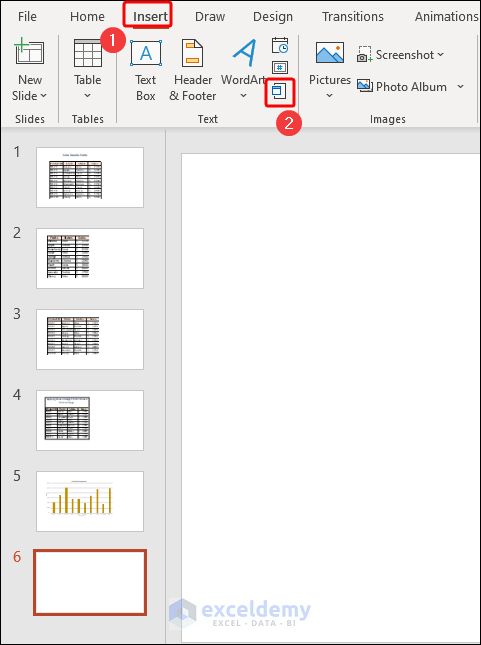
- Select the Create from file option.
- Click on the Browse button to attach the Excel file that you want to place as an icon on the slide.
- Make sure to check the boxes beside Link and Display as icon options.
- Use the hooks on the icon’s corners to resize it and drag it into place on the slide.
- Double-click the icon to access the workbook’s contents and edit them.
Read More: How to Insert an Excel File into PowerPoint as an Icon
How to Link Excel File in PowerPoint That Updates Data Dynamically
- To link an Excel file in PowerPoint, do the same things as you did in Example 1 .
- You have to mark the box before the Link option.
- Press the OK button.
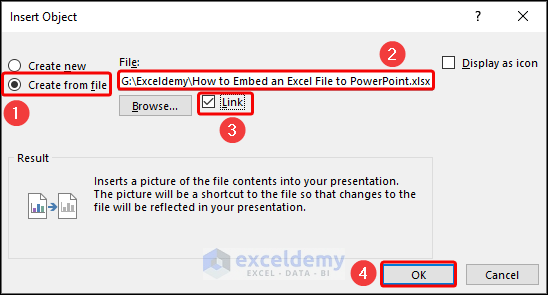
Now, if you make any changes in the Excel file, you’ll get the updated data in PowerPoint.
Note: If you delete the file or change the location of the file, PowerPoint will start throwing errors when trying to display data.
Read More: How to Link Powerpoint to Excel for Dynamic Data Updates
Benefits and Drawbacks of Embedding an Excel File in PowerPoint
When creating presentations, it’s useful to embed the Excel file directly into the PowerPoint file. But, it’s important to consider the benefits and drawbacks of this approach.
- Easy Access to Data: Embedding an Excel file in PowerPoint allows you to easily access and manipulate data without having to switch between programs.
- Increased Interactivity: Embedding an Excel file in PowerPoint allows you to create more interactive presentations with live data that can be manipulated and updated in real time.
- Saves Time: It can save time by eliminating the need to create separate charts and graphs from scratch.
- Better Organization: Embedding an Excel file in PowerPoint allows you to keep all your data in one place, making it easier to organize and manage your presentation.
- Consistent Formatting: Embedding ensures that your data will be presented with consistent formatting and style.
- File Size: Embedding an Excel file in PowerPoint can increase the file size of your presentation, making it more difficult to share and collaborate with others.
- Compatibility Issues: Embedding an Excel file in PowerPoint can lead to compatibility issues between different versions of PowerPoint and Excel.
- Security Risks: Embedding an Excel file in PowerPoint can pose security risks if the Excel file contains sensitive information.
- Limited Editing Capabilities: Embedding an Excel file in PowerPoint limits your editing capabilities, as you may not be able to make changes to the data directly within the PowerPoint slide.
- Refreshing Data: If the data in the embedded Excel file changes, you will need to manually refresh the data in the PowerPoint slide to ensure accuracy.
Things to Remember
- Keep file size in mind when you embed an Excel file in PowerPoint.
- Ensure compatibility with different versions of PowerPoint and Excel.
- Test your presentation to ensure that the embedded Excel file displays correctly.
- Update the presentation file with an embedded Excel file if the data changes or needs to be refreshed.
- Consider security and privacy concerns when embedding Excel files containing sensitive information.
Frequently Asked Questions
1. Will embedding an Excel file in PowerPoint increase the file size of my presentation?
Yes, it can increase, especially if the Excel file contains a lot of data. This can make it more difficult to share and collaborate on the presentation.
2. How do I ensure compatibility between different versions of PowerPoint and Excel when embedding a file?
To ensure compatibility, it’s important to save the Excel file in a format that is compatible with the version of PowerPoint you are using.
3. What security risks should I be aware of when embedding an Excel file in PowerPoint?
It’s important to ensure that any sensitive information within the embedded Excel file is appropriately protected and access is limited to authorized individuals.
Practice Section
We have provided a practice section on the right side of each sheet so you can practice yourself. Please make sure to do it yourself.
Download Practice Files
Download the following practice workbook and presentation file. It will help you to realize the topic more clearly and will help you practice yourself.
Related Articles
- [Fixed!] Problems with Embedded Excel Files in PowerPoint
- [Solved] Embedded Excel in PowerPoint Not Showing All Data
- How to Open Existing PowerPoint File from Excel VBA
<< Go Back to Excel to PowerPoint | Export Data from Excel | Learn Excel
What is ExcelDemy?
Tags: Excel to PowerPoint

Mohammad Shah Miran has a professional background spanning over a year at Softeko. Initially starting as an Excel and VBA writer, he authored more than 50 articles for the ExcelDemy project. Currently, Miran is engaged in the LinuxSimply project as a Linux content developer, completed over 40 articles. His analytical approach extends across various domains, including Excel, VBA, Bash scripting, Linux, data analysis, and Python programming. In his leisure time, Miran enjoys watching movies and series or listening... Read Full Bio
Leave a reply Cancel reply
ExcelDemy is a place where you can learn Excel, and get solutions to your Excel & Excel VBA-related problems, Data Analysis with Excel, etc. We provide tips, how to guide, provide online training, and also provide Excel solutions to your business problems.
Contact | Privacy Policy | TOS
- User Reviews
- List of Services
- Service Pricing

- Create Basic Excel Pivot Tables
- Excel Formulas and Functions
- Excel Charts and SmartArt Graphics
- Advanced Excel Training
- Data Analysis Excel for Beginners

Advanced Excel Exercises with Solutions PDF

- Arts, Design & Media
- Career Exploration
- Government, Policy & Social Impact
- Graduate Business (MBA & SMP)
- Health Care & Sciences
- Technology, Data & Engineering
- Career Assessments
- Career & Major Exploration
- Resumes, Cover Letters & Application Materials
- Graduate & Professional School Preparation
- Job & Internship Search Strategies
- Negotiation & Offer Evaluation
- Professional Conduct
- Bear Treks – Explore Industries
- Chancellor’s Career Fellows Program
- Pershing Fellowship in Non-Profit Leadership
- Stipends for Unpaid Summer Internships
- Schedule a Career Coaching Appointment
- Faculty & Staff
- Attend an Event
- Engage with Students
- Post a Position
- Hiring International Talent
- International Employer Resources in Asia
- Recruiting Calendar
- Recruitment and Offer Policy
- Visiting the Center for Career Engagement
- Hire WashU: Annual Employer Forum
- Career Outcomes
- Center for Career Engagement Leadership
- Academic Partnerships Team
- Career Development Team
- Employer Engagement Team
- Events, Operations & Programs Team
- Student Career Peer Team

Excel and PowerPoint: Creating High-Impact Financial Presentations
- Share This: Share Excel and PowerPoint: Creating High-Impact Financial Presentations on Facebook Share Excel and PowerPoint: Creating High-Impact Financial Presentations on LinkedIn Share Excel and PowerPoint: Creating High-Impact Financial Presentations on X
Instructor: Danielle Stein Fairhurst
Find out how you can create high-impact, data-rich financial presentations using Excel and PowerPoint. In this course, Microsoft MVP and Financial Modelling Specialist Danielle Stein Fairhurst guides you through creating financial presentations that are compelling, easy to understand, and—best of all—easy to update. Get started with an example spreadsheet featuring typical finance data. Learn how to use conditional formatting to highlight important information, PivotTables to summarize data, and sparklines and charts to create illustrations. Explore several different methods—including copying and pasting, linking, and embedding—to import your work into PowerPoint. Plus, learn how to use PowerPoint animation features to animate Excel charts and tables and focus the viewer’s attention.

copilot_2408_commercial_ongoing
Image header .

August edition: Copilot for Microsoft 365 updates
Copilot continues to provide ways for you to get your work done with less effort and frustration. This month, we'll tell you how you can do a Bing search directly in Word, how you can query in Copilot for specific time periods, and how you can query to get the details you need about a PowerPoint presentation. We also have news about improvements we've made in response to your requests: How you can create PowerPoint presentations just by referencing a Word doc, and that Copilot can analyze Excel data that has been set free from tables.
Announcement
Prompts we think you’ll love .
|
“Summarize messages from my manager in the last 48 hours.”
|
“Provide a comprehensive summary of my emails about /[the FY24 Sales Report]”
|
Improve your Microsoft Copilot skills
| Create a presentation with a prompt | Chat about a Word file |
Try these new Copilot features
Search bing directly in word to draft a plan based on internal and internet resources .

Do you want to search for important information without having to leave Word? Ask Copilot a question in Word chat and Copilot will answer using integrated Bing search.
Ask Copilot, "Who are the board of directors for Microsoft?"
Try in Word
Ask specific questions about PowerPoint presentations to reduce information overload

Do you want to get to the substance of a PowerPoint presentation without scrolling through each slide? You can now ask Copilot in PowerPoint to summarize a presentation or answer specific questions about it.
Ask Copilot, "What is the goal of this project?" or "Summarize slide 5."
Try in PowerPoint
Query about a specific time period to get more precise information

Do you want information from a specific time period, like yesterday, last month, or last year? Copilot can now identify any time period and respond to your request with the information you want.
Ask Copilot, "Summarize all chats with [team member] from last October."
Try in Copilot
Improvements based on your feedback
Reference a word document to create a marketing presentation without needing to copy links to the document .
Want to get a quick start with a PowerPoint presentation? Simply reference a Word doc as your source in Copilot for PowerPoint and let Copilot do the rest.
Ask Copilot, "Create a presentation from /[document]."
Reason over business data, survey results or project progress in Excel without a table

Until now, you needed to organize your Excel data in tables before Copilot could reason over it. Now Copilot can reason over data ranges with only a single row of headers on top.
Try in Excel
Helpful resources
You can keep learning on our Copilot website , where you'll find videos, how-tos, tips, and links to try it out. You can also discover how to communicate effectively with Copilot using prompts.
Transform your workflows with expert guidance about how to use Copilot for specific scenarios in the Microsoft Copilot Scenario Library .
If you want to see what you missed in past months, check out the updates history .
Take the power of AI on the go! Download the Microsoft Copilot mobile app and sign in with your work account today.
Some features highlighted here may not be available for the Microsoft 365 suite you're using.
Some Microsoft 365 and Office 365 suites in the European Economic Area and Switzerland do not include Microsoft Teams. Learn more on our licensing page
This email is generated from an unmonitored alias. Please do not reply.
Unsubscribe
Privacy Statement
Microsoft Corporation, One Microsoft Way, Redmond, WA 98052 USA

Need more help?
Want more options.
Explore subscription benefits, browse training courses, learn how to secure your device, and more.

Microsoft 365 subscription benefits

Microsoft 365 training

Microsoft security

Accessibility center
Communities help you ask and answer questions, give feedback, and hear from experts with rich knowledge.

Ask the Microsoft Community

Microsoft Tech Community

Windows Insiders
Microsoft 365 Insiders
Was this information helpful?
Thank you for your feedback.

IMAGES
COMMENTS
To generate a presentation from an Excel (XLS) file using SlideSpeak, you need to perform the following steps: Select the Excel file: select the file based on which you want to create a presentation. Upload the file: upload the file to SlideSpeak. Preview data: preview the uploaded data in SlideSpeak.
6. Add an image. Whether it's a photograph, an artistic sketch or your logo, images go a long way in making your spreadsheet better. Images make your presentation look official and possess the professional feel in many of the beautiful presentations you have seen. Pictures speak a thousand words.
Method 2 - Use Paste Special to Generate Slides from Excel. STEPS: Open Excel's saved worksheet to insert data. Select the dataset you want to copy. Click on Copy or press Ctrl + C. Open PowerPoint and click on the slide where you wish to connect the Excel data. Click Paste or right-click and select Paste Special. A new dialog box appears.
Excel is not just for spreadsheets; its powerful data manipulation capabilities make it an excellent tool for creating presentations, especially when dealing with large datasets or when you need to display data-driven insights dynamically. This guide provides 15 detailed steps to help you turn Excel data into compelling presentations effectively.
Creating a presentation in Excel. Step 1: Choose a Template. Step 2: Create slides. Step 3: Organize your data. Line Graph. Pie chart. Table. Step 4: Remove the grids. Tips for making a creative and professional presentation using Excel.
To create PowerPoint slides, from a list in Excel, follow these steps: Open the Excel file where your list is stored. Activate the sheet where the data is stored - the list must be formatted as a named Excel table. Open the PowerPoint presentation that contains the macros and main slide. Be sure the main slide, that you want to duplicate, is ...
Build your charts in Excel. 2. Create a new worksheet and paste in all the charts you need for the presentation. 3. Open VBA. To do this, you can either press ALT + F11, or you can take the following steps: a. To show the developer tab, click on the Microsoft Office Button and click Excel Options. ... In the code, look for the section - 'Make a ...
To create a pie chart in Excel: Select the data you want to visualize. From the " Insert " tab, choose " Pie " from the chart options. You can customize your chart by changing the colors, adding labels, and adjusting other settings in the " Format Chart Area " pane. Here's a video guide on how to create a donut chart:
For the best presentations, use only the data on Excel, and do the formatting in your PowerPoint presentation. You can export from Excel to PowerPoint as images, or better reproduce charts and tables in PowerPoint. ... Make sure the presentation is set to loop forever since it will be displayed on a screen. Then click Set up Slide Show in Slide ...
Learn how to create high-impact, data-rich presentations using PowerPoint and Excel together. Follow along with Gini von Courter as she shows how to create presentations that are easy to use, easy ...
To create PowerPoint slides, from a list in Excel, follow these steps: Open the Excel file. Activate the sheet where the data is stored in a named Excel table. Open the PowerPoint presentation with the macros and main slide. Be sure the main slide, that you want to duplicate, is the first slide in the presentation.
YOU CAN DOWNLOAD ALL MY FILES FOR FREE AT http://www.theexcelchallenge.comLearn how to create a spreadsheet that you can navigate through the same way you do...
Here is a recording of a webinar by Kurt Dupont, showing how to automatically create PowerPoint slides from Excel using the DataPoint PowerPoint add-on.Conta...
Automatically Create PowerPoint Slides from Excel. Mar 29, 2021 | DataPoint, DataPoint Automation, Evergreen, Merge. Here is a recording of a webinar by Kurt Dupont, showing how to automatically create PowerPoint slides from Excel using the DataPoint PowerPoint add-on. DataPoint Bridge.
Let's discuss some Excel presentation tips that will help you present data in a compelling and visually appealing format. 1. Charts and Graphs. Effectively providing a visual summary of data using graphs and charts is an important presentation technique. But it's just as easy to make a confusing chart as it is to make a helpful one.
Automating PowerPoint Creates an Up-To-Date Presentation. The first benefit here is that we have linked our PowerPoint shapes to Excel data. We can save this presentation and when we open it again after a week, then it will refresh the content of your shapes with the new or updated data that might have been entered in the Excel file.
In Excel, select the cells you want to link or embed. If you would like to link or embed the entire worksheet, click on the box at the juncture of the rows and columns in the top left-hand corner to select the whole sheet. Copy those cells by pressing CTRL+C in Windows or Command+C in macOS.
The good news is that putting together a presentation that tells the story of your data is much easier than you think. This webinar focuses on the efficient presentation of your Excel data in a PowerPoint presentation. You'll discover how to format and extract key insights from your Excel data and then design effective charts and graphs to ...
Method 1 - Embedding an Entire Excel File in PowerPoint. Select the Insert tab on the Ribbon in PowerPoint. Click on the Object command on the Text group of commands. In the Insert Object dialog box, click on the radio button of Create from file option. Choose the Browse… button.
In PowerPoint, on the Insert tab, click or tap Object. In the Insert Object dialog box, select Create from file. Click or tap Browse, and in the Browse box, find the Excel workbook with the data you want to insert and link to. Before you close the Insert Object box, select Link, and click OK. Important: The linked object in your presentation ...
This is the presentation tips for all office operator to create amazing presentation on excel data by using PowerPoint slides so if you are ms-office users t...
In Excel, click and drag to highlight the cells you want to copy. Right-click the copied cells and select Copy. In your PowerPoint presentation, right-click and select the Paste Options you want: Use Destination Styles - Choose to edit your copied cells like a PowerPoint table, but with PowerPoint's color scheme and fonts.
Here are two methods to get the Excel data into the graph table in PowerPoint. Method 1: Paste Values. The simplest method is to select the cells in Excel, copy them, and paste them into the graph table in PowerPoint. If you use the default Paste, you may run into trouble if the source cell in Excel contains a formula (which is quite common).
Find out how you can create high-impact, data-rich financial presentations using Excel and PowerPoint. In this course, Microsoft MVP and Financial Modelling Specialist Danielle Stein Fairhurst guides you through creating financial presentations that are compelling, easy to understand, and—best of all—easy to update.
Ask Copilot, "Create a presentation from /[document]." Try in Word. Reason over business data, survey results or project progress in Excel without a table Until now, you needed to organize your Excel data in tables before Copilot could reason over it. Now Copilot can reason over data ranges with only a single row of headers on top. Try in Excel
The USA men's basketball team on Saturday won its fifth straight Olympic gold medal, defeating a spirited French team 98-87.. Behind Stephen Curry's 24 points, the Americans finally put away ...